Rural-Urban Migration: Case Study of Empty Houses in Bhutan
VerifiedAdded on 2023/04/08
|37
|9489
|175
AI Summary
This research study analyzes the issue of the increase in the number of empty houses in Bhutan and its implications. It explores the reasons for this trend and its impact on the government and society of Bhutan. The study provides recommendations to address this issue. Subject: Rural-Urban Migration, Course Code: N/A, Course Name: N/A, College/University: N/A
Contribute Materials
Your contribution can guide someone’s learning journey. Share your
documents today.
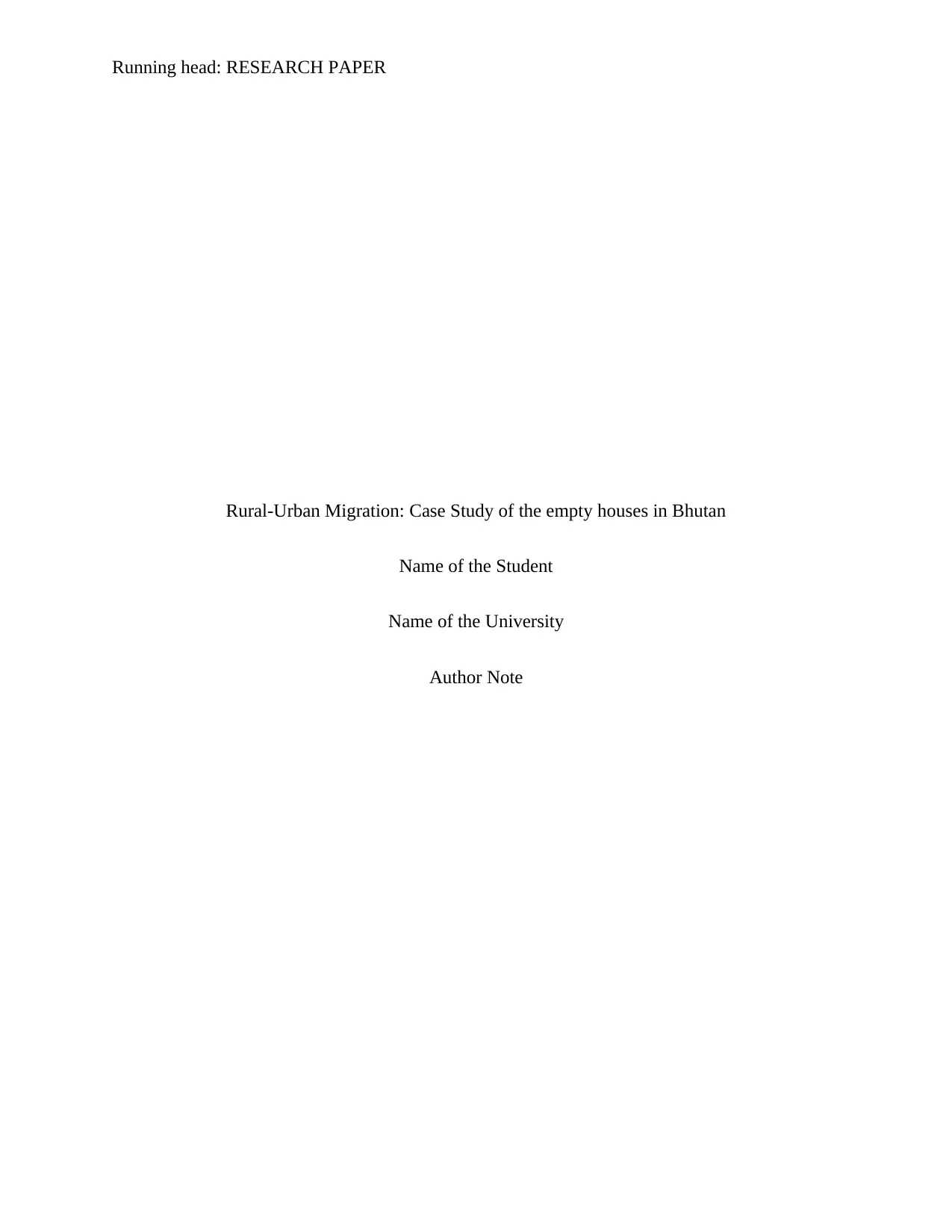
Running head: RESEARCH PAPER
Rural-Urban Migration: Case Study of the empty houses in Bhutan
Name of the Student
Name of the University
Author Note
Rural-Urban Migration: Case Study of the empty houses in Bhutan
Name of the Student
Name of the University
Author Note
Secure Best Marks with AI Grader
Need help grading? Try our AI Grader for instant feedback on your assignments.
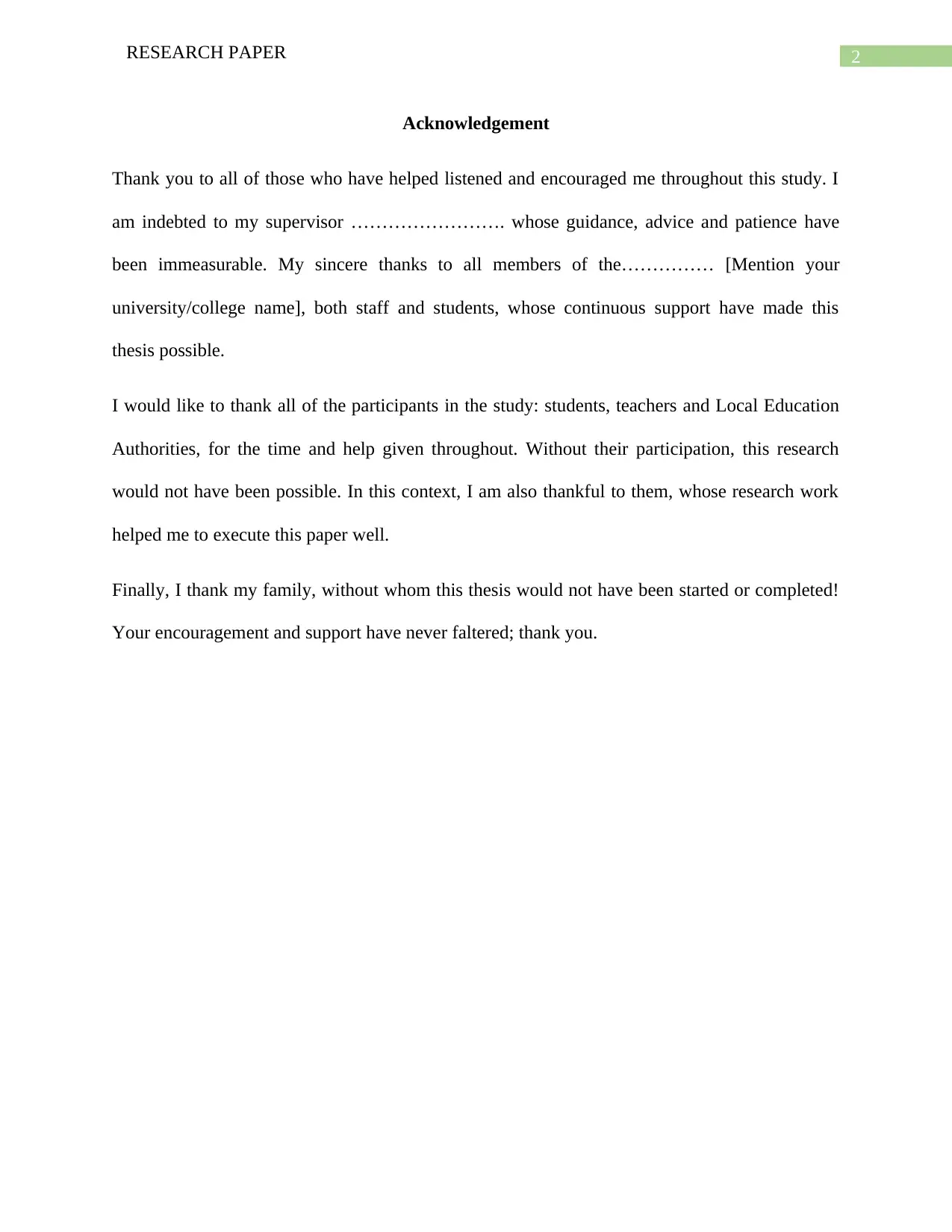
2RESEARCH PAPER
Acknowledgement
Thank you to all of those who have helped listened and encouraged me throughout this study. I
am indebted to my supervisor ……………………. whose guidance, advice and patience have
been immeasurable. My sincere thanks to all members of the…………… [Mention your
university/college name], both staff and students, whose continuous support have made this
thesis possible.
I would like to thank all of the participants in the study: students, teachers and Local Education
Authorities, for the time and help given throughout. Without their participation, this research
would not have been possible. In this context, I am also thankful to them, whose research work
helped me to execute this paper well.
Finally, I thank my family, without whom this thesis would not have been started or completed!
Your encouragement and support have never faltered; thank you.
Acknowledgement
Thank you to all of those who have helped listened and encouraged me throughout this study. I
am indebted to my supervisor ……………………. whose guidance, advice and patience have
been immeasurable. My sincere thanks to all members of the…………… [Mention your
university/college name], both staff and students, whose continuous support have made this
thesis possible.
I would like to thank all of the participants in the study: students, teachers and Local Education
Authorities, for the time and help given throughout. Without their participation, this research
would not have been possible. In this context, I am also thankful to them, whose research work
helped me to execute this paper well.
Finally, I thank my family, without whom this thesis would not have been started or completed!
Your encouragement and support have never faltered; thank you.
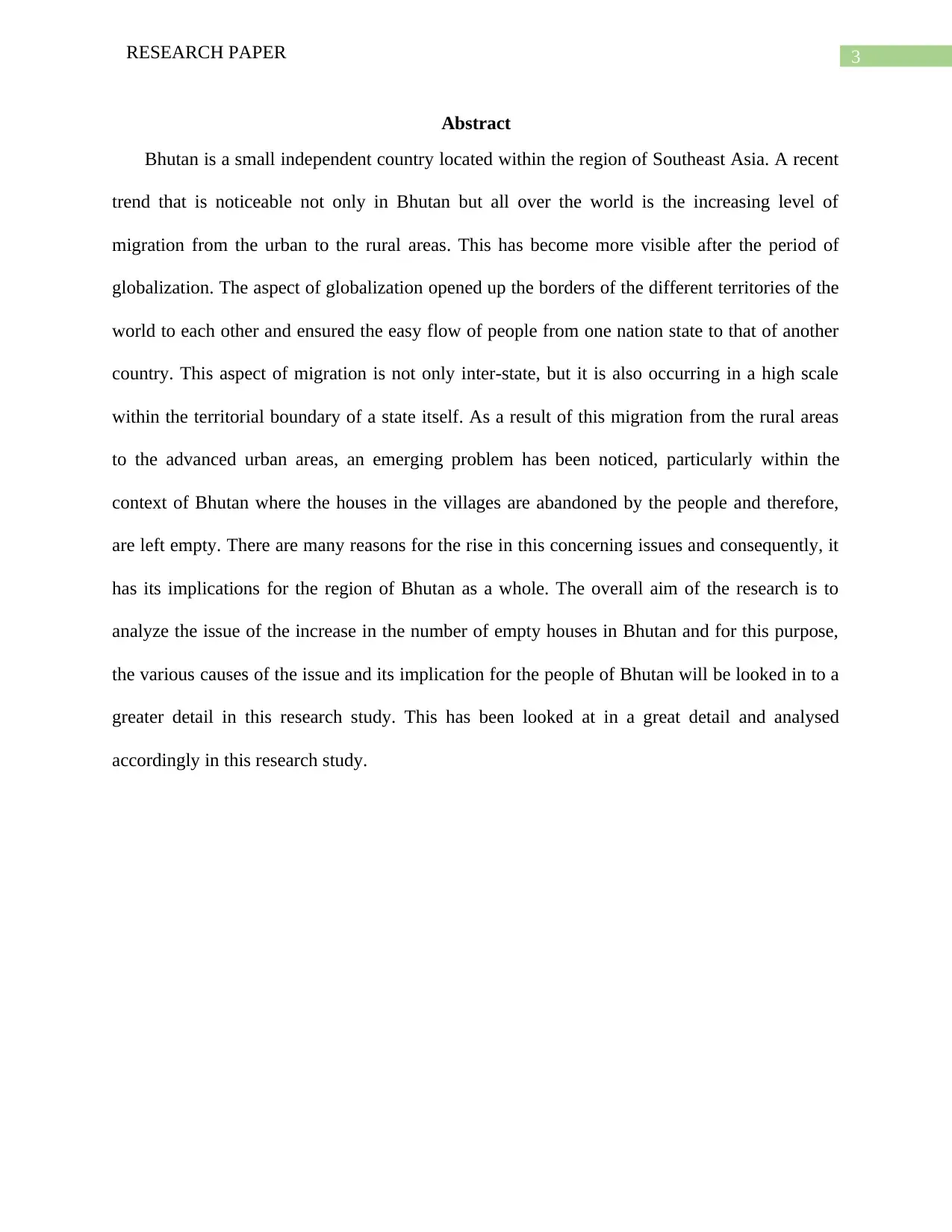
3RESEARCH PAPER
Abstract
Bhutan is a small independent country located within the region of Southeast Asia. A recent
trend that is noticeable not only in Bhutan but all over the world is the increasing level of
migration from the urban to the rural areas. This has become more visible after the period of
globalization. The aspect of globalization opened up the borders of the different territories of the
world to each other and ensured the easy flow of people from one nation state to that of another
country. This aspect of migration is not only inter-state, but it is also occurring in a high scale
within the territorial boundary of a state itself. As a result of this migration from the rural areas
to the advanced urban areas, an emerging problem has been noticed, particularly within the
context of Bhutan where the houses in the villages are abandoned by the people and therefore,
are left empty. There are many reasons for the rise in this concerning issues and consequently, it
has its implications for the region of Bhutan as a whole. The overall aim of the research is to
analyze the issue of the increase in the number of empty houses in Bhutan and for this purpose,
the various causes of the issue and its implication for the people of Bhutan will be looked in to a
greater detail in this research study. This has been looked at in a great detail and analysed
accordingly in this research study.
Abstract
Bhutan is a small independent country located within the region of Southeast Asia. A recent
trend that is noticeable not only in Bhutan but all over the world is the increasing level of
migration from the urban to the rural areas. This has become more visible after the period of
globalization. The aspect of globalization opened up the borders of the different territories of the
world to each other and ensured the easy flow of people from one nation state to that of another
country. This aspect of migration is not only inter-state, but it is also occurring in a high scale
within the territorial boundary of a state itself. As a result of this migration from the rural areas
to the advanced urban areas, an emerging problem has been noticed, particularly within the
context of Bhutan where the houses in the villages are abandoned by the people and therefore,
are left empty. There are many reasons for the rise in this concerning issues and consequently, it
has its implications for the region of Bhutan as a whole. The overall aim of the research is to
analyze the issue of the increase in the number of empty houses in Bhutan and for this purpose,
the various causes of the issue and its implication for the people of Bhutan will be looked in to a
greater detail in this research study. This has been looked at in a great detail and analysed
accordingly in this research study.
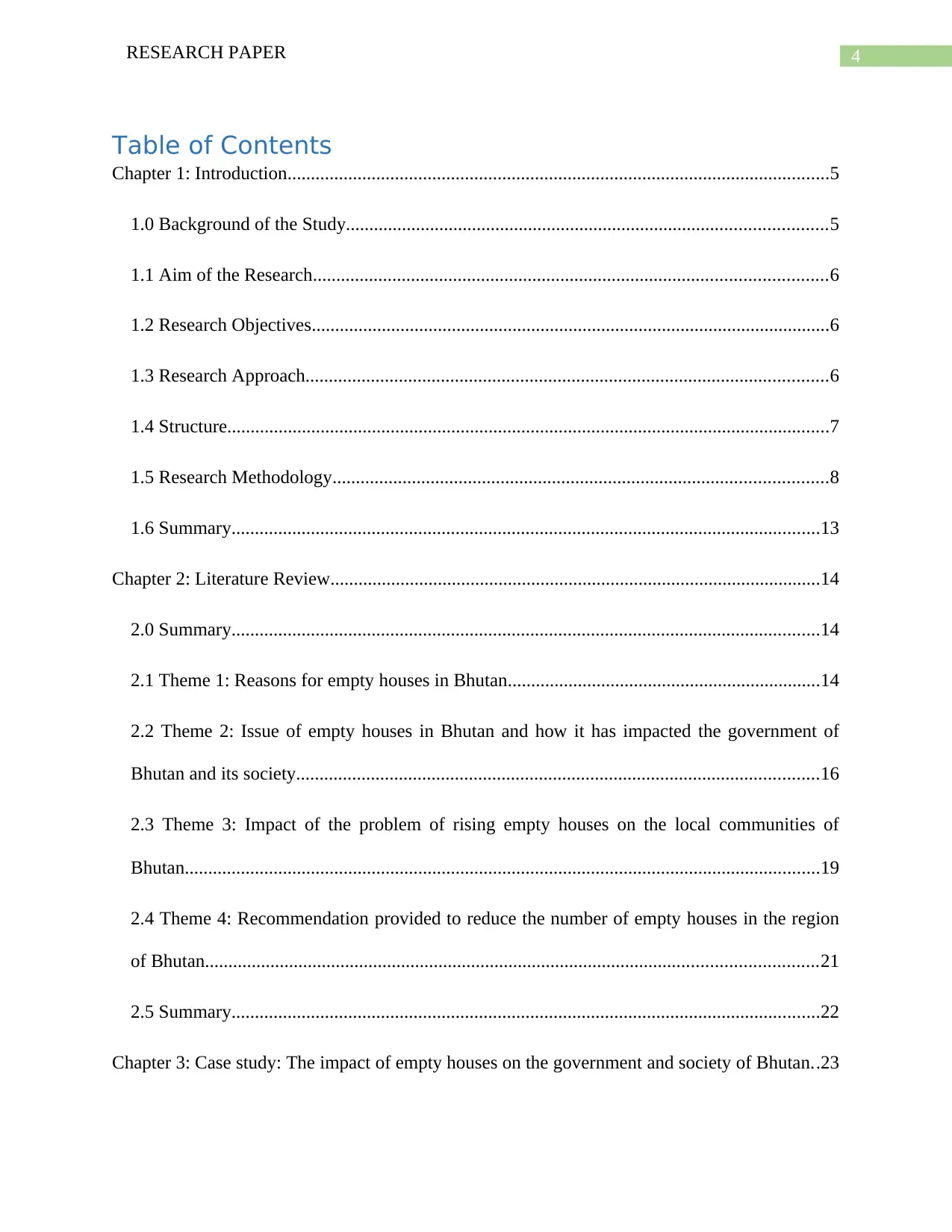
4RESEARCH PAPER
Table of Contents
Chapter 1: Introduction....................................................................................................................5
1.0 Background of the Study.......................................................................................................5
1.1 Aim of the Research..............................................................................................................6
1.2 Research Objectives...............................................................................................................6
1.3 Research Approach................................................................................................................6
1.4 Structure.................................................................................................................................7
1.5 Research Methodology..........................................................................................................8
1.6 Summary..............................................................................................................................13
Chapter 2: Literature Review.........................................................................................................14
2.0 Summary..............................................................................................................................14
2.1 Theme 1: Reasons for empty houses in Bhutan...................................................................14
2.2 Theme 2: Issue of empty houses in Bhutan and how it has impacted the government of
Bhutan and its society................................................................................................................16
2.3 Theme 3: Impact of the problem of rising empty houses on the local communities of
Bhutan........................................................................................................................................19
2.4 Theme 4: Recommendation provided to reduce the number of empty houses in the region
of Bhutan...................................................................................................................................21
2.5 Summary..............................................................................................................................22
Chapter 3: Case study: The impact of empty houses on the government and society of Bhutan..23
Table of Contents
Chapter 1: Introduction....................................................................................................................5
1.0 Background of the Study.......................................................................................................5
1.1 Aim of the Research..............................................................................................................6
1.2 Research Objectives...............................................................................................................6
1.3 Research Approach................................................................................................................6
1.4 Structure.................................................................................................................................7
1.5 Research Methodology..........................................................................................................8
1.6 Summary..............................................................................................................................13
Chapter 2: Literature Review.........................................................................................................14
2.0 Summary..............................................................................................................................14
2.1 Theme 1: Reasons for empty houses in Bhutan...................................................................14
2.2 Theme 2: Issue of empty houses in Bhutan and how it has impacted the government of
Bhutan and its society................................................................................................................16
2.3 Theme 3: Impact of the problem of rising empty houses on the local communities of
Bhutan........................................................................................................................................19
2.4 Theme 4: Recommendation provided to reduce the number of empty houses in the region
of Bhutan...................................................................................................................................21
2.5 Summary..............................................................................................................................22
Chapter 3: Case study: The impact of empty houses on the government and society of Bhutan..23
Secure Best Marks with AI Grader
Need help grading? Try our AI Grader for instant feedback on your assignments.
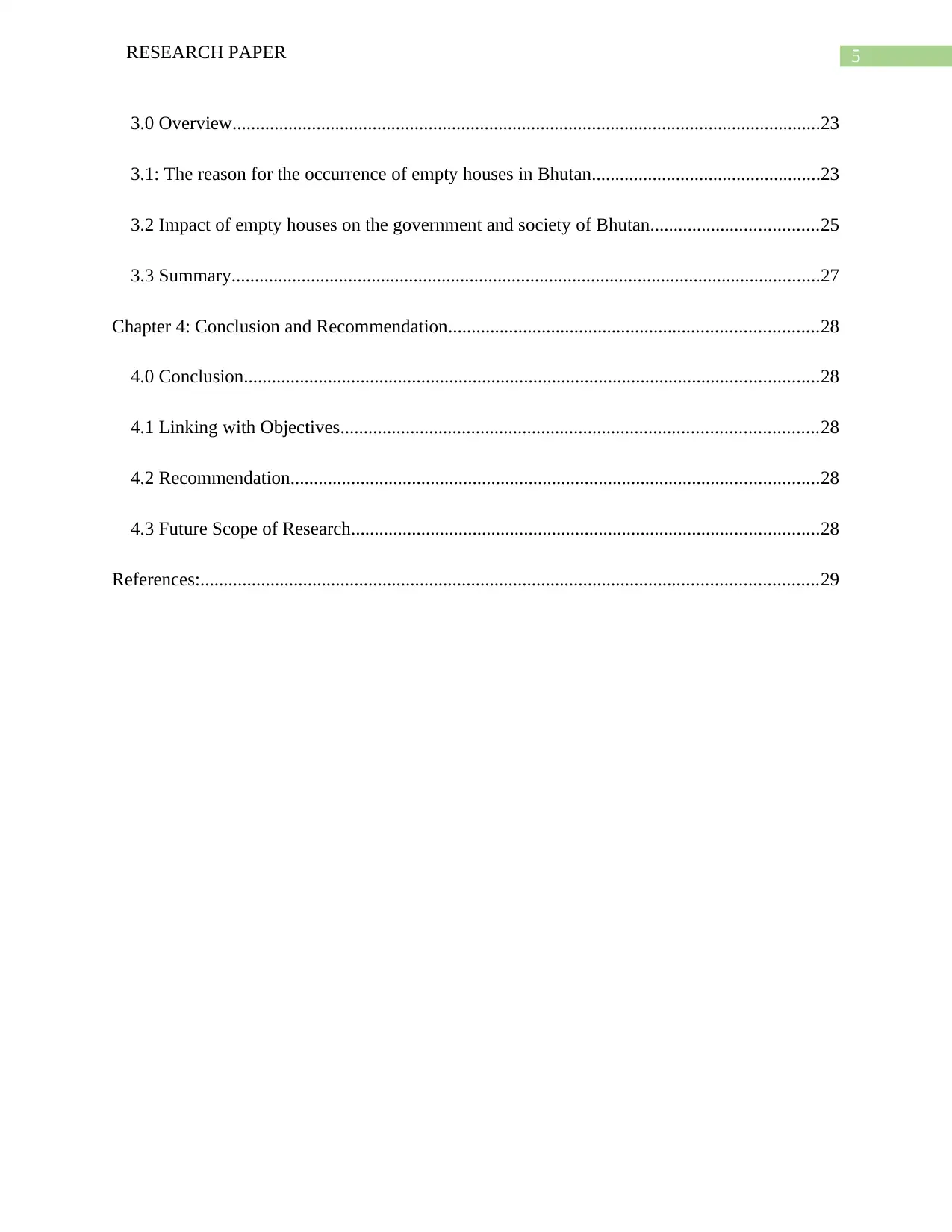
5RESEARCH PAPER
3.0 Overview..............................................................................................................................23
3.1: The reason for the occurrence of empty houses in Bhutan.................................................23
3.2 Impact of empty houses on the government and society of Bhutan....................................25
3.3 Summary..............................................................................................................................27
Chapter 4: Conclusion and Recommendation...............................................................................28
4.0 Conclusion...........................................................................................................................28
4.1 Linking with Objectives......................................................................................................28
4.2 Recommendation.................................................................................................................28
4.3 Future Scope of Research....................................................................................................28
References:....................................................................................................................................29
3.0 Overview..............................................................................................................................23
3.1: The reason for the occurrence of empty houses in Bhutan.................................................23
3.2 Impact of empty houses on the government and society of Bhutan....................................25
3.3 Summary..............................................................................................................................27
Chapter 4: Conclusion and Recommendation...............................................................................28
4.0 Conclusion...........................................................................................................................28
4.1 Linking with Objectives......................................................................................................28
4.2 Recommendation.................................................................................................................28
4.3 Future Scope of Research....................................................................................................28
References:....................................................................................................................................29
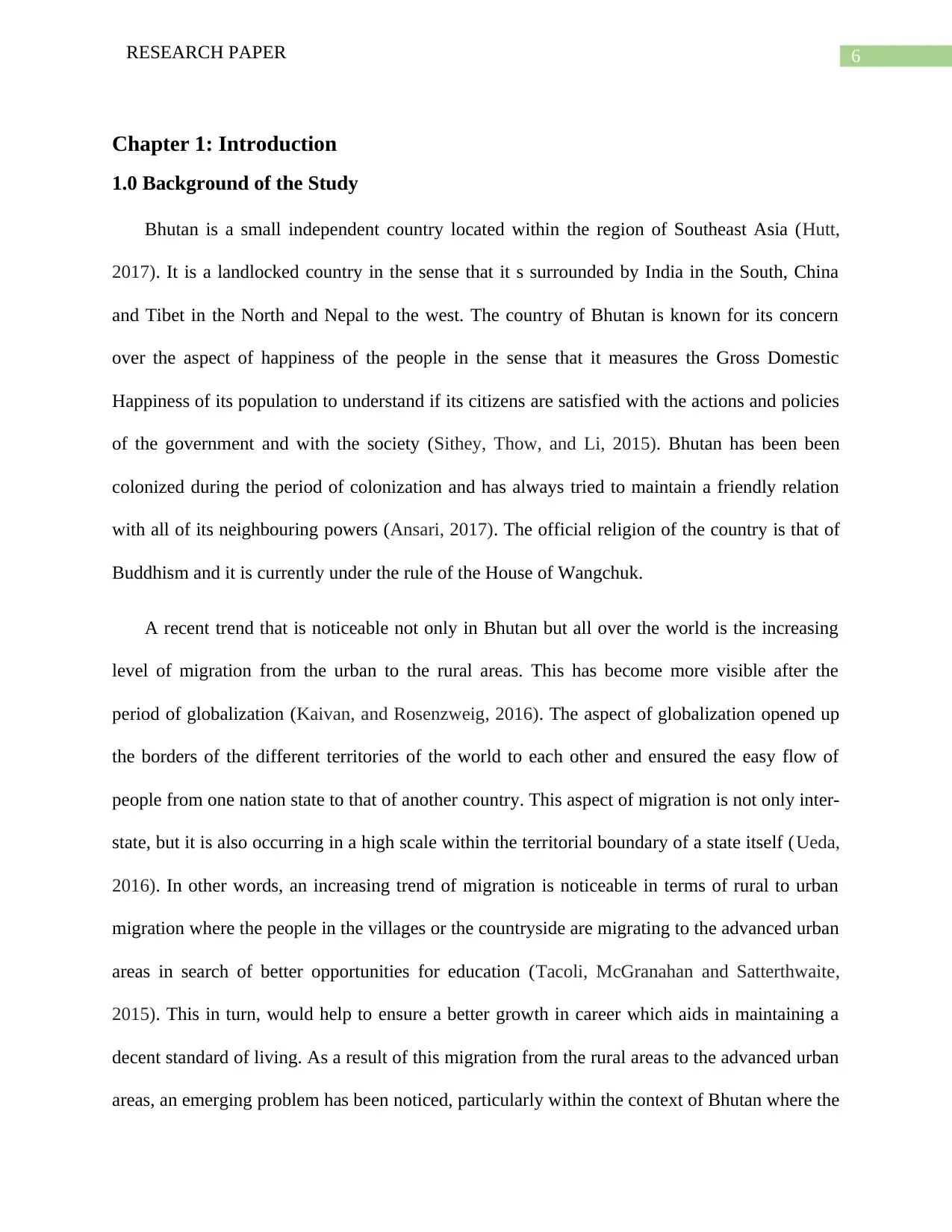
6RESEARCH PAPER
Chapter 1: Introduction
1.0 Background of the Study
Bhutan is a small independent country located within the region of Southeast Asia (Hutt,
2017). It is a landlocked country in the sense that it s surrounded by India in the South, China
and Tibet in the North and Nepal to the west. The country of Bhutan is known for its concern
over the aspect of happiness of the people in the sense that it measures the Gross Domestic
Happiness of its population to understand if its citizens are satisfied with the actions and policies
of the government and with the society (Sithey, Thow, and Li, 2015). Bhutan has been been
colonized during the period of colonization and has always tried to maintain a friendly relation
with all of its neighbouring powers (Ansari, 2017). The official religion of the country is that of
Buddhism and it is currently under the rule of the House of Wangchuk.
A recent trend that is noticeable not only in Bhutan but all over the world is the increasing
level of migration from the urban to the rural areas. This has become more visible after the
period of globalization (Kaivan, and Rosenzweig, 2016). The aspect of globalization opened up
the borders of the different territories of the world to each other and ensured the easy flow of
people from one nation state to that of another country. This aspect of migration is not only inter-
state, but it is also occurring in a high scale within the territorial boundary of a state itself (Ueda,
2016). In other words, an increasing trend of migration is noticeable in terms of rural to urban
migration where the people in the villages or the countryside are migrating to the advanced urban
areas in search of better opportunities for education (Tacoli, McGranahan and Satterthwaite,
2015). This in turn, would help to ensure a better growth in career which aids in maintaining a
decent standard of living. As a result of this migration from the rural areas to the advanced urban
areas, an emerging problem has been noticed, particularly within the context of Bhutan where the
Chapter 1: Introduction
1.0 Background of the Study
Bhutan is a small independent country located within the region of Southeast Asia (Hutt,
2017). It is a landlocked country in the sense that it s surrounded by India in the South, China
and Tibet in the North and Nepal to the west. The country of Bhutan is known for its concern
over the aspect of happiness of the people in the sense that it measures the Gross Domestic
Happiness of its population to understand if its citizens are satisfied with the actions and policies
of the government and with the society (Sithey, Thow, and Li, 2015). Bhutan has been been
colonized during the period of colonization and has always tried to maintain a friendly relation
with all of its neighbouring powers (Ansari, 2017). The official religion of the country is that of
Buddhism and it is currently under the rule of the House of Wangchuk.
A recent trend that is noticeable not only in Bhutan but all over the world is the increasing
level of migration from the urban to the rural areas. This has become more visible after the
period of globalization (Kaivan, and Rosenzweig, 2016). The aspect of globalization opened up
the borders of the different territories of the world to each other and ensured the easy flow of
people from one nation state to that of another country. This aspect of migration is not only inter-
state, but it is also occurring in a high scale within the territorial boundary of a state itself (Ueda,
2016). In other words, an increasing trend of migration is noticeable in terms of rural to urban
migration where the people in the villages or the countryside are migrating to the advanced urban
areas in search of better opportunities for education (Tacoli, McGranahan and Satterthwaite,
2015). This in turn, would help to ensure a better growth in career which aids in maintaining a
decent standard of living. As a result of this migration from the rural areas to the advanced urban
areas, an emerging problem has been noticed, particularly within the context of Bhutan where the
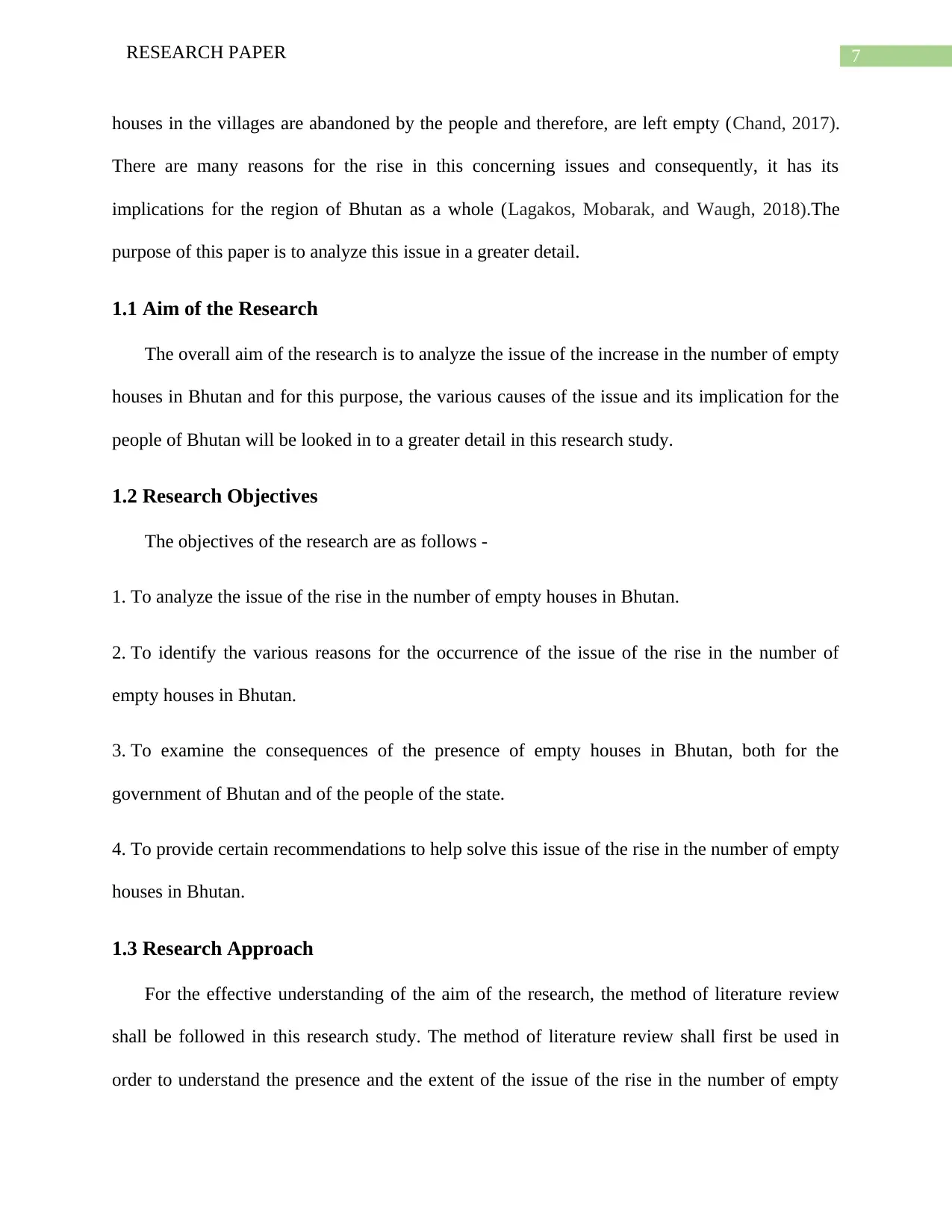
7RESEARCH PAPER
houses in the villages are abandoned by the people and therefore, are left empty (Chand, 2017).
There are many reasons for the rise in this concerning issues and consequently, it has its
implications for the region of Bhutan as a whole (Lagakos, Mobarak, and Waugh, 2018).The
purpose of this paper is to analyze this issue in a greater detail.
1.1 Aim of the Research
The overall aim of the research is to analyze the issue of the increase in the number of empty
houses in Bhutan and for this purpose, the various causes of the issue and its implication for the
people of Bhutan will be looked in to a greater detail in this research study.
1.2 Research Objectives
The objectives of the research are as follows -
1. To analyze the issue of the rise in the number of empty houses in Bhutan.
2. To identify the various reasons for the occurrence of the issue of the rise in the number of
empty houses in Bhutan.
3. To examine the consequences of the presence of empty houses in Bhutan, both for the
government of Bhutan and of the people of the state.
4. To provide certain recommendations to help solve this issue of the rise in the number of empty
houses in Bhutan.
1.3 Research Approach
For the effective understanding of the aim of the research, the method of literature review
shall be followed in this research study. The method of literature review shall first be used in
order to understand the presence and the extent of the issue of the rise in the number of empty
houses in the villages are abandoned by the people and therefore, are left empty (Chand, 2017).
There are many reasons for the rise in this concerning issues and consequently, it has its
implications for the region of Bhutan as a whole (Lagakos, Mobarak, and Waugh, 2018).The
purpose of this paper is to analyze this issue in a greater detail.
1.1 Aim of the Research
The overall aim of the research is to analyze the issue of the increase in the number of empty
houses in Bhutan and for this purpose, the various causes of the issue and its implication for the
people of Bhutan will be looked in to a greater detail in this research study.
1.2 Research Objectives
The objectives of the research are as follows -
1. To analyze the issue of the rise in the number of empty houses in Bhutan.
2. To identify the various reasons for the occurrence of the issue of the rise in the number of
empty houses in Bhutan.
3. To examine the consequences of the presence of empty houses in Bhutan, both for the
government of Bhutan and of the people of the state.
4. To provide certain recommendations to help solve this issue of the rise in the number of empty
houses in Bhutan.
1.3 Research Approach
For the effective understanding of the aim of the research, the method of literature review
shall be followed in this research study. The method of literature review shall first be used in
order to understand the presence and the extent of the issue of the rise in the number of empty
Paraphrase This Document
Need a fresh take? Get an instant paraphrase of this document with our AI Paraphraser
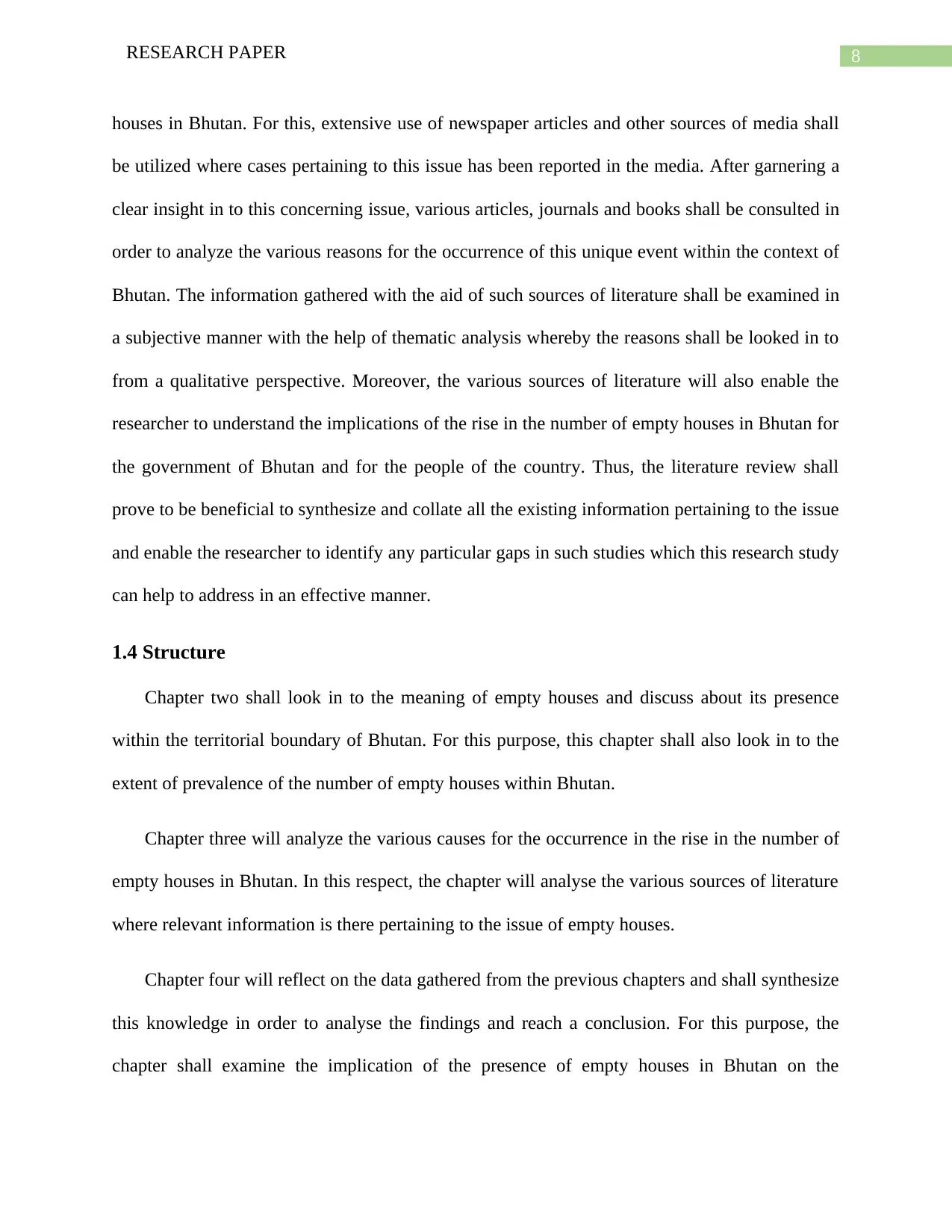
8RESEARCH PAPER
houses in Bhutan. For this, extensive use of newspaper articles and other sources of media shall
be utilized where cases pertaining to this issue has been reported in the media. After garnering a
clear insight in to this concerning issue, various articles, journals and books shall be consulted in
order to analyze the various reasons for the occurrence of this unique event within the context of
Bhutan. The information gathered with the aid of such sources of literature shall be examined in
a subjective manner with the help of thematic analysis whereby the reasons shall be looked in to
from a qualitative perspective. Moreover, the various sources of literature will also enable the
researcher to understand the implications of the rise in the number of empty houses in Bhutan for
the government of Bhutan and for the people of the country. Thus, the literature review shall
prove to be beneficial to synthesize and collate all the existing information pertaining to the issue
and enable the researcher to identify any particular gaps in such studies which this research study
can help to address in an effective manner.
1.4 Structure
Chapter two shall look in to the meaning of empty houses and discuss about its presence
within the territorial boundary of Bhutan. For this purpose, this chapter shall also look in to the
extent of prevalence of the number of empty houses within Bhutan.
Chapter three will analyze the various causes for the occurrence in the rise in the number of
empty houses in Bhutan. In this respect, the chapter will analyse the various sources of literature
where relevant information is there pertaining to the issue of empty houses.
Chapter four will reflect on the data gathered from the previous chapters and shall synthesize
this knowledge in order to analyse the findings and reach a conclusion. For this purpose, the
chapter shall examine the implication of the presence of empty houses in Bhutan on the
houses in Bhutan. For this, extensive use of newspaper articles and other sources of media shall
be utilized where cases pertaining to this issue has been reported in the media. After garnering a
clear insight in to this concerning issue, various articles, journals and books shall be consulted in
order to analyze the various reasons for the occurrence of this unique event within the context of
Bhutan. The information gathered with the aid of such sources of literature shall be examined in
a subjective manner with the help of thematic analysis whereby the reasons shall be looked in to
from a qualitative perspective. Moreover, the various sources of literature will also enable the
researcher to understand the implications of the rise in the number of empty houses in Bhutan for
the government of Bhutan and for the people of the country. Thus, the literature review shall
prove to be beneficial to synthesize and collate all the existing information pertaining to the issue
and enable the researcher to identify any particular gaps in such studies which this research study
can help to address in an effective manner.
1.4 Structure
Chapter two shall look in to the meaning of empty houses and discuss about its presence
within the territorial boundary of Bhutan. For this purpose, this chapter shall also look in to the
extent of prevalence of the number of empty houses within Bhutan.
Chapter three will analyze the various causes for the occurrence in the rise in the number of
empty houses in Bhutan. In this respect, the chapter will analyse the various sources of literature
where relevant information is there pertaining to the issue of empty houses.
Chapter four will reflect on the data gathered from the previous chapters and shall synthesize
this knowledge in order to analyse the findings and reach a conclusion. For this purpose, the
chapter shall examine the implication of the presence of empty houses in Bhutan on the
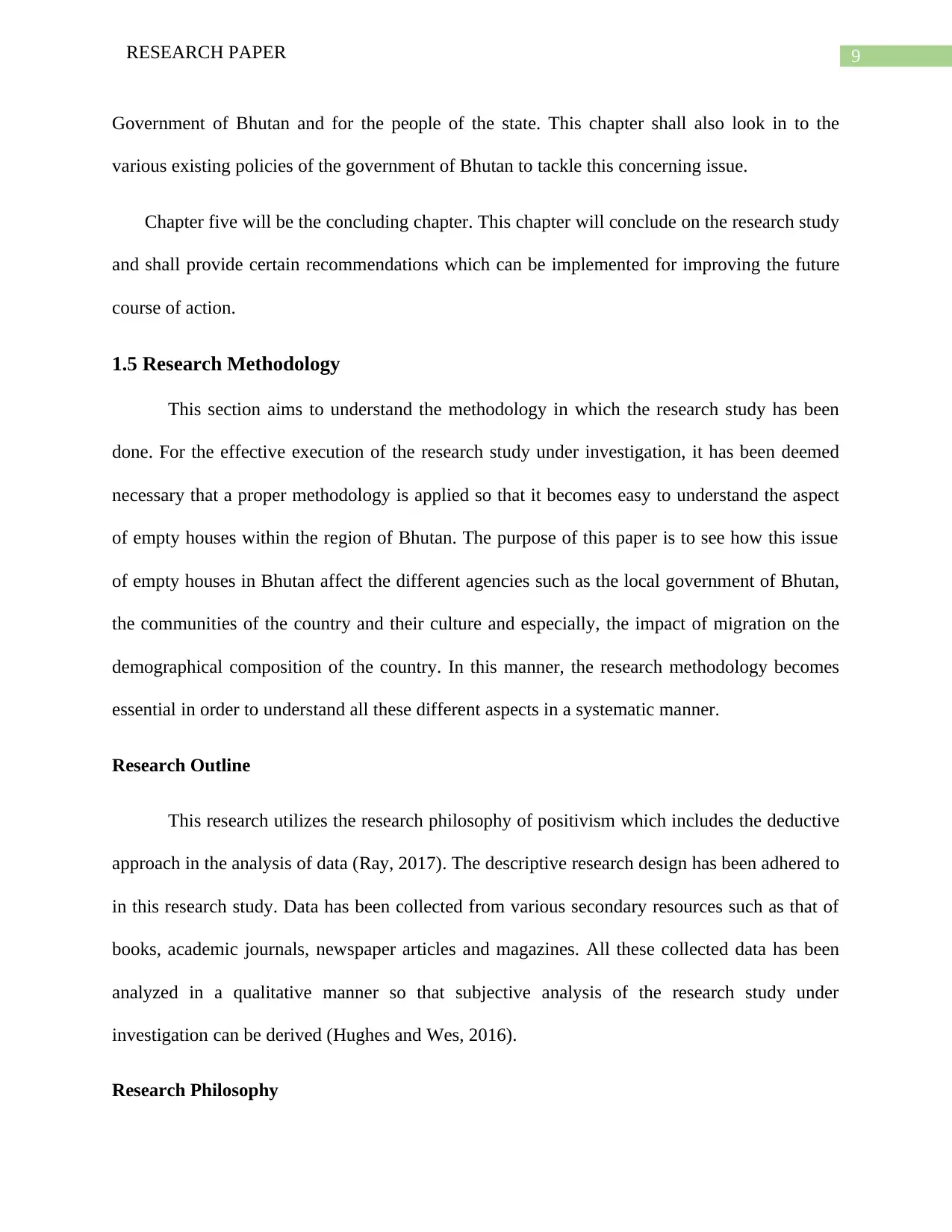
9RESEARCH PAPER
Government of Bhutan and for the people of the state. This chapter shall also look in to the
various existing policies of the government of Bhutan to tackle this concerning issue.
Chapter five will be the concluding chapter. This chapter will conclude on the research study
and shall provide certain recommendations which can be implemented for improving the future
course of action.
1.5 Research Methodology
This section aims to understand the methodology in which the research study has been
done. For the effective execution of the research study under investigation, it has been deemed
necessary that a proper methodology is applied so that it becomes easy to understand the aspect
of empty houses within the region of Bhutan. The purpose of this paper is to see how this issue
of empty houses in Bhutan affect the different agencies such as the local government of Bhutan,
the communities of the country and their culture and especially, the impact of migration on the
demographical composition of the country. In this manner, the research methodology becomes
essential in order to understand all these different aspects in a systematic manner.
Research Outline
This research utilizes the research philosophy of positivism which includes the deductive
approach in the analysis of data (Ray, 2017). The descriptive research design has been adhered to
in this research study. Data has been collected from various secondary resources such as that of
books, academic journals, newspaper articles and magazines. All these collected data has been
analyzed in a qualitative manner so that subjective analysis of the research study under
investigation can be derived (Hughes and Wes, 2016).
Research Philosophy
Government of Bhutan and for the people of the state. This chapter shall also look in to the
various existing policies of the government of Bhutan to tackle this concerning issue.
Chapter five will be the concluding chapter. This chapter will conclude on the research study
and shall provide certain recommendations which can be implemented for improving the future
course of action.
1.5 Research Methodology
This section aims to understand the methodology in which the research study has been
done. For the effective execution of the research study under investigation, it has been deemed
necessary that a proper methodology is applied so that it becomes easy to understand the aspect
of empty houses within the region of Bhutan. The purpose of this paper is to see how this issue
of empty houses in Bhutan affect the different agencies such as the local government of Bhutan,
the communities of the country and their culture and especially, the impact of migration on the
demographical composition of the country. In this manner, the research methodology becomes
essential in order to understand all these different aspects in a systematic manner.
Research Outline
This research utilizes the research philosophy of positivism which includes the deductive
approach in the analysis of data (Ray, 2017). The descriptive research design has been adhered to
in this research study. Data has been collected from various secondary resources such as that of
books, academic journals, newspaper articles and magazines. All these collected data has been
analyzed in a qualitative manner so that subjective analysis of the research study under
investigation can be derived (Hughes and Wes, 2016).
Research Philosophy
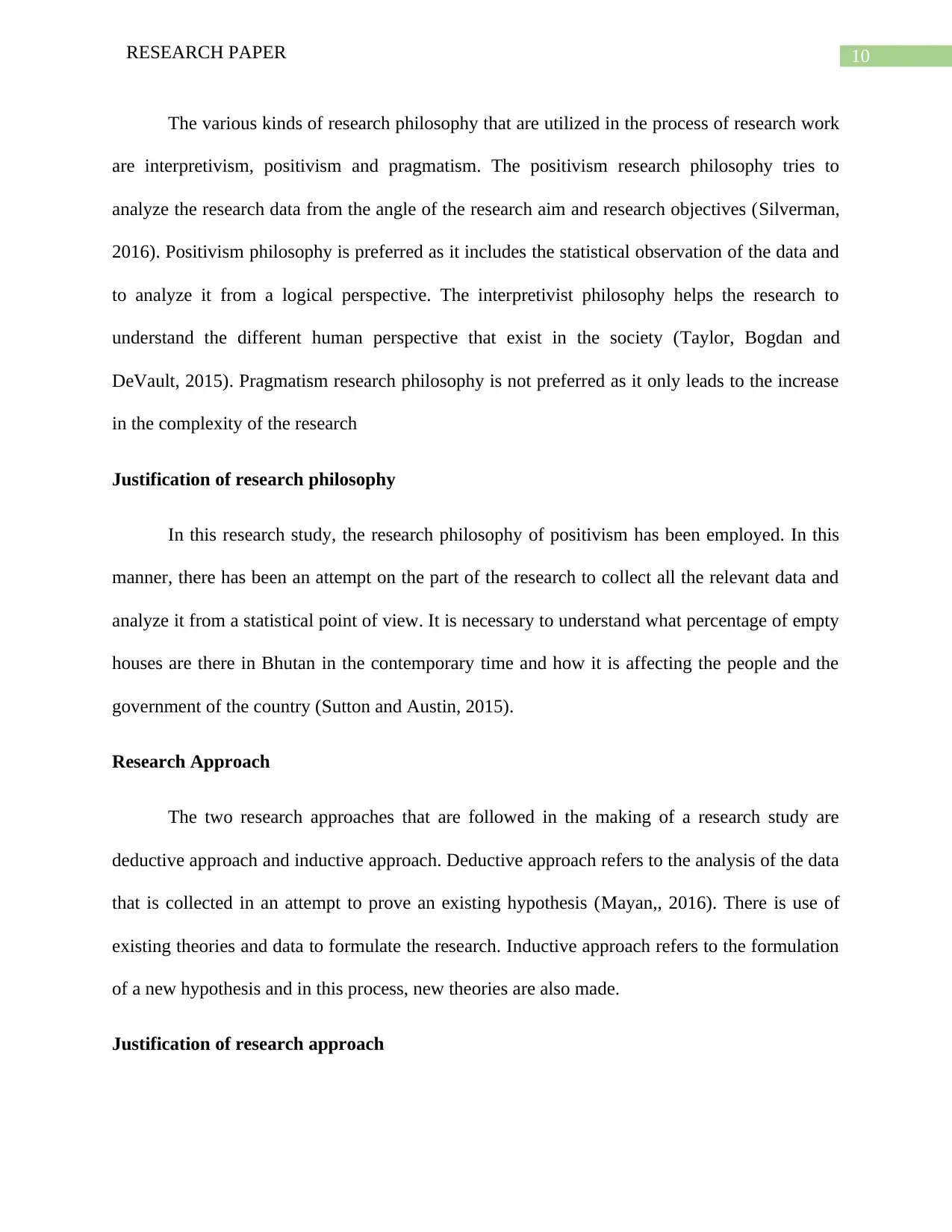
10RESEARCH PAPER
The various kinds of research philosophy that are utilized in the process of research work
are interpretivism, positivism and pragmatism. The positivism research philosophy tries to
analyze the research data from the angle of the research aim and research objectives (Silverman,
2016). Positivism philosophy is preferred as it includes the statistical observation of the data and
to analyze it from a logical perspective. The interpretivist philosophy helps the research to
understand the different human perspective that exist in the society (Taylor, Bogdan and
DeVault, 2015). Pragmatism research philosophy is not preferred as it only leads to the increase
in the complexity of the research
Justification of research philosophy
In this research study, the research philosophy of positivism has been employed. In this
manner, there has been an attempt on the part of the research to collect all the relevant data and
analyze it from a statistical point of view. It is necessary to understand what percentage of empty
houses are there in Bhutan in the contemporary time and how it is affecting the people and the
government of the country (Sutton and Austin, 2015).
Research Approach
The two research approaches that are followed in the making of a research study are
deductive approach and inductive approach. Deductive approach refers to the analysis of the data
that is collected in an attempt to prove an existing hypothesis (Mayan,, 2016). There is use of
existing theories and data to formulate the research. Inductive approach refers to the formulation
of a new hypothesis and in this process, new theories are also made.
Justification of research approach
The various kinds of research philosophy that are utilized in the process of research work
are interpretivism, positivism and pragmatism. The positivism research philosophy tries to
analyze the research data from the angle of the research aim and research objectives (Silverman,
2016). Positivism philosophy is preferred as it includes the statistical observation of the data and
to analyze it from a logical perspective. The interpretivist philosophy helps the research to
understand the different human perspective that exist in the society (Taylor, Bogdan and
DeVault, 2015). Pragmatism research philosophy is not preferred as it only leads to the increase
in the complexity of the research
Justification of research philosophy
In this research study, the research philosophy of positivism has been employed. In this
manner, there has been an attempt on the part of the research to collect all the relevant data and
analyze it from a statistical point of view. It is necessary to understand what percentage of empty
houses are there in Bhutan in the contemporary time and how it is affecting the people and the
government of the country (Sutton and Austin, 2015).
Research Approach
The two research approaches that are followed in the making of a research study are
deductive approach and inductive approach. Deductive approach refers to the analysis of the data
that is collected in an attempt to prove an existing hypothesis (Mayan,, 2016). There is use of
existing theories and data to formulate the research. Inductive approach refers to the formulation
of a new hypothesis and in this process, new theories are also made.
Justification of research approach
Secure Best Marks with AI Grader
Need help grading? Try our AI Grader for instant feedback on your assignments.
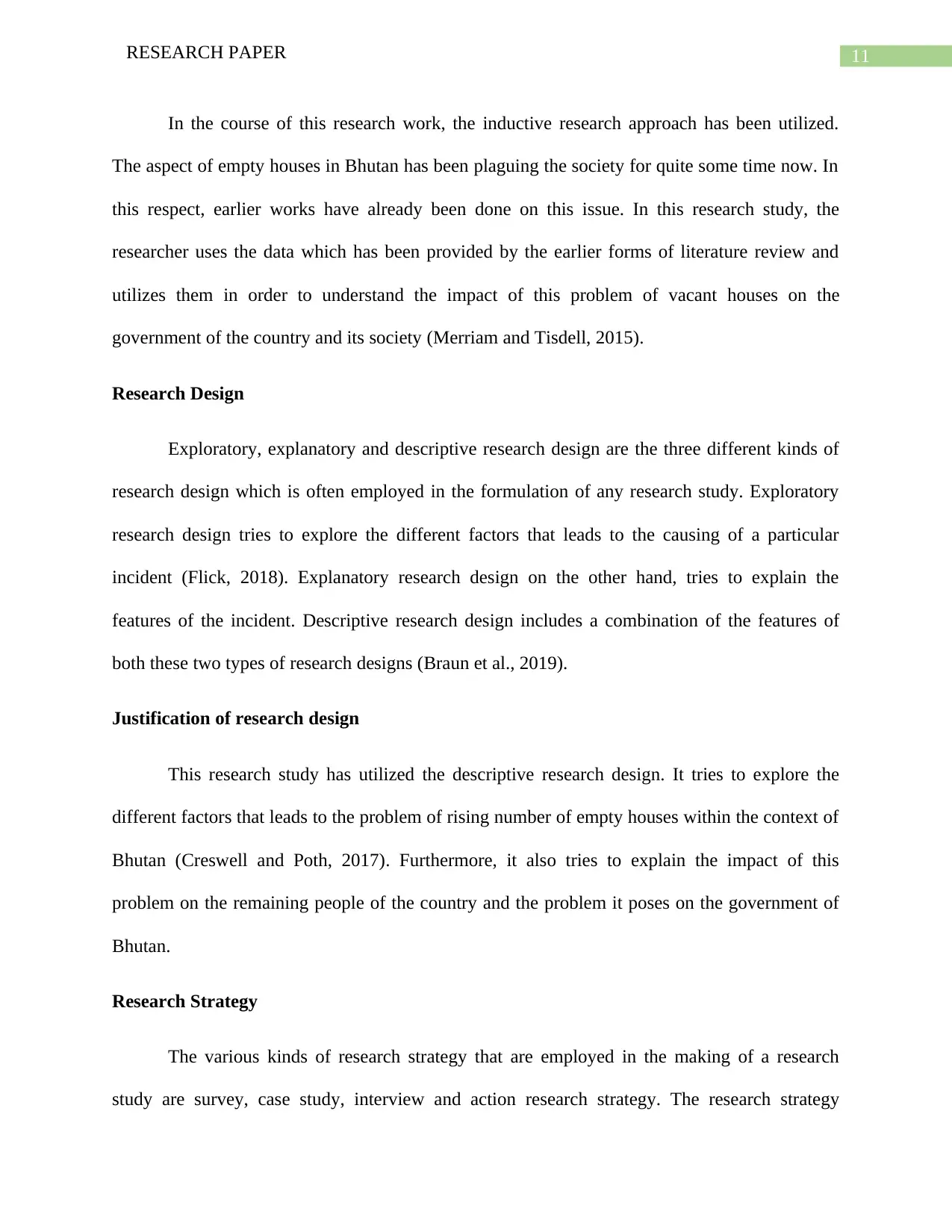
11RESEARCH PAPER
In the course of this research work, the inductive research approach has been utilized.
The aspect of empty houses in Bhutan has been plaguing the society for quite some time now. In
this respect, earlier works have already been done on this issue. In this research study, the
researcher uses the data which has been provided by the earlier forms of literature review and
utilizes them in order to understand the impact of this problem of vacant houses on the
government of the country and its society (Merriam and Tisdell, 2015).
Research Design
Exploratory, explanatory and descriptive research design are the three different kinds of
research design which is often employed in the formulation of any research study. Exploratory
research design tries to explore the different factors that leads to the causing of a particular
incident (Flick, 2018). Explanatory research design on the other hand, tries to explain the
features of the incident. Descriptive research design includes a combination of the features of
both these two types of research designs (Braun et al., 2019).
Justification of research design
This research study has utilized the descriptive research design. It tries to explore the
different factors that leads to the problem of rising number of empty houses within the context of
Bhutan (Creswell and Poth, 2017). Furthermore, it also tries to explain the impact of this
problem on the remaining people of the country and the problem it poses on the government of
Bhutan.
Research Strategy
The various kinds of research strategy that are employed in the making of a research
study are survey, case study, interview and action research strategy. The research strategy
In the course of this research work, the inductive research approach has been utilized.
The aspect of empty houses in Bhutan has been plaguing the society for quite some time now. In
this respect, earlier works have already been done on this issue. In this research study, the
researcher uses the data which has been provided by the earlier forms of literature review and
utilizes them in order to understand the impact of this problem of vacant houses on the
government of the country and its society (Merriam and Tisdell, 2015).
Research Design
Exploratory, explanatory and descriptive research design are the three different kinds of
research design which is often employed in the formulation of any research study. Exploratory
research design tries to explore the different factors that leads to the causing of a particular
incident (Flick, 2018). Explanatory research design on the other hand, tries to explain the
features of the incident. Descriptive research design includes a combination of the features of
both these two types of research designs (Braun et al., 2019).
Justification of research design
This research study has utilized the descriptive research design. It tries to explore the
different factors that leads to the problem of rising number of empty houses within the context of
Bhutan (Creswell and Poth, 2017). Furthermore, it also tries to explain the impact of this
problem on the remaining people of the country and the problem it poses on the government of
Bhutan.
Research Strategy
The various kinds of research strategy that are employed in the making of a research
study are survey, case study, interview and action research strategy. The research strategy
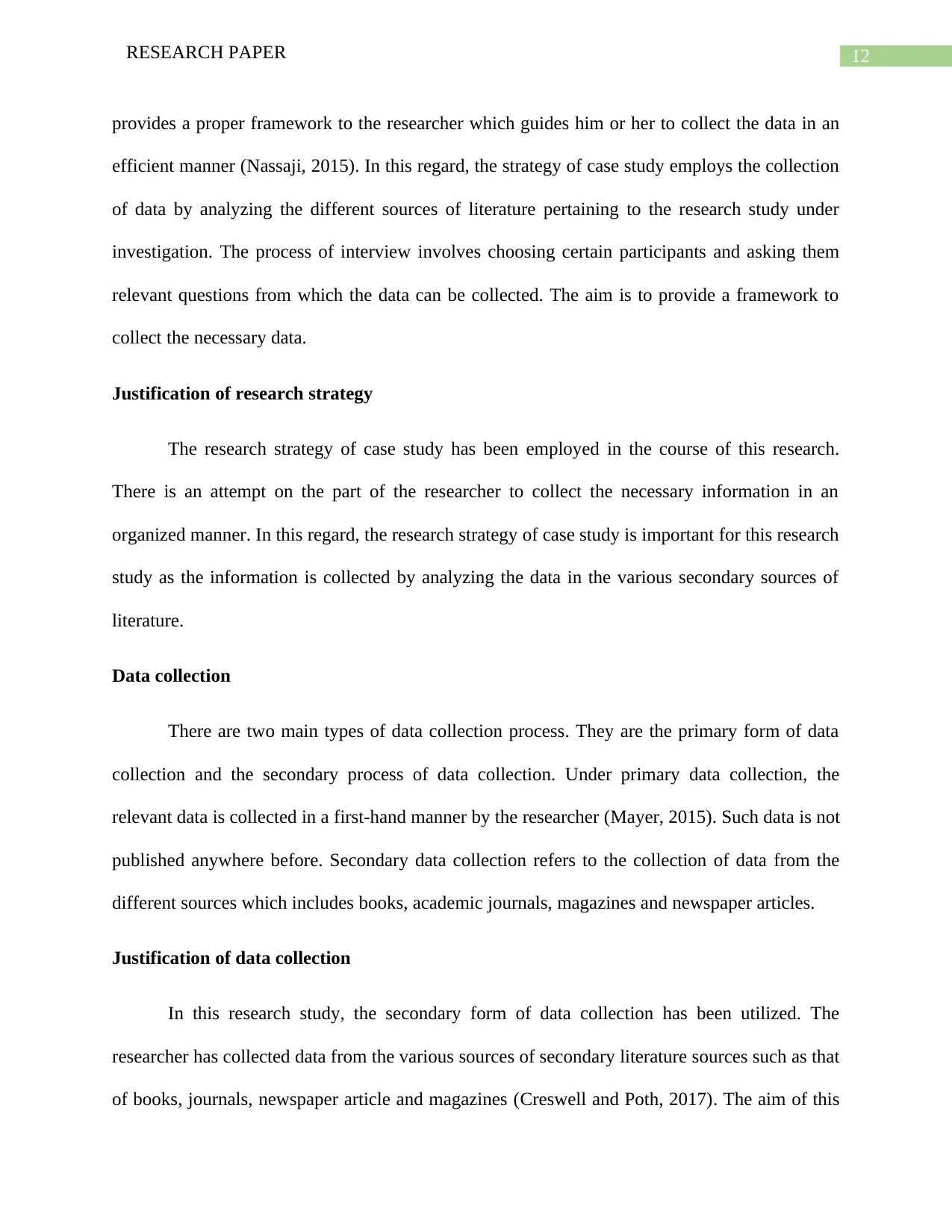
12RESEARCH PAPER
provides a proper framework to the researcher which guides him or her to collect the data in an
efficient manner (Nassaji, 2015). In this regard, the strategy of case study employs the collection
of data by analyzing the different sources of literature pertaining to the research study under
investigation. The process of interview involves choosing certain participants and asking them
relevant questions from which the data can be collected. The aim is to provide a framework to
collect the necessary data.
Justification of research strategy
The research strategy of case study has been employed in the course of this research.
There is an attempt on the part of the researcher to collect the necessary information in an
organized manner. In this regard, the research strategy of case study is important for this research
study as the information is collected by analyzing the data in the various secondary sources of
literature.
Data collection
There are two main types of data collection process. They are the primary form of data
collection and the secondary process of data collection. Under primary data collection, the
relevant data is collected in a first-hand manner by the researcher (Mayer, 2015). Such data is not
published anywhere before. Secondary data collection refers to the collection of data from the
different sources which includes books, academic journals, magazines and newspaper articles.
Justification of data collection
In this research study, the secondary form of data collection has been utilized. The
researcher has collected data from the various sources of secondary literature sources such as that
of books, journals, newspaper article and magazines (Creswell and Poth, 2017). The aim of this
provides a proper framework to the researcher which guides him or her to collect the data in an
efficient manner (Nassaji, 2015). In this regard, the strategy of case study employs the collection
of data by analyzing the different sources of literature pertaining to the research study under
investigation. The process of interview involves choosing certain participants and asking them
relevant questions from which the data can be collected. The aim is to provide a framework to
collect the necessary data.
Justification of research strategy
The research strategy of case study has been employed in the course of this research.
There is an attempt on the part of the researcher to collect the necessary information in an
organized manner. In this regard, the research strategy of case study is important for this research
study as the information is collected by analyzing the data in the various secondary sources of
literature.
Data collection
There are two main types of data collection process. They are the primary form of data
collection and the secondary process of data collection. Under primary data collection, the
relevant data is collected in a first-hand manner by the researcher (Mayer, 2015). Such data is not
published anywhere before. Secondary data collection refers to the collection of data from the
different sources which includes books, academic journals, magazines and newspaper articles.
Justification of data collection
In this research study, the secondary form of data collection has been utilized. The
researcher has collected data from the various sources of secondary literature sources such as that
of books, journals, newspaper article and magazines (Creswell and Poth, 2017). The aim of this
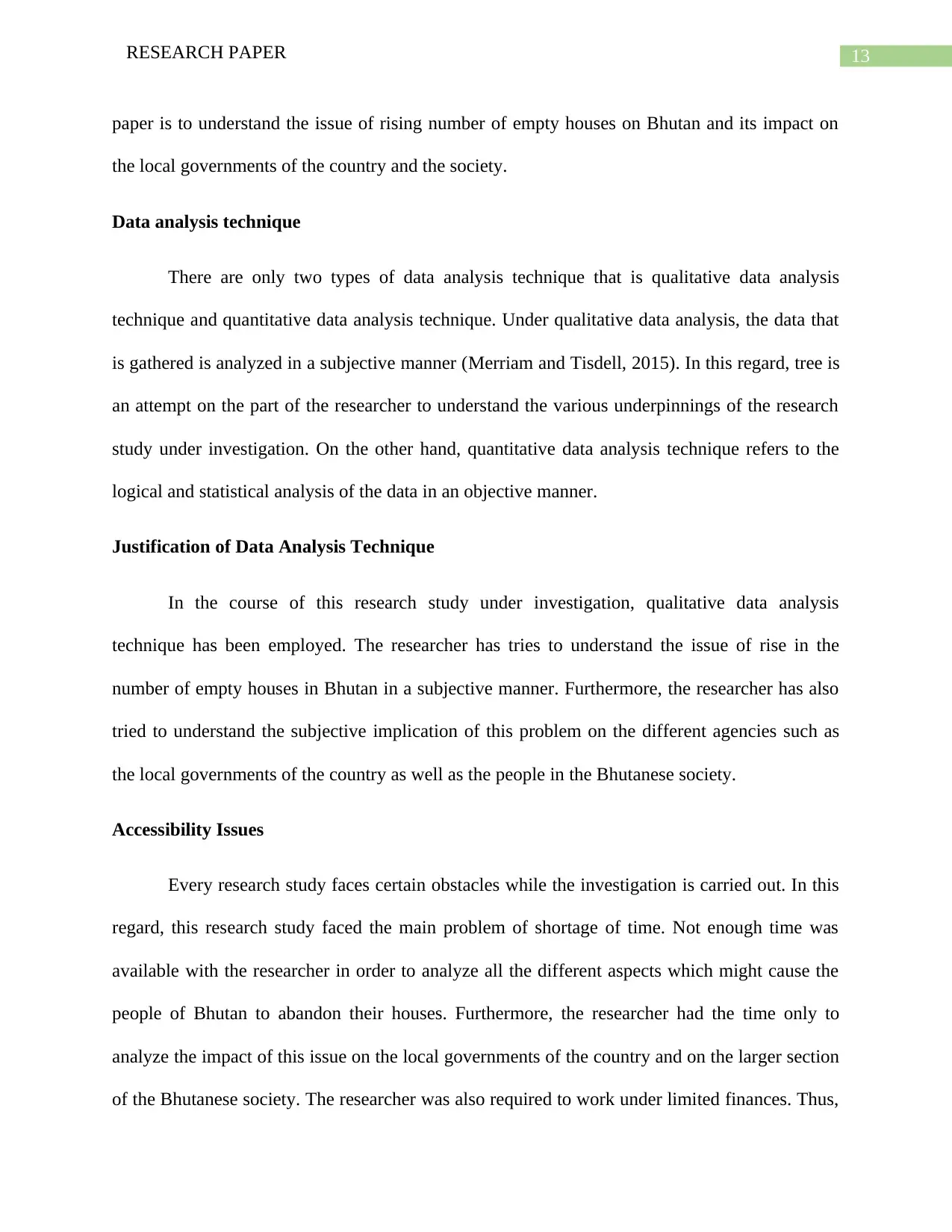
13RESEARCH PAPER
paper is to understand the issue of rising number of empty houses on Bhutan and its impact on
the local governments of the country and the society.
Data analysis technique
There are only two types of data analysis technique that is qualitative data analysis
technique and quantitative data analysis technique. Under qualitative data analysis, the data that
is gathered is analyzed in a subjective manner (Merriam and Tisdell, 2015). In this regard, tree is
an attempt on the part of the researcher to understand the various underpinnings of the research
study under investigation. On the other hand, quantitative data analysis technique refers to the
logical and statistical analysis of the data in an objective manner.
Justification of Data Analysis Technique
In the course of this research study under investigation, qualitative data analysis
technique has been employed. The researcher has tries to understand the issue of rise in the
number of empty houses in Bhutan in a subjective manner. Furthermore, the researcher has also
tried to understand the subjective implication of this problem on the different agencies such as
the local governments of the country as well as the people in the Bhutanese society.
Accessibility Issues
Every research study faces certain obstacles while the investigation is carried out. In this
regard, this research study faced the main problem of shortage of time. Not enough time was
available with the researcher in order to analyze all the different aspects which might cause the
people of Bhutan to abandon their houses. Furthermore, the researcher had the time only to
analyze the impact of this issue on the local governments of the country and on the larger section
of the Bhutanese society. The researcher was also required to work under limited finances. Thus,
paper is to understand the issue of rising number of empty houses on Bhutan and its impact on
the local governments of the country and the society.
Data analysis technique
There are only two types of data analysis technique that is qualitative data analysis
technique and quantitative data analysis technique. Under qualitative data analysis, the data that
is gathered is analyzed in a subjective manner (Merriam and Tisdell, 2015). In this regard, tree is
an attempt on the part of the researcher to understand the various underpinnings of the research
study under investigation. On the other hand, quantitative data analysis technique refers to the
logical and statistical analysis of the data in an objective manner.
Justification of Data Analysis Technique
In the course of this research study under investigation, qualitative data analysis
technique has been employed. The researcher has tries to understand the issue of rise in the
number of empty houses in Bhutan in a subjective manner. Furthermore, the researcher has also
tried to understand the subjective implication of this problem on the different agencies such as
the local governments of the country as well as the people in the Bhutanese society.
Accessibility Issues
Every research study faces certain obstacles while the investigation is carried out. In this
regard, this research study faced the main problem of shortage of time. Not enough time was
available with the researcher in order to analyze all the different aspects which might cause the
people of Bhutan to abandon their houses. Furthermore, the researcher had the time only to
analyze the impact of this issue on the local governments of the country and on the larger section
of the Bhutanese society. The researcher was also required to work under limited finances. Thus,
Paraphrase This Document
Need a fresh take? Get an instant paraphrase of this document with our AI Paraphraser
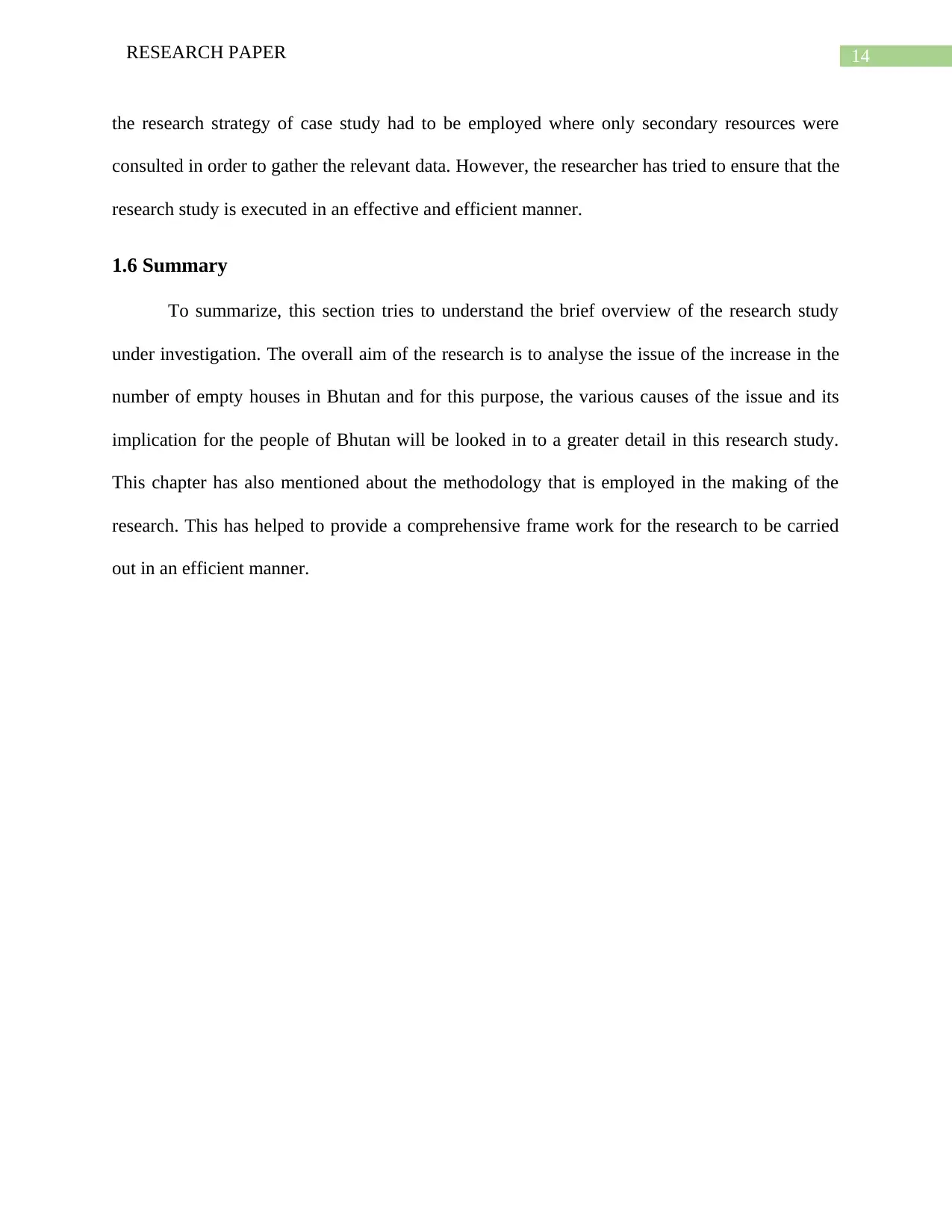
14RESEARCH PAPER
the research strategy of case study had to be employed where only secondary resources were
consulted in order to gather the relevant data. However, the researcher has tried to ensure that the
research study is executed in an effective and efficient manner.
1.6 Summary
To summarize, this section tries to understand the brief overview of the research study
under investigation. The overall aim of the research is to analyse the issue of the increase in the
number of empty houses in Bhutan and for this purpose, the various causes of the issue and its
implication for the people of Bhutan will be looked in to a greater detail in this research study.
This chapter has also mentioned about the methodology that is employed in the making of the
research. This has helped to provide a comprehensive frame work for the research to be carried
out in an efficient manner.
the research strategy of case study had to be employed where only secondary resources were
consulted in order to gather the relevant data. However, the researcher has tried to ensure that the
research study is executed in an effective and efficient manner.
1.6 Summary
To summarize, this section tries to understand the brief overview of the research study
under investigation. The overall aim of the research is to analyse the issue of the increase in the
number of empty houses in Bhutan and for this purpose, the various causes of the issue and its
implication for the people of Bhutan will be looked in to a greater detail in this research study.
This chapter has also mentioned about the methodology that is employed in the making of the
research. This has helped to provide a comprehensive frame work for the research to be carried
out in an efficient manner.
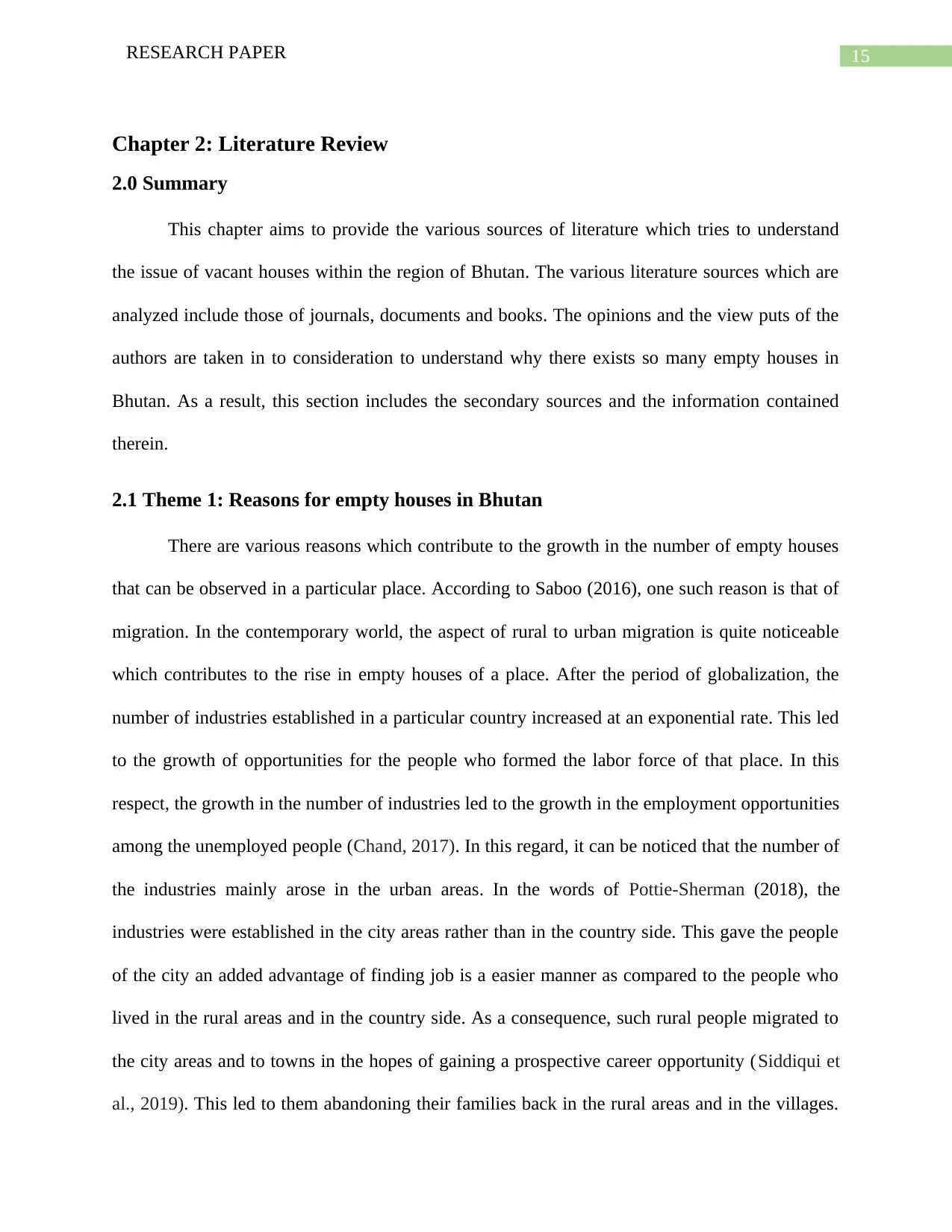
15RESEARCH PAPER
Chapter 2: Literature Review
2.0 Summary
This chapter aims to provide the various sources of literature which tries to understand
the issue of vacant houses within the region of Bhutan. The various literature sources which are
analyzed include those of journals, documents and books. The opinions and the view puts of the
authors are taken in to consideration to understand why there exists so many empty houses in
Bhutan. As a result, this section includes the secondary sources and the information contained
therein.
2.1 Theme 1: Reasons for empty houses in Bhutan
There are various reasons which contribute to the growth in the number of empty houses
that can be observed in a particular place. According to Saboo (2016), one such reason is that of
migration. In the contemporary world, the aspect of rural to urban migration is quite noticeable
which contributes to the rise in empty houses of a place. After the period of globalization, the
number of industries established in a particular country increased at an exponential rate. This led
to the growth of opportunities for the people who formed the labor force of that place. In this
respect, the growth in the number of industries led to the growth in the employment opportunities
among the unemployed people (Chand, 2017). In this regard, it can be noticed that the number of
the industries mainly arose in the urban areas. In the words of Pottie-Sherman (2018), the
industries were established in the city areas rather than in the country side. This gave the people
of the city an added advantage of finding job is a easier manner as compared to the people who
lived in the rural areas and in the country side. As a consequence, such rural people migrated to
the city areas and to towns in the hopes of gaining a prospective career opportunity (Siddiqui et
al., 2019). This led to them abandoning their families back in the rural areas and in the villages.
Chapter 2: Literature Review
2.0 Summary
This chapter aims to provide the various sources of literature which tries to understand
the issue of vacant houses within the region of Bhutan. The various literature sources which are
analyzed include those of journals, documents and books. The opinions and the view puts of the
authors are taken in to consideration to understand why there exists so many empty houses in
Bhutan. As a result, this section includes the secondary sources and the information contained
therein.
2.1 Theme 1: Reasons for empty houses in Bhutan
There are various reasons which contribute to the growth in the number of empty houses
that can be observed in a particular place. According to Saboo (2016), one such reason is that of
migration. In the contemporary world, the aspect of rural to urban migration is quite noticeable
which contributes to the rise in empty houses of a place. After the period of globalization, the
number of industries established in a particular country increased at an exponential rate. This led
to the growth of opportunities for the people who formed the labor force of that place. In this
respect, the growth in the number of industries led to the growth in the employment opportunities
among the unemployed people (Chand, 2017). In this regard, it can be noticed that the number of
the industries mainly arose in the urban areas. In the words of Pottie-Sherman (2018), the
industries were established in the city areas rather than in the country side. This gave the people
of the city an added advantage of finding job is a easier manner as compared to the people who
lived in the rural areas and in the country side. As a consequence, such rural people migrated to
the city areas and to towns in the hopes of gaining a prospective career opportunity (Siddiqui et
al., 2019). This led to them abandoning their families back in the rural areas and in the villages.
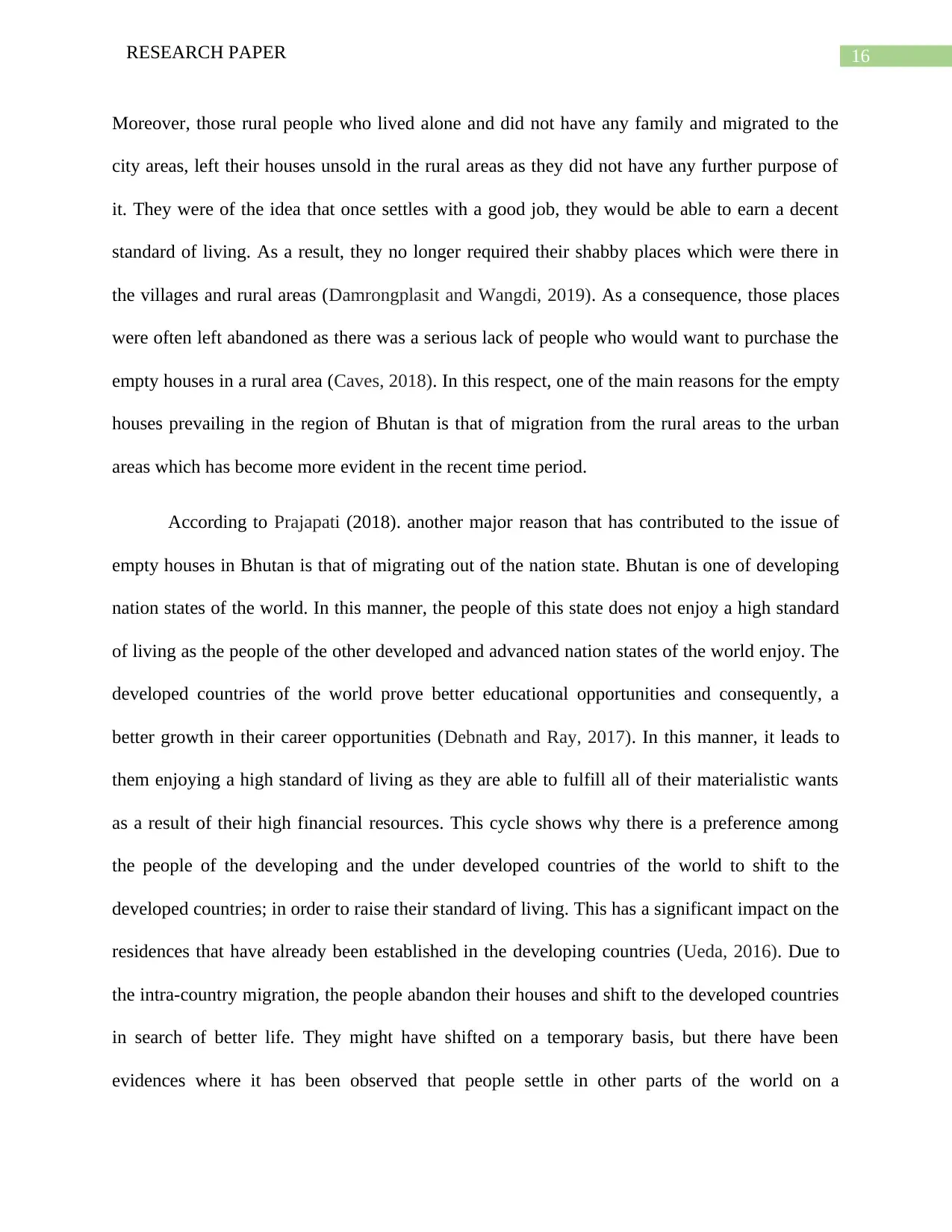
16RESEARCH PAPER
Moreover, those rural people who lived alone and did not have any family and migrated to the
city areas, left their houses unsold in the rural areas as they did not have any further purpose of
it. They were of the idea that once settles with a good job, they would be able to earn a decent
standard of living. As a result, they no longer required their shabby places which were there in
the villages and rural areas (Damrongplasit and Wangdi, 2019). As a consequence, those places
were often left abandoned as there was a serious lack of people who would want to purchase the
empty houses in a rural area (Caves, 2018). In this respect, one of the main reasons for the empty
houses prevailing in the region of Bhutan is that of migration from the rural areas to the urban
areas which has become more evident in the recent time period.
According to Prajapati (2018). another major reason that has contributed to the issue of
empty houses in Bhutan is that of migrating out of the nation state. Bhutan is one of developing
nation states of the world. In this manner, the people of this state does not enjoy a high standard
of living as the people of the other developed and advanced nation states of the world enjoy. The
developed countries of the world prove better educational opportunities and consequently, a
better growth in their career opportunities (Debnath and Ray, 2017). In this manner, it leads to
them enjoying a high standard of living as they are able to fulfill all of their materialistic wants
as a result of their high financial resources. This cycle shows why there is a preference among
the people of the developing and the under developed countries of the world to shift to the
developed countries; in order to raise their standard of living. This has a significant impact on the
residences that have already been established in the developing countries (Ueda, 2016). Due to
the intra-country migration, the people abandon their houses and shift to the developed countries
in search of better life. They might have shifted on a temporary basis, but there have been
evidences where it has been observed that people settle in other parts of the world on a
Moreover, those rural people who lived alone and did not have any family and migrated to the
city areas, left their houses unsold in the rural areas as they did not have any further purpose of
it. They were of the idea that once settles with a good job, they would be able to earn a decent
standard of living. As a result, they no longer required their shabby places which were there in
the villages and rural areas (Damrongplasit and Wangdi, 2019). As a consequence, those places
were often left abandoned as there was a serious lack of people who would want to purchase the
empty houses in a rural area (Caves, 2018). In this respect, one of the main reasons for the empty
houses prevailing in the region of Bhutan is that of migration from the rural areas to the urban
areas which has become more evident in the recent time period.
According to Prajapati (2018). another major reason that has contributed to the issue of
empty houses in Bhutan is that of migrating out of the nation state. Bhutan is one of developing
nation states of the world. In this manner, the people of this state does not enjoy a high standard
of living as the people of the other developed and advanced nation states of the world enjoy. The
developed countries of the world prove better educational opportunities and consequently, a
better growth in their career opportunities (Debnath and Ray, 2017). In this manner, it leads to
them enjoying a high standard of living as they are able to fulfill all of their materialistic wants
as a result of their high financial resources. This cycle shows why there is a preference among
the people of the developing and the under developed countries of the world to shift to the
developed countries; in order to raise their standard of living. This has a significant impact on the
residences that have already been established in the developing countries (Ueda, 2016). Due to
the intra-country migration, the people abandon their houses and shift to the developed countries
in search of better life. They might have shifted on a temporary basis, but there have been
evidences where it has been observed that people settle in other parts of the world on a
Secure Best Marks with AI Grader
Need help grading? Try our AI Grader for instant feedback on your assignments.
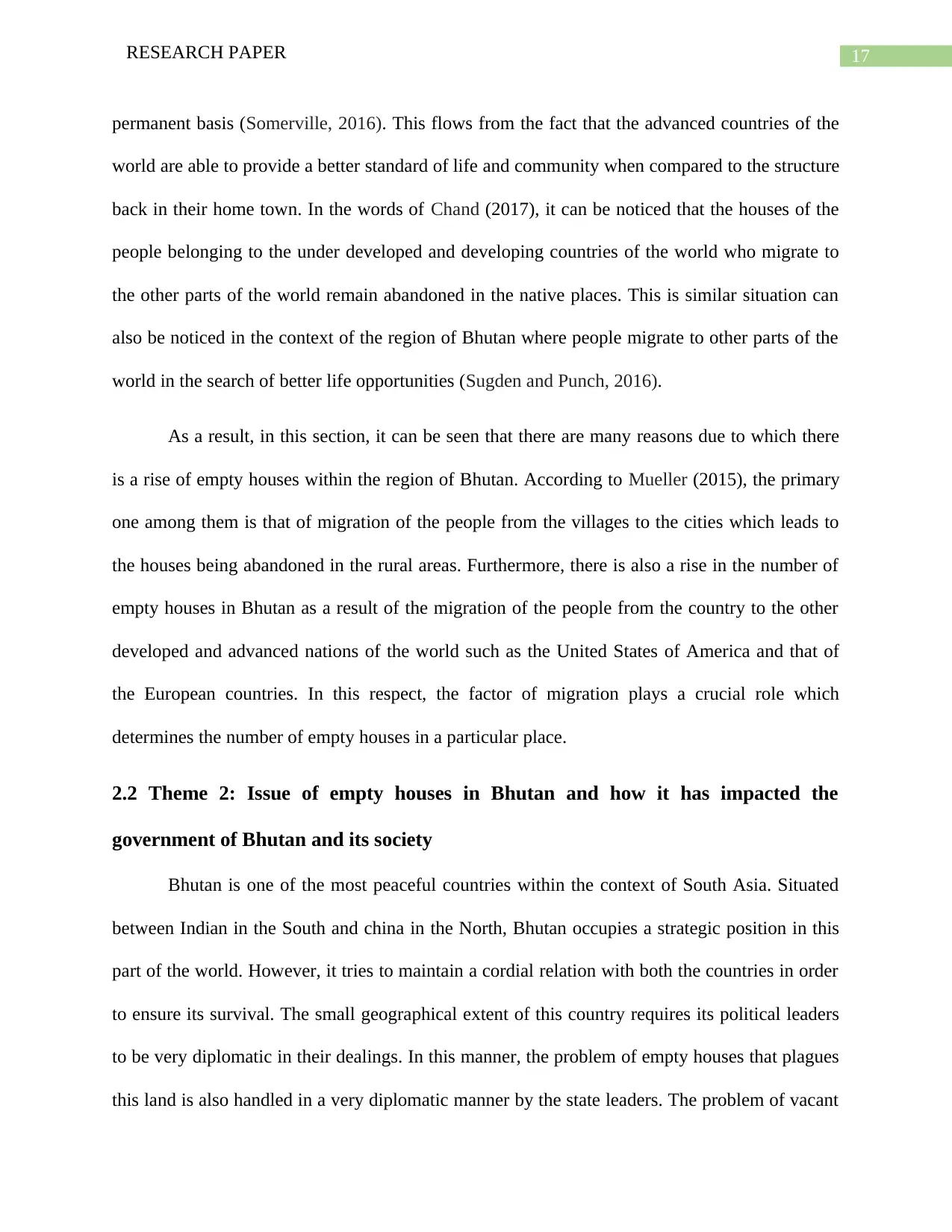
17RESEARCH PAPER
permanent basis (Somerville, 2016). This flows from the fact that the advanced countries of the
world are able to provide a better standard of life and community when compared to the structure
back in their home town. In the words of Chand (2017), it can be noticed that the houses of the
people belonging to the under developed and developing countries of the world who migrate to
the other parts of the world remain abandoned in the native places. This is similar situation can
also be noticed in the context of the region of Bhutan where people migrate to other parts of the
world in the search of better life opportunities (Sugden and Punch, 2016).
As a result, in this section, it can be seen that there are many reasons due to which there
is a rise of empty houses within the region of Bhutan. According to Mueller (2015), the primary
one among them is that of migration of the people from the villages to the cities which leads to
the houses being abandoned in the rural areas. Furthermore, there is also a rise in the number of
empty houses in Bhutan as a result of the migration of the people from the country to the other
developed and advanced nations of the world such as the United States of America and that of
the European countries. In this respect, the factor of migration plays a crucial role which
determines the number of empty houses in a particular place.
2.2 Theme 2: Issue of empty houses in Bhutan and how it has impacted the
government of Bhutan and its society
Bhutan is one of the most peaceful countries within the context of South Asia. Situated
between Indian in the South and china in the North, Bhutan occupies a strategic position in this
part of the world. However, it tries to maintain a cordial relation with both the countries in order
to ensure its survival. The small geographical extent of this country requires its political leaders
to be very diplomatic in their dealings. In this manner, the problem of empty houses that plagues
this land is also handled in a very diplomatic manner by the state leaders. The problem of vacant
permanent basis (Somerville, 2016). This flows from the fact that the advanced countries of the
world are able to provide a better standard of life and community when compared to the structure
back in their home town. In the words of Chand (2017), it can be noticed that the houses of the
people belonging to the under developed and developing countries of the world who migrate to
the other parts of the world remain abandoned in the native places. This is similar situation can
also be noticed in the context of the region of Bhutan where people migrate to other parts of the
world in the search of better life opportunities (Sugden and Punch, 2016).
As a result, in this section, it can be seen that there are many reasons due to which there
is a rise of empty houses within the region of Bhutan. According to Mueller (2015), the primary
one among them is that of migration of the people from the villages to the cities which leads to
the houses being abandoned in the rural areas. Furthermore, there is also a rise in the number of
empty houses in Bhutan as a result of the migration of the people from the country to the other
developed and advanced nations of the world such as the United States of America and that of
the European countries. In this respect, the factor of migration plays a crucial role which
determines the number of empty houses in a particular place.
2.2 Theme 2: Issue of empty houses in Bhutan and how it has impacted the
government of Bhutan and its society
Bhutan is one of the most peaceful countries within the context of South Asia. Situated
between Indian in the South and china in the North, Bhutan occupies a strategic position in this
part of the world. However, it tries to maintain a cordial relation with both the countries in order
to ensure its survival. The small geographical extent of this country requires its political leaders
to be very diplomatic in their dealings. In this manner, the problem of empty houses that plagues
this land is also handled in a very diplomatic manner by the state leaders. The problem of vacant
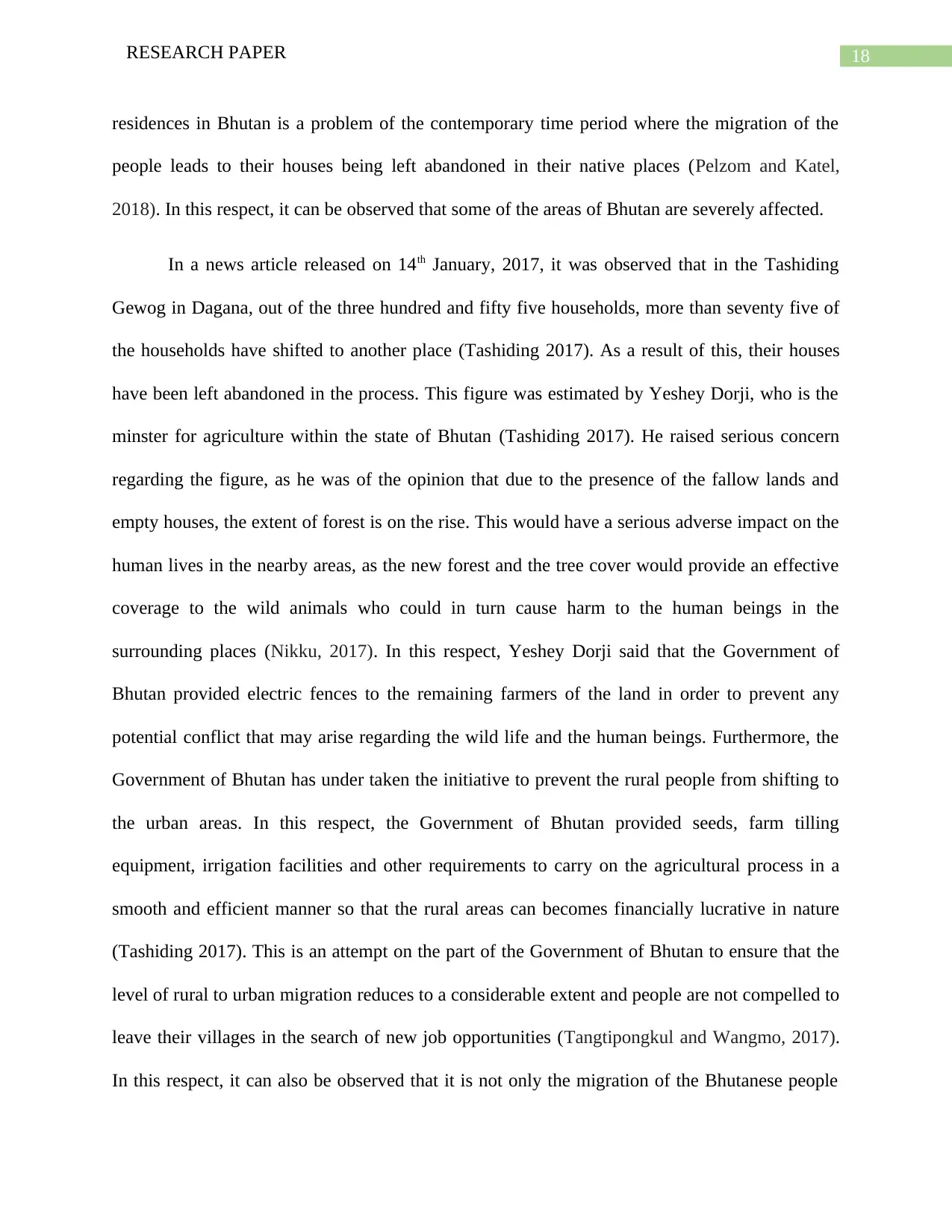
18RESEARCH PAPER
residences in Bhutan is a problem of the contemporary time period where the migration of the
people leads to their houses being left abandoned in their native places (Pelzom and Katel,
2018). In this respect, it can be observed that some of the areas of Bhutan are severely affected.
In a news article released on 14th January, 2017, it was observed that in the Tashiding
Gewog in Dagana, out of the three hundred and fifty five households, more than seventy five of
the households have shifted to another place (Tashiding 2017). As a result of this, their houses
have been left abandoned in the process. This figure was estimated by Yeshey Dorji, who is the
minster for agriculture within the state of Bhutan (Tashiding 2017). He raised serious concern
regarding the figure, as he was of the opinion that due to the presence of the fallow lands and
empty houses, the extent of forest is on the rise. This would have a serious adverse impact on the
human lives in the nearby areas, as the new forest and the tree cover would provide an effective
coverage to the wild animals who could in turn cause harm to the human beings in the
surrounding places (Nikku, 2017). In this respect, Yeshey Dorji said that the Government of
Bhutan provided electric fences to the remaining farmers of the land in order to prevent any
potential conflict that may arise regarding the wild life and the human beings. Furthermore, the
Government of Bhutan has under taken the initiative to prevent the rural people from shifting to
the urban areas. In this respect, the Government of Bhutan provided seeds, farm tilling
equipment, irrigation facilities and other requirements to carry on the agricultural process in a
smooth and efficient manner so that the rural areas can becomes financially lucrative in nature
(Tashiding 2017). This is an attempt on the part of the Government of Bhutan to ensure that the
level of rural to urban migration reduces to a considerable extent and people are not compelled to
leave their villages in the search of new job opportunities (Tangtipongkul and Wangmo, 2017).
In this respect, it can also be observed that it is not only the migration of the Bhutanese people
residences in Bhutan is a problem of the contemporary time period where the migration of the
people leads to their houses being left abandoned in their native places (Pelzom and Katel,
2018). In this respect, it can be observed that some of the areas of Bhutan are severely affected.
In a news article released on 14th January, 2017, it was observed that in the Tashiding
Gewog in Dagana, out of the three hundred and fifty five households, more than seventy five of
the households have shifted to another place (Tashiding 2017). As a result of this, their houses
have been left abandoned in the process. This figure was estimated by Yeshey Dorji, who is the
minster for agriculture within the state of Bhutan (Tashiding 2017). He raised serious concern
regarding the figure, as he was of the opinion that due to the presence of the fallow lands and
empty houses, the extent of forest is on the rise. This would have a serious adverse impact on the
human lives in the nearby areas, as the new forest and the tree cover would provide an effective
coverage to the wild animals who could in turn cause harm to the human beings in the
surrounding places (Nikku, 2017). In this respect, Yeshey Dorji said that the Government of
Bhutan provided electric fences to the remaining farmers of the land in order to prevent any
potential conflict that may arise regarding the wild life and the human beings. Furthermore, the
Government of Bhutan has under taken the initiative to prevent the rural people from shifting to
the urban areas. In this respect, the Government of Bhutan provided seeds, farm tilling
equipment, irrigation facilities and other requirements to carry on the agricultural process in a
smooth and efficient manner so that the rural areas can becomes financially lucrative in nature
(Tashiding 2017). This is an attempt on the part of the Government of Bhutan to ensure that the
level of rural to urban migration reduces to a considerable extent and people are not compelled to
leave their villages in the search of new job opportunities (Tangtipongkul and Wangmo, 2017).
In this respect, it can also be observed that it is not only the migration of the Bhutanese people
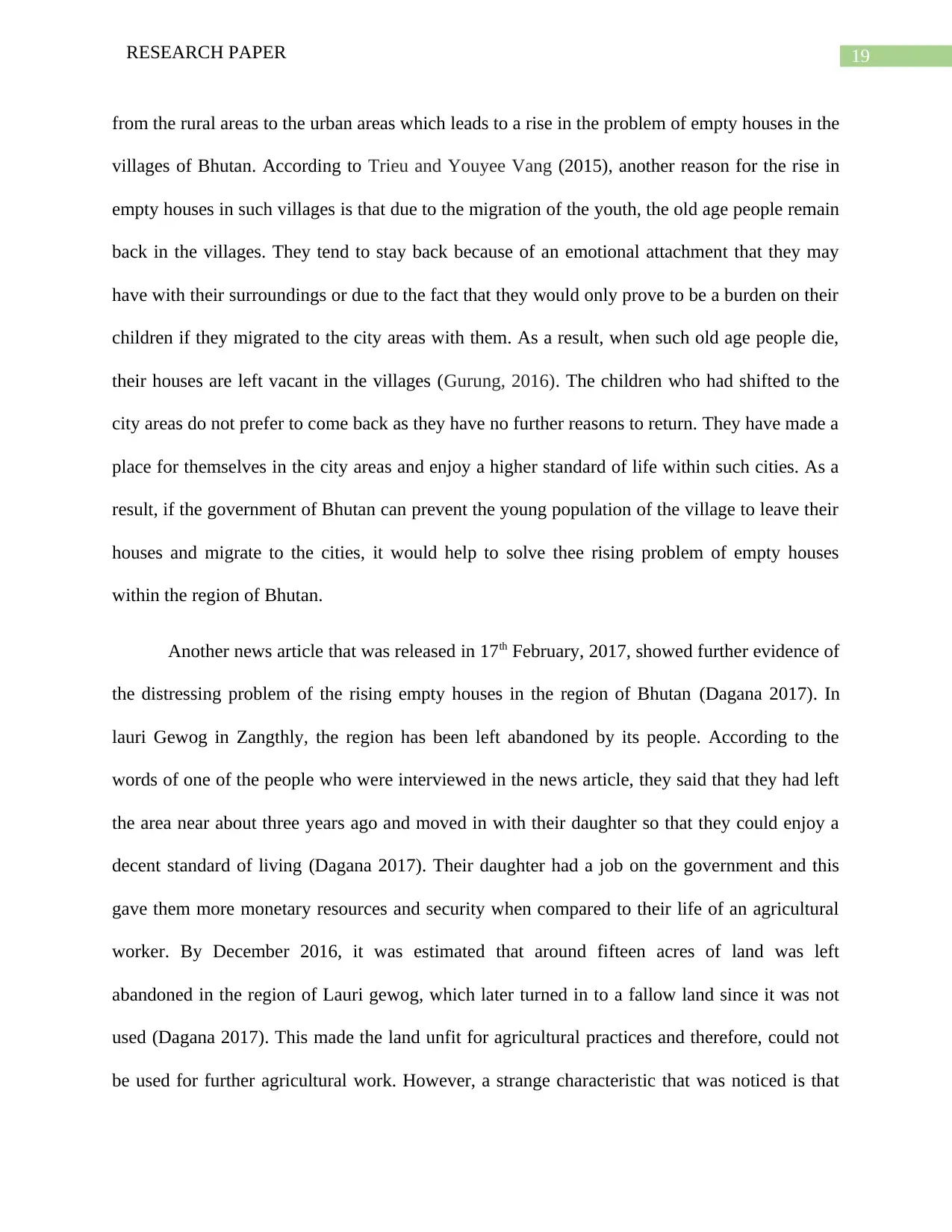
19RESEARCH PAPER
from the rural areas to the urban areas which leads to a rise in the problem of empty houses in the
villages of Bhutan. According to Trieu and Youyee Vang (2015), another reason for the rise in
empty houses in such villages is that due to the migration of the youth, the old age people remain
back in the villages. They tend to stay back because of an emotional attachment that they may
have with their surroundings or due to the fact that they would only prove to be a burden on their
children if they migrated to the city areas with them. As a result, when such old age people die,
their houses are left vacant in the villages (Gurung, 2016). The children who had shifted to the
city areas do not prefer to come back as they have no further reasons to return. They have made a
place for themselves in the city areas and enjoy a higher standard of life within such cities. As a
result, if the government of Bhutan can prevent the young population of the village to leave their
houses and migrate to the cities, it would help to solve thee rising problem of empty houses
within the region of Bhutan.
Another news article that was released in 17th February, 2017, showed further evidence of
the distressing problem of the rising empty houses in the region of Bhutan (Dagana 2017). In
lauri Gewog in Zangthly, the region has been left abandoned by its people. According to the
words of one of the people who were interviewed in the news article, they said that they had left
the area near about three years ago and moved in with their daughter so that they could enjoy a
decent standard of living (Dagana 2017). Their daughter had a job on the government and this
gave them more monetary resources and security when compared to their life of an agricultural
worker. By December 2016, it was estimated that around fifteen acres of land was left
abandoned in the region of Lauri gewog, which later turned in to a fallow land since it was not
used (Dagana 2017). This made the land unfit for agricultural practices and therefore, could not
be used for further agricultural work. However, a strange characteristic that was noticed is that
from the rural areas to the urban areas which leads to a rise in the problem of empty houses in the
villages of Bhutan. According to Trieu and Youyee Vang (2015), another reason for the rise in
empty houses in such villages is that due to the migration of the youth, the old age people remain
back in the villages. They tend to stay back because of an emotional attachment that they may
have with their surroundings or due to the fact that they would only prove to be a burden on their
children if they migrated to the city areas with them. As a result, when such old age people die,
their houses are left vacant in the villages (Gurung, 2016). The children who had shifted to the
city areas do not prefer to come back as they have no further reasons to return. They have made a
place for themselves in the city areas and enjoy a higher standard of life within such cities. As a
result, if the government of Bhutan can prevent the young population of the village to leave their
houses and migrate to the cities, it would help to solve thee rising problem of empty houses
within the region of Bhutan.
Another news article that was released in 17th February, 2017, showed further evidence of
the distressing problem of the rising empty houses in the region of Bhutan (Dagana 2017). In
lauri Gewog in Zangthly, the region has been left abandoned by its people. According to the
words of one of the people who were interviewed in the news article, they said that they had left
the area near about three years ago and moved in with their daughter so that they could enjoy a
decent standard of living (Dagana 2017). Their daughter had a job on the government and this
gave them more monetary resources and security when compared to their life of an agricultural
worker. By December 2016, it was estimated that around fifteen acres of land was left
abandoned in the region of Lauri gewog, which later turned in to a fallow land since it was not
used (Dagana 2017). This made the land unfit for agricultural practices and therefore, could not
be used for further agricultural work. However, a strange characteristic that was noticed is that
Paraphrase This Document
Need a fresh take? Get an instant paraphrase of this document with our AI Paraphraser
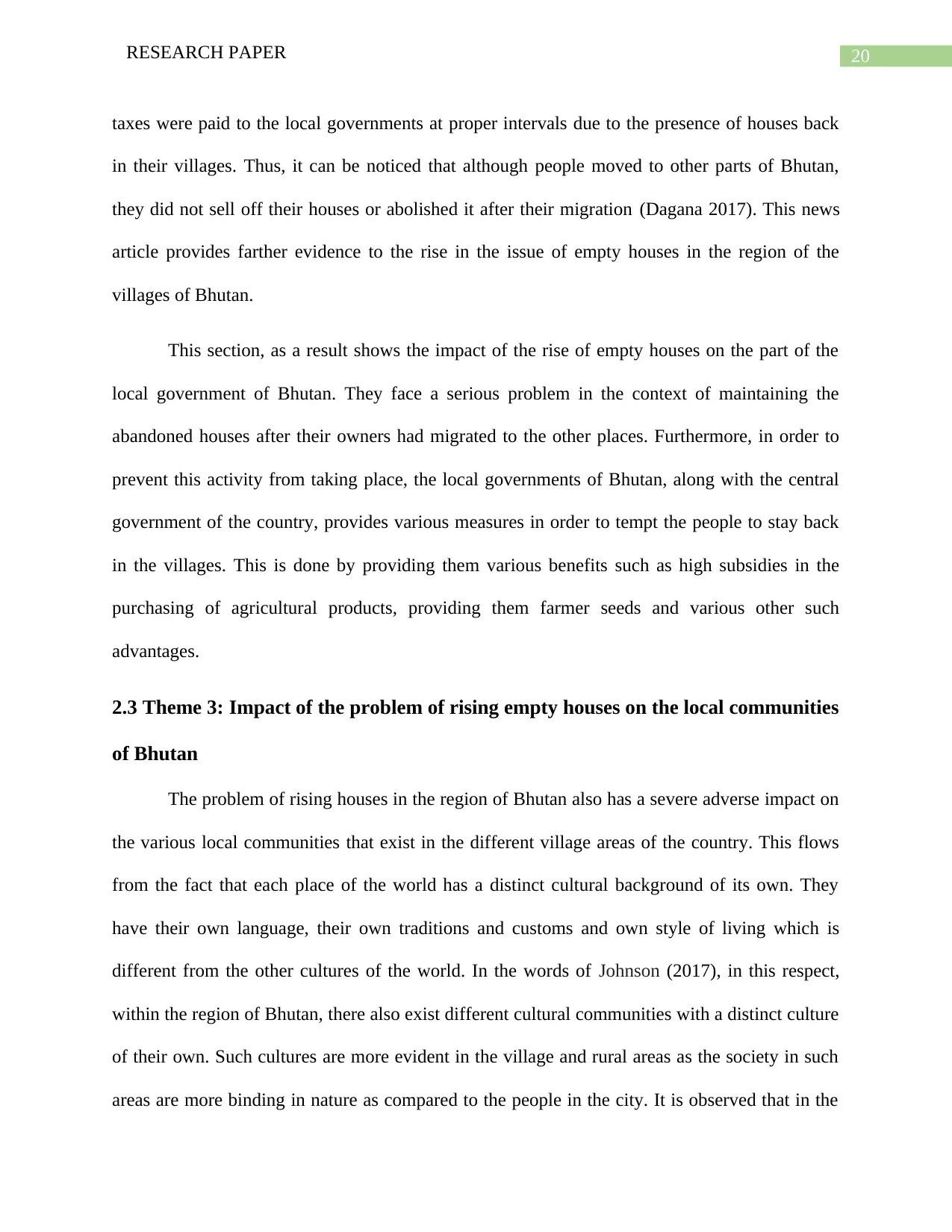
20RESEARCH PAPER
taxes were paid to the local governments at proper intervals due to the presence of houses back
in their villages. Thus, it can be noticed that although people moved to other parts of Bhutan,
they did not sell off their houses or abolished it after their migration (Dagana 2017). This news
article provides farther evidence to the rise in the issue of empty houses in the region of the
villages of Bhutan.
This section, as a result shows the impact of the rise of empty houses on the part of the
local government of Bhutan. They face a serious problem in the context of maintaining the
abandoned houses after their owners had migrated to the other places. Furthermore, in order to
prevent this activity from taking place, the local governments of Bhutan, along with the central
government of the country, provides various measures in order to tempt the people to stay back
in the villages. This is done by providing them various benefits such as high subsidies in the
purchasing of agricultural products, providing them farmer seeds and various other such
advantages.
2.3 Theme 3: Impact of the problem of rising empty houses on the local communities
of Bhutan
The problem of rising houses in the region of Bhutan also has a severe adverse impact on
the various local communities that exist in the different village areas of the country. This flows
from the fact that each place of the world has a distinct cultural background of its own. They
have their own language, their own traditions and customs and own style of living which is
different from the other cultures of the world. In the words of Johnson (2017), in this respect,
within the region of Bhutan, there also exist different cultural communities with a distinct culture
of their own. Such cultures are more evident in the village and rural areas as the society in such
areas are more binding in nature as compared to the people in the city. It is observed that in the
taxes were paid to the local governments at proper intervals due to the presence of houses back
in their villages. Thus, it can be noticed that although people moved to other parts of Bhutan,
they did not sell off their houses or abolished it after their migration (Dagana 2017). This news
article provides farther evidence to the rise in the issue of empty houses in the region of the
villages of Bhutan.
This section, as a result shows the impact of the rise of empty houses on the part of the
local government of Bhutan. They face a serious problem in the context of maintaining the
abandoned houses after their owners had migrated to the other places. Furthermore, in order to
prevent this activity from taking place, the local governments of Bhutan, along with the central
government of the country, provides various measures in order to tempt the people to stay back
in the villages. This is done by providing them various benefits such as high subsidies in the
purchasing of agricultural products, providing them farmer seeds and various other such
advantages.
2.3 Theme 3: Impact of the problem of rising empty houses on the local communities
of Bhutan
The problem of rising houses in the region of Bhutan also has a severe adverse impact on
the various local communities that exist in the different village areas of the country. This flows
from the fact that each place of the world has a distinct cultural background of its own. They
have their own language, their own traditions and customs and own style of living which is
different from the other cultures of the world. In the words of Johnson (2017), in this respect,
within the region of Bhutan, there also exist different cultural communities with a distinct culture
of their own. Such cultures are more evident in the village and rural areas as the society in such
areas are more binding in nature as compared to the people in the city. It is observed that in the
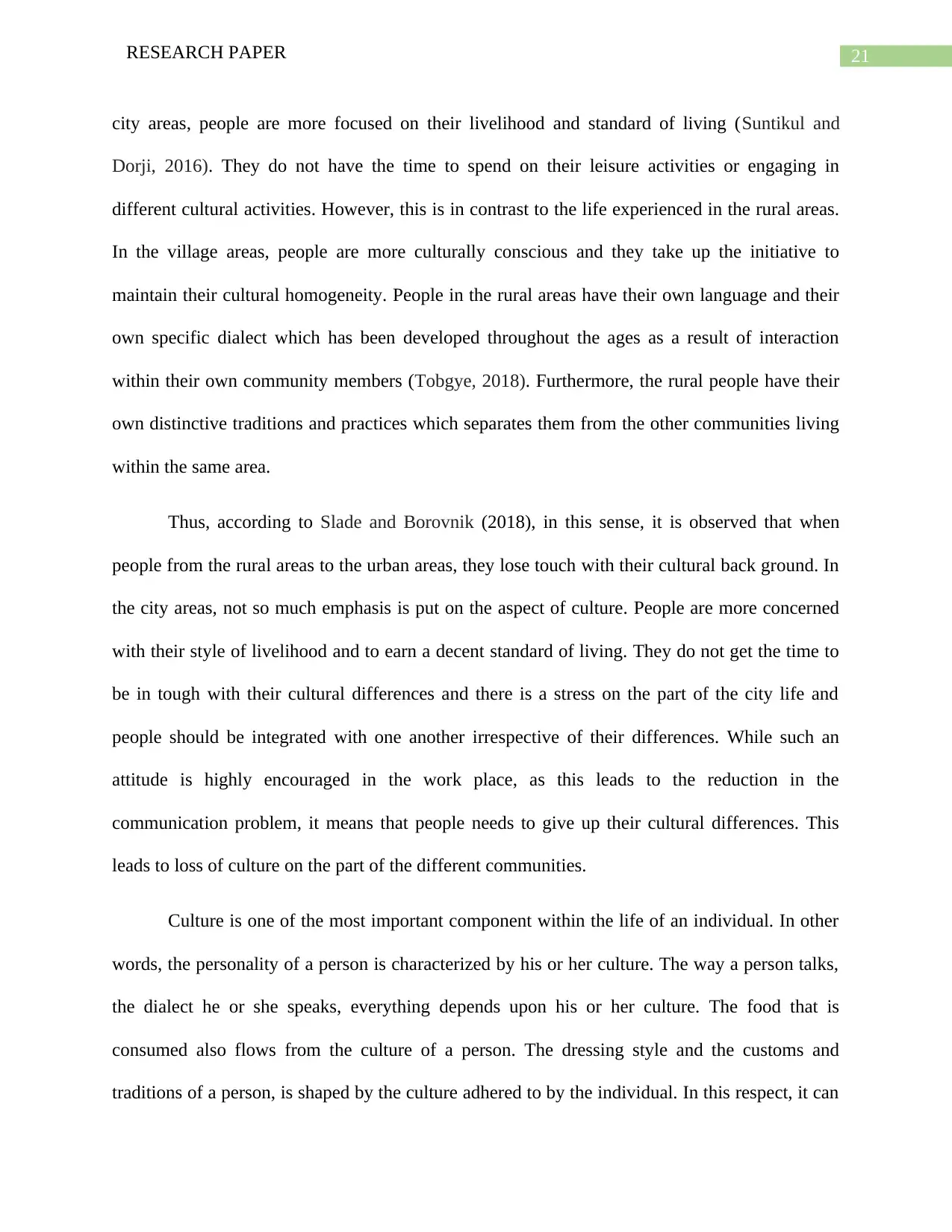
21RESEARCH PAPER
city areas, people are more focused on their livelihood and standard of living (Suntikul and
Dorji, 2016). They do not have the time to spend on their leisure activities or engaging in
different cultural activities. However, this is in contrast to the life experienced in the rural areas.
In the village areas, people are more culturally conscious and they take up the initiative to
maintain their cultural homogeneity. People in the rural areas have their own language and their
own specific dialect which has been developed throughout the ages as a result of interaction
within their own community members (Tobgye, 2018). Furthermore, the rural people have their
own distinctive traditions and practices which separates them from the other communities living
within the same area.
Thus, according to Slade and Borovnik (2018), in this sense, it is observed that when
people from the rural areas to the urban areas, they lose touch with their cultural back ground. In
the city areas, not so much emphasis is put on the aspect of culture. People are more concerned
with their style of livelihood and to earn a decent standard of living. They do not get the time to
be in tough with their cultural differences and there is a stress on the part of the city life and
people should be integrated with one another irrespective of their differences. While such an
attitude is highly encouraged in the work place, as this leads to the reduction in the
communication problem, it means that people needs to give up their cultural differences. This
leads to loss of culture on the part of the different communities.
Culture is one of the most important component within the life of an individual. In other
words, the personality of a person is characterized by his or her culture. The way a person talks,
the dialect he or she speaks, everything depends upon his or her culture. The food that is
consumed also flows from the culture of a person. The dressing style and the customs and
traditions of a person, is shaped by the culture adhered to by the individual. In this respect, it can
city areas, people are more focused on their livelihood and standard of living (Suntikul and
Dorji, 2016). They do not have the time to spend on their leisure activities or engaging in
different cultural activities. However, this is in contrast to the life experienced in the rural areas.
In the village areas, people are more culturally conscious and they take up the initiative to
maintain their cultural homogeneity. People in the rural areas have their own language and their
own specific dialect which has been developed throughout the ages as a result of interaction
within their own community members (Tobgye, 2018). Furthermore, the rural people have their
own distinctive traditions and practices which separates them from the other communities living
within the same area.
Thus, according to Slade and Borovnik (2018), in this sense, it is observed that when
people from the rural areas to the urban areas, they lose touch with their cultural back ground. In
the city areas, not so much emphasis is put on the aspect of culture. People are more concerned
with their style of livelihood and to earn a decent standard of living. They do not get the time to
be in tough with their cultural differences and there is a stress on the part of the city life and
people should be integrated with one another irrespective of their differences. While such an
attitude is highly encouraged in the work place, as this leads to the reduction in the
communication problem, it means that people needs to give up their cultural differences. This
leads to loss of culture on the part of the different communities.
Culture is one of the most important component within the life of an individual. In other
words, the personality of a person is characterized by his or her culture. The way a person talks,
the dialect he or she speaks, everything depends upon his or her culture. The food that is
consumed also flows from the culture of a person. The dressing style and the customs and
traditions of a person, is shaped by the culture adhered to by the individual. In this respect, it can
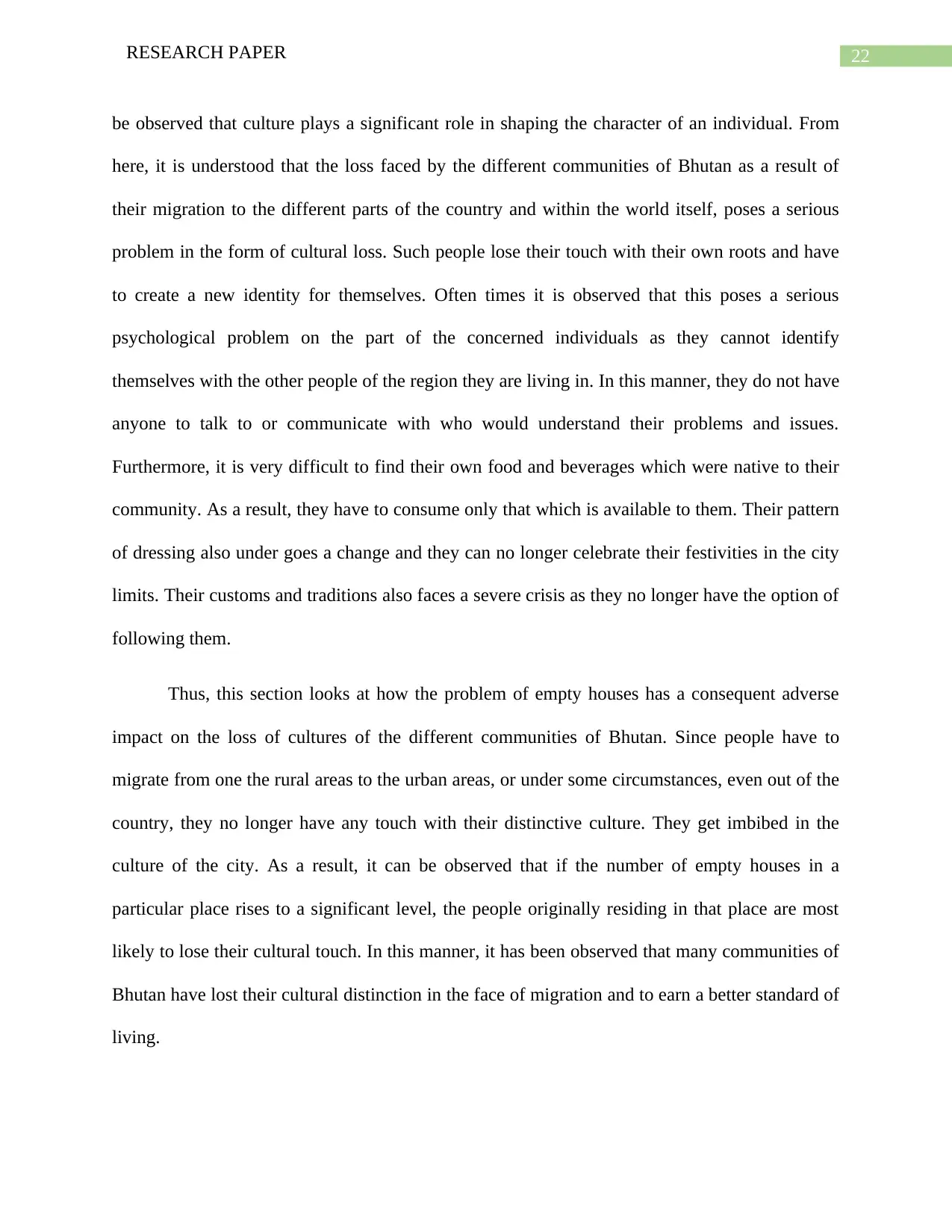
22RESEARCH PAPER
be observed that culture plays a significant role in shaping the character of an individual. From
here, it is understood that the loss faced by the different communities of Bhutan as a result of
their migration to the different parts of the country and within the world itself, poses a serious
problem in the form of cultural loss. Such people lose their touch with their own roots and have
to create a new identity for themselves. Often times it is observed that this poses a serious
psychological problem on the part of the concerned individuals as they cannot identify
themselves with the other people of the region they are living in. In this manner, they do not have
anyone to talk to or communicate with who would understand their problems and issues.
Furthermore, it is very difficult to find their own food and beverages which were native to their
community. As a result, they have to consume only that which is available to them. Their pattern
of dressing also under goes a change and they can no longer celebrate their festivities in the city
limits. Their customs and traditions also faces a severe crisis as they no longer have the option of
following them.
Thus, this section looks at how the problem of empty houses has a consequent adverse
impact on the loss of cultures of the different communities of Bhutan. Since people have to
migrate from one the rural areas to the urban areas, or under some circumstances, even out of the
country, they no longer have any touch with their distinctive culture. They get imbibed in the
culture of the city. As a result, it can be observed that if the number of empty houses in a
particular place rises to a significant level, the people originally residing in that place are most
likely to lose their cultural touch. In this manner, it has been observed that many communities of
Bhutan have lost their cultural distinction in the face of migration and to earn a better standard of
living.
be observed that culture plays a significant role in shaping the character of an individual. From
here, it is understood that the loss faced by the different communities of Bhutan as a result of
their migration to the different parts of the country and within the world itself, poses a serious
problem in the form of cultural loss. Such people lose their touch with their own roots and have
to create a new identity for themselves. Often times it is observed that this poses a serious
psychological problem on the part of the concerned individuals as they cannot identify
themselves with the other people of the region they are living in. In this manner, they do not have
anyone to talk to or communicate with who would understand their problems and issues.
Furthermore, it is very difficult to find their own food and beverages which were native to their
community. As a result, they have to consume only that which is available to them. Their pattern
of dressing also under goes a change and they can no longer celebrate their festivities in the city
limits. Their customs and traditions also faces a severe crisis as they no longer have the option of
following them.
Thus, this section looks at how the problem of empty houses has a consequent adverse
impact on the loss of cultures of the different communities of Bhutan. Since people have to
migrate from one the rural areas to the urban areas, or under some circumstances, even out of the
country, they no longer have any touch with their distinctive culture. They get imbibed in the
culture of the city. As a result, it can be observed that if the number of empty houses in a
particular place rises to a significant level, the people originally residing in that place are most
likely to lose their cultural touch. In this manner, it has been observed that many communities of
Bhutan have lost their cultural distinction in the face of migration and to earn a better standard of
living.
Secure Best Marks with AI Grader
Need help grading? Try our AI Grader for instant feedback on your assignments.
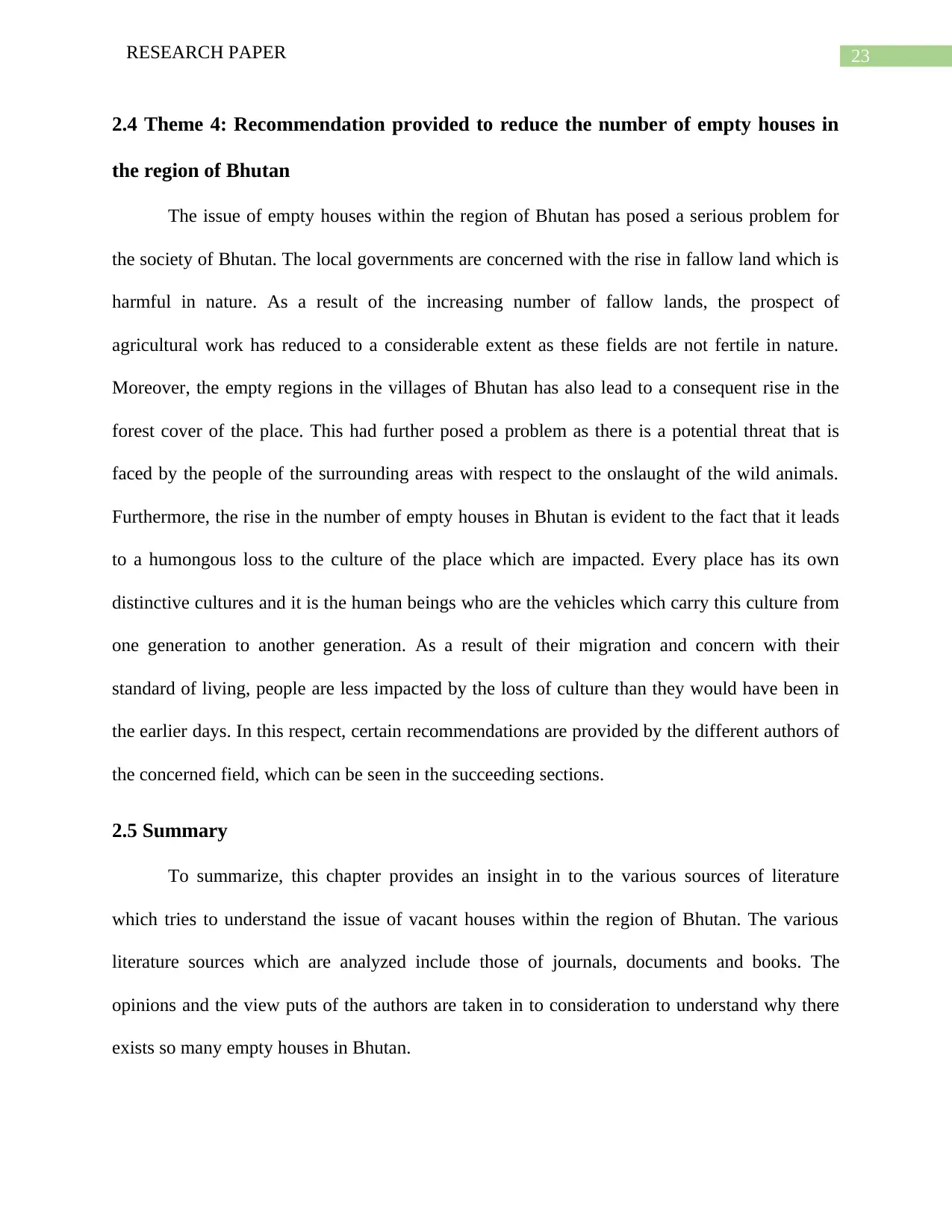
23RESEARCH PAPER
2.4 Theme 4: Recommendation provided to reduce the number of empty houses in
the region of Bhutan
The issue of empty houses within the region of Bhutan has posed a serious problem for
the society of Bhutan. The local governments are concerned with the rise in fallow land which is
harmful in nature. As a result of the increasing number of fallow lands, the prospect of
agricultural work has reduced to a considerable extent as these fields are not fertile in nature.
Moreover, the empty regions in the villages of Bhutan has also lead to a consequent rise in the
forest cover of the place. This had further posed a problem as there is a potential threat that is
faced by the people of the surrounding areas with respect to the onslaught of the wild animals.
Furthermore, the rise in the number of empty houses in Bhutan is evident to the fact that it leads
to a humongous loss to the culture of the place which are impacted. Every place has its own
distinctive cultures and it is the human beings who are the vehicles which carry this culture from
one generation to another generation. As a result of their migration and concern with their
standard of living, people are less impacted by the loss of culture than they would have been in
the earlier days. In this respect, certain recommendations are provided by the different authors of
the concerned field, which can be seen in the succeeding sections.
2.5 Summary
To summarize, this chapter provides an insight in to the various sources of literature
which tries to understand the issue of vacant houses within the region of Bhutan. The various
literature sources which are analyzed include those of journals, documents and books. The
opinions and the view puts of the authors are taken in to consideration to understand why there
exists so many empty houses in Bhutan.
2.4 Theme 4: Recommendation provided to reduce the number of empty houses in
the region of Bhutan
The issue of empty houses within the region of Bhutan has posed a serious problem for
the society of Bhutan. The local governments are concerned with the rise in fallow land which is
harmful in nature. As a result of the increasing number of fallow lands, the prospect of
agricultural work has reduced to a considerable extent as these fields are not fertile in nature.
Moreover, the empty regions in the villages of Bhutan has also lead to a consequent rise in the
forest cover of the place. This had further posed a problem as there is a potential threat that is
faced by the people of the surrounding areas with respect to the onslaught of the wild animals.
Furthermore, the rise in the number of empty houses in Bhutan is evident to the fact that it leads
to a humongous loss to the culture of the place which are impacted. Every place has its own
distinctive cultures and it is the human beings who are the vehicles which carry this culture from
one generation to another generation. As a result of their migration and concern with their
standard of living, people are less impacted by the loss of culture than they would have been in
the earlier days. In this respect, certain recommendations are provided by the different authors of
the concerned field, which can be seen in the succeeding sections.
2.5 Summary
To summarize, this chapter provides an insight in to the various sources of literature
which tries to understand the issue of vacant houses within the region of Bhutan. The various
literature sources which are analyzed include those of journals, documents and books. The
opinions and the view puts of the authors are taken in to consideration to understand why there
exists so many empty houses in Bhutan.
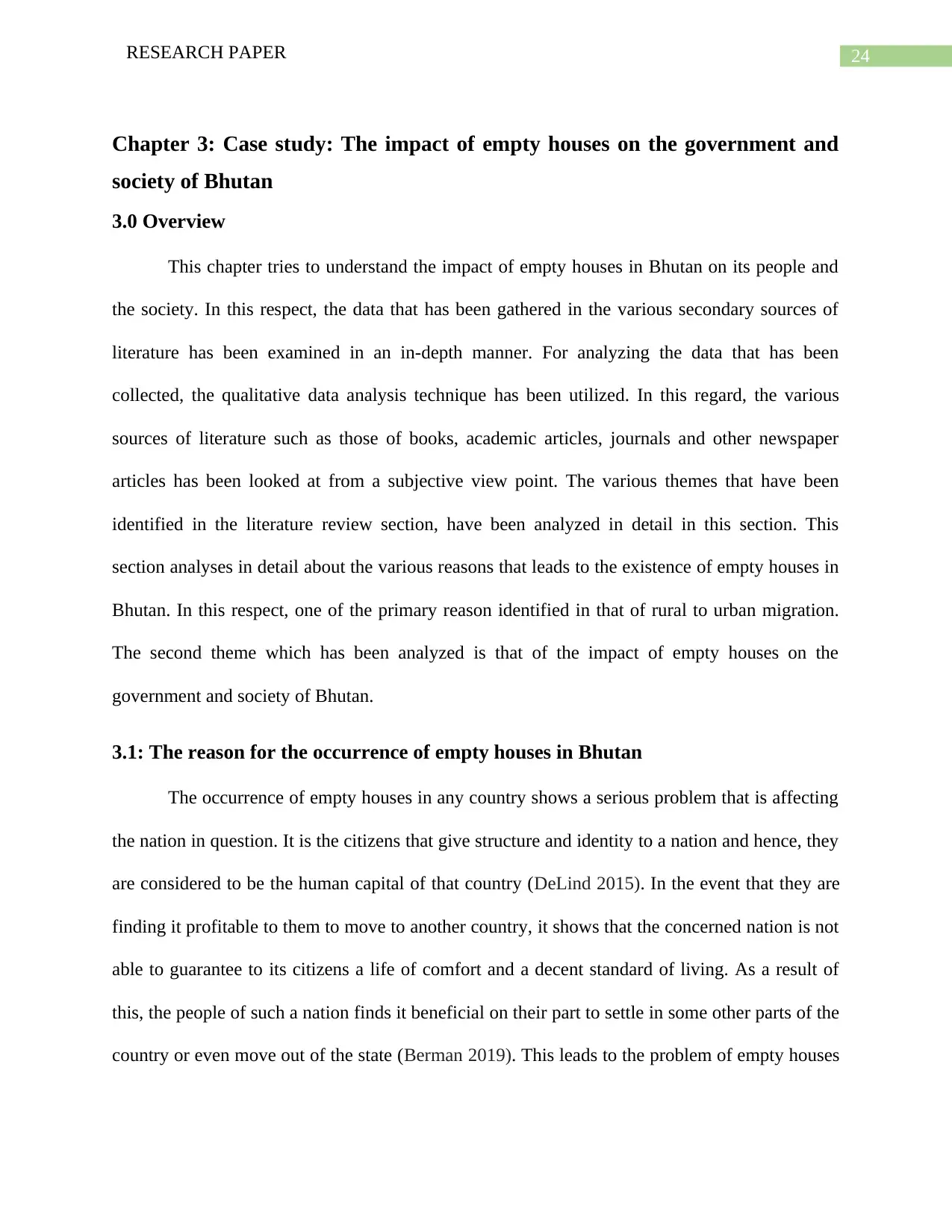
24RESEARCH PAPER
Chapter 3: Case study: The impact of empty houses on the government and
society of Bhutan
3.0 Overview
This chapter tries to understand the impact of empty houses in Bhutan on its people and
the society. In this respect, the data that has been gathered in the various secondary sources of
literature has been examined in an in-depth manner. For analyzing the data that has been
collected, the qualitative data analysis technique has been utilized. In this regard, the various
sources of literature such as those of books, academic articles, journals and other newspaper
articles has been looked at from a subjective view point. The various themes that have been
identified in the literature review section, have been analyzed in detail in this section. This
section analyses in detail about the various reasons that leads to the existence of empty houses in
Bhutan. In this respect, one of the primary reason identified in that of rural to urban migration.
The second theme which has been analyzed is that of the impact of empty houses on the
government and society of Bhutan.
3.1: The reason for the occurrence of empty houses in Bhutan
The occurrence of empty houses in any country shows a serious problem that is affecting
the nation in question. It is the citizens that give structure and identity to a nation and hence, they
are considered to be the human capital of that country (DeLind 2015). In the event that they are
finding it profitable to them to move to another country, it shows that the concerned nation is not
able to guarantee to its citizens a life of comfort and a decent standard of living. As a result of
this, the people of such a nation finds it beneficial on their part to settle in some other parts of the
country or even move out of the state (Berman 2019). This leads to the problem of empty houses
Chapter 3: Case study: The impact of empty houses on the government and
society of Bhutan
3.0 Overview
This chapter tries to understand the impact of empty houses in Bhutan on its people and
the society. In this respect, the data that has been gathered in the various secondary sources of
literature has been examined in an in-depth manner. For analyzing the data that has been
collected, the qualitative data analysis technique has been utilized. In this regard, the various
sources of literature such as those of books, academic articles, journals and other newspaper
articles has been looked at from a subjective view point. The various themes that have been
identified in the literature review section, have been analyzed in detail in this section. This
section analyses in detail about the various reasons that leads to the existence of empty houses in
Bhutan. In this respect, one of the primary reason identified in that of rural to urban migration.
The second theme which has been analyzed is that of the impact of empty houses on the
government and society of Bhutan.
3.1: The reason for the occurrence of empty houses in Bhutan
The occurrence of empty houses in any country shows a serious problem that is affecting
the nation in question. It is the citizens that give structure and identity to a nation and hence, they
are considered to be the human capital of that country (DeLind 2015). In the event that they are
finding it profitable to them to move to another country, it shows that the concerned nation is not
able to guarantee to its citizens a life of comfort and a decent standard of living. As a result of
this, the people of such a nation finds it beneficial on their part to settle in some other parts of the
country or even move out of the state (Berman 2019). This leads to the problem of empty houses
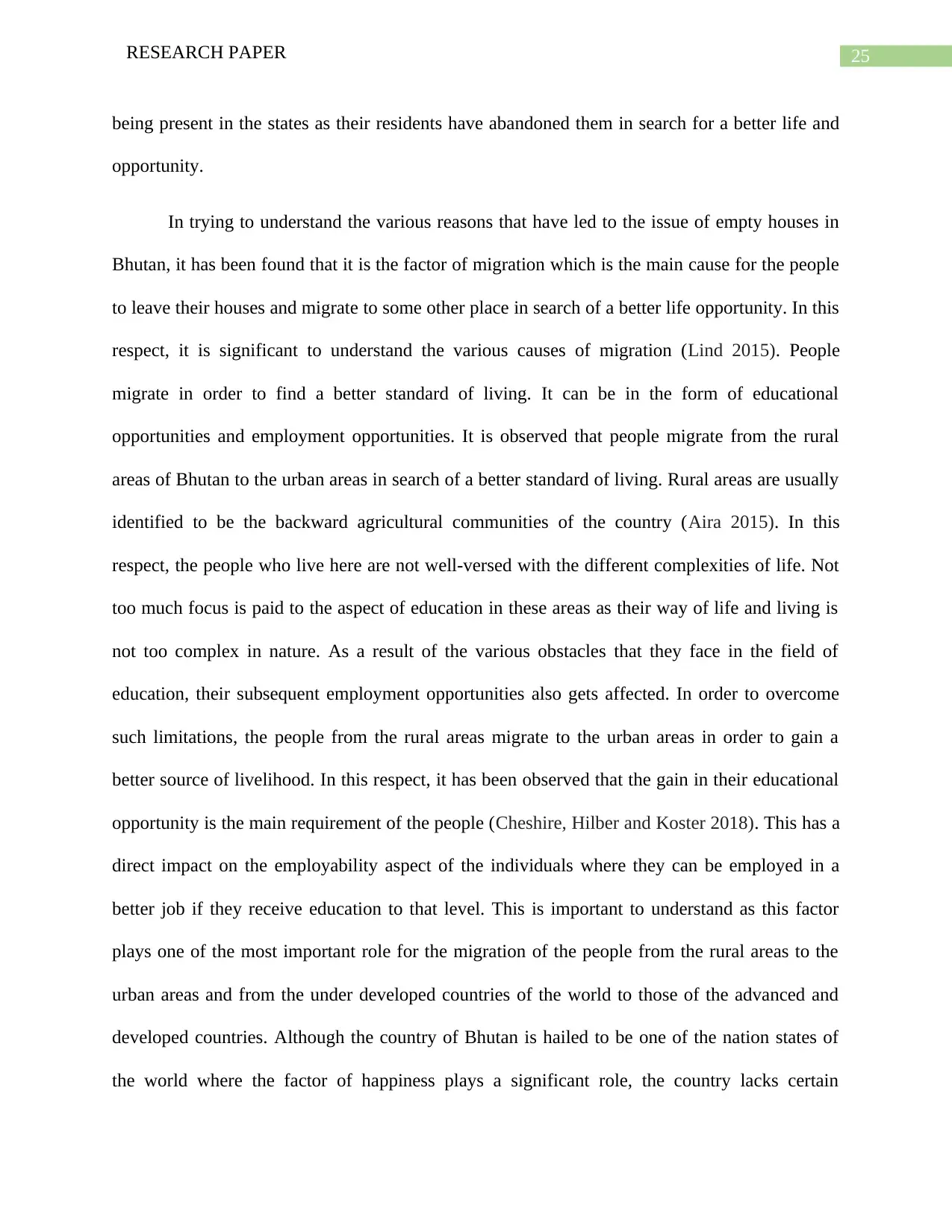
25RESEARCH PAPER
being present in the states as their residents have abandoned them in search for a better life and
opportunity.
In trying to understand the various reasons that have led to the issue of empty houses in
Bhutan, it has been found that it is the factor of migration which is the main cause for the people
to leave their houses and migrate to some other place in search of a better life opportunity. In this
respect, it is significant to understand the various causes of migration (Lind 2015). People
migrate in order to find a better standard of living. It can be in the form of educational
opportunities and employment opportunities. It is observed that people migrate from the rural
areas of Bhutan to the urban areas in search of a better standard of living. Rural areas are usually
identified to be the backward agricultural communities of the country (Aira 2015). In this
respect, the people who live here are not well-versed with the different complexities of life. Not
too much focus is paid to the aspect of education in these areas as their way of life and living is
not too complex in nature. As a result of the various obstacles that they face in the field of
education, their subsequent employment opportunities also gets affected. In order to overcome
such limitations, the people from the rural areas migrate to the urban areas in order to gain a
better source of livelihood. In this respect, it has been observed that the gain in their educational
opportunity is the main requirement of the people (Cheshire, Hilber and Koster 2018). This has a
direct impact on the employability aspect of the individuals where they can be employed in a
better job if they receive education to that level. This is important to understand as this factor
plays one of the most important role for the migration of the people from the rural areas to the
urban areas and from the under developed countries of the world to those of the advanced and
developed countries. Although the country of Bhutan is hailed to be one of the nation states of
the world where the factor of happiness plays a significant role, the country lacks certain
being present in the states as their residents have abandoned them in search for a better life and
opportunity.
In trying to understand the various reasons that have led to the issue of empty houses in
Bhutan, it has been found that it is the factor of migration which is the main cause for the people
to leave their houses and migrate to some other place in search of a better life opportunity. In this
respect, it is significant to understand the various causes of migration (Lind 2015). People
migrate in order to find a better standard of living. It can be in the form of educational
opportunities and employment opportunities. It is observed that people migrate from the rural
areas of Bhutan to the urban areas in search of a better standard of living. Rural areas are usually
identified to be the backward agricultural communities of the country (Aira 2015). In this
respect, the people who live here are not well-versed with the different complexities of life. Not
too much focus is paid to the aspect of education in these areas as their way of life and living is
not too complex in nature. As a result of the various obstacles that they face in the field of
education, their subsequent employment opportunities also gets affected. In order to overcome
such limitations, the people from the rural areas migrate to the urban areas in order to gain a
better source of livelihood. In this respect, it has been observed that the gain in their educational
opportunity is the main requirement of the people (Cheshire, Hilber and Koster 2018). This has a
direct impact on the employability aspect of the individuals where they can be employed in a
better job if they receive education to that level. This is important to understand as this factor
plays one of the most important role for the migration of the people from the rural areas to the
urban areas and from the under developed countries of the world to those of the advanced and
developed countries. Although the country of Bhutan is hailed to be one of the nation states of
the world where the factor of happiness plays a significant role, the country lacks certain
Paraphrase This Document
Need a fresh take? Get an instant paraphrase of this document with our AI Paraphraser
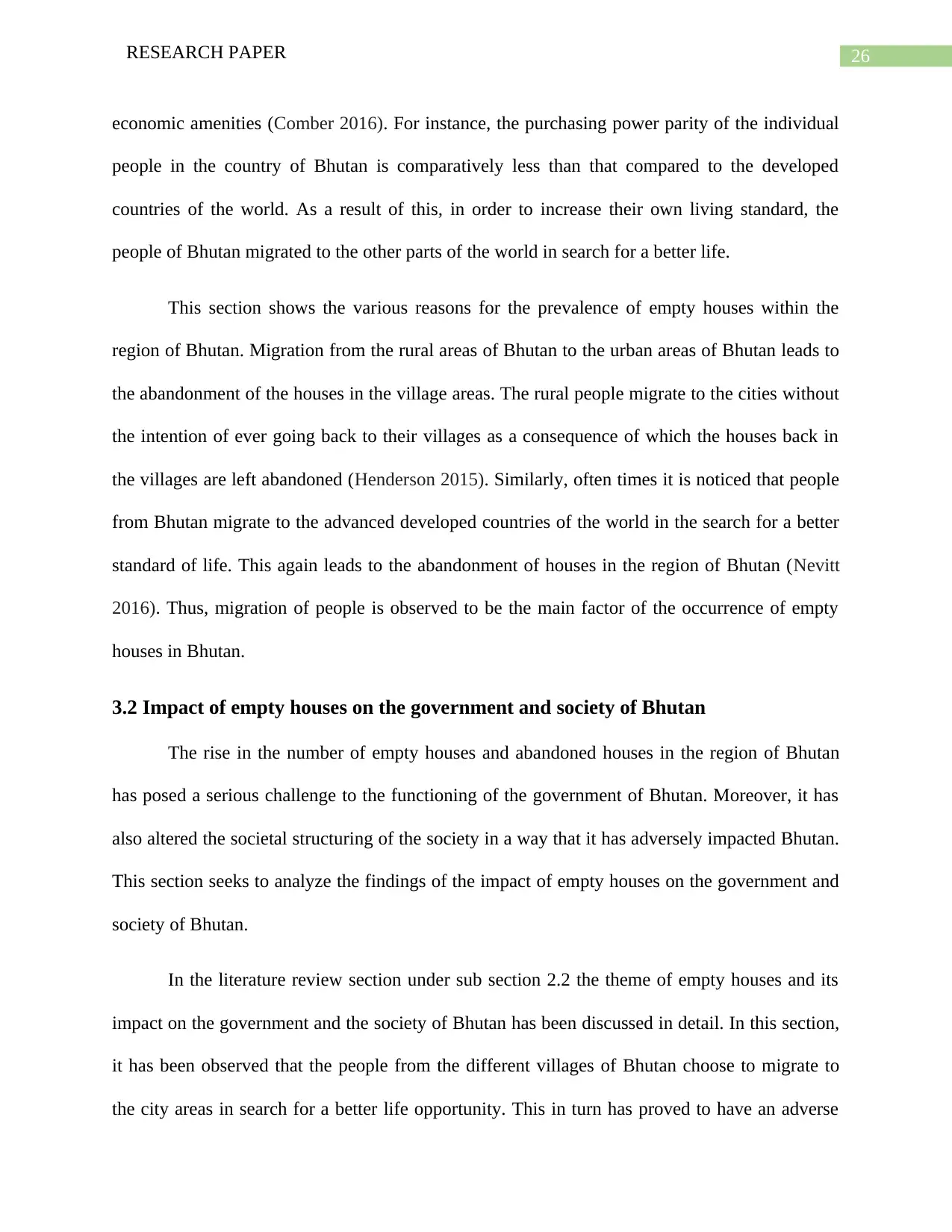
26RESEARCH PAPER
economic amenities (Comber 2016). For instance, the purchasing power parity of the individual
people in the country of Bhutan is comparatively less than that compared to the developed
countries of the world. As a result of this, in order to increase their own living standard, the
people of Bhutan migrated to the other parts of the world in search for a better life.
This section shows the various reasons for the prevalence of empty houses within the
region of Bhutan. Migration from the rural areas of Bhutan to the urban areas of Bhutan leads to
the abandonment of the houses in the village areas. The rural people migrate to the cities without
the intention of ever going back to their villages as a consequence of which the houses back in
the villages are left abandoned (Henderson 2015). Similarly, often times it is noticed that people
from Bhutan migrate to the advanced developed countries of the world in the search for a better
standard of life. This again leads to the abandonment of houses in the region of Bhutan (Nevitt
2016). Thus, migration of people is observed to be the main factor of the occurrence of empty
houses in Bhutan.
3.2 Impact of empty houses on the government and society of Bhutan
The rise in the number of empty houses and abandoned houses in the region of Bhutan
has posed a serious challenge to the functioning of the government of Bhutan. Moreover, it has
also altered the societal structuring of the society in a way that it has adversely impacted Bhutan.
This section seeks to analyze the findings of the impact of empty houses on the government and
society of Bhutan.
In the literature review section under sub section 2.2 the theme of empty houses and its
impact on the government and the society of Bhutan has been discussed in detail. In this section,
it has been observed that the people from the different villages of Bhutan choose to migrate to
the city areas in search for a better life opportunity. This in turn has proved to have an adverse
economic amenities (Comber 2016). For instance, the purchasing power parity of the individual
people in the country of Bhutan is comparatively less than that compared to the developed
countries of the world. As a result of this, in order to increase their own living standard, the
people of Bhutan migrated to the other parts of the world in search for a better life.
This section shows the various reasons for the prevalence of empty houses within the
region of Bhutan. Migration from the rural areas of Bhutan to the urban areas of Bhutan leads to
the abandonment of the houses in the village areas. The rural people migrate to the cities without
the intention of ever going back to their villages as a consequence of which the houses back in
the villages are left abandoned (Henderson 2015). Similarly, often times it is noticed that people
from Bhutan migrate to the advanced developed countries of the world in the search for a better
standard of life. This again leads to the abandonment of houses in the region of Bhutan (Nevitt
2016). Thus, migration of people is observed to be the main factor of the occurrence of empty
houses in Bhutan.
3.2 Impact of empty houses on the government and society of Bhutan
The rise in the number of empty houses and abandoned houses in the region of Bhutan
has posed a serious challenge to the functioning of the government of Bhutan. Moreover, it has
also altered the societal structuring of the society in a way that it has adversely impacted Bhutan.
This section seeks to analyze the findings of the impact of empty houses on the government and
society of Bhutan.
In the literature review section under sub section 2.2 the theme of empty houses and its
impact on the government and the society of Bhutan has been discussed in detail. In this section,
it has been observed that the people from the different villages of Bhutan choose to migrate to
the city areas in search for a better life opportunity. This in turn has proved to have an adverse
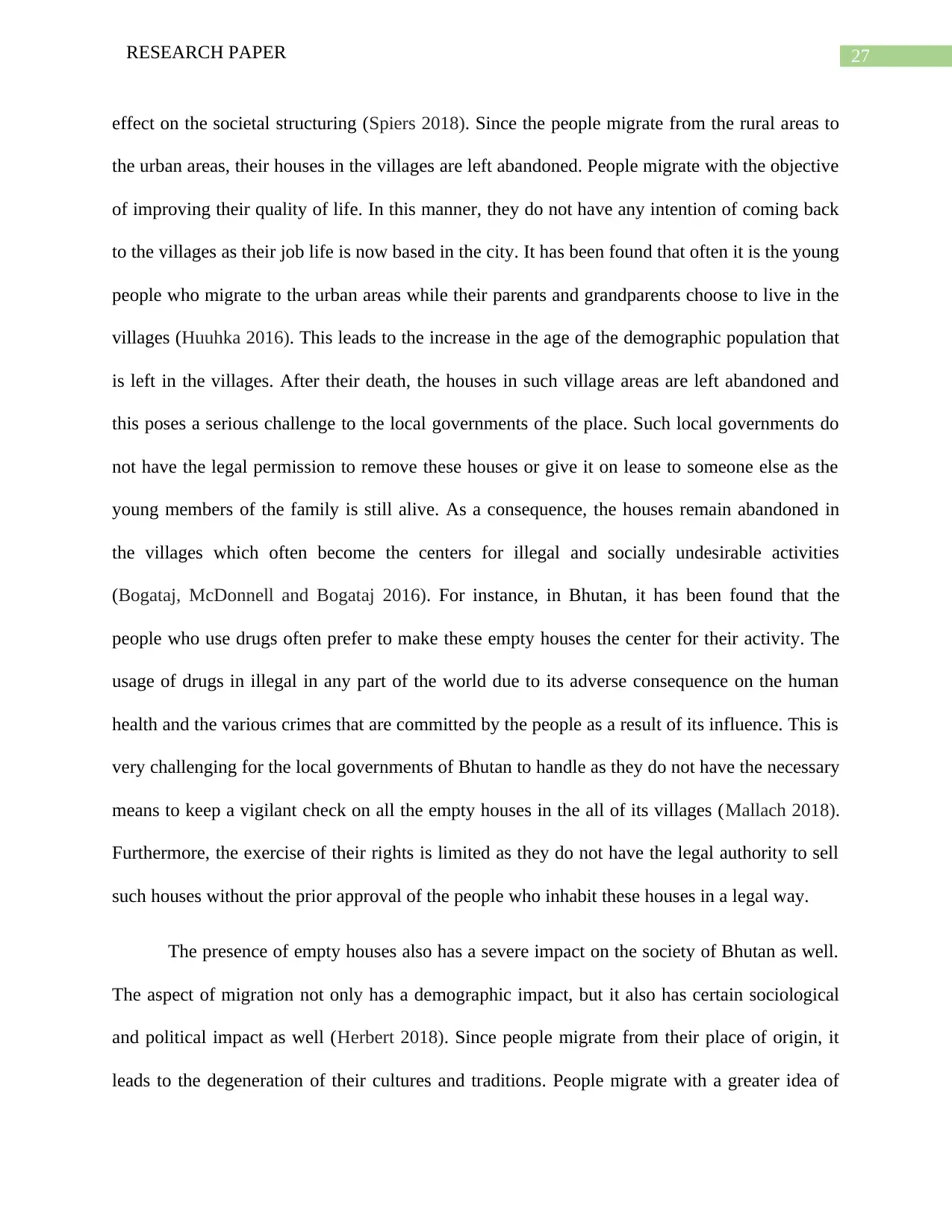
27RESEARCH PAPER
effect on the societal structuring (Spiers 2018). Since the people migrate from the rural areas to
the urban areas, their houses in the villages are left abandoned. People migrate with the objective
of improving their quality of life. In this manner, they do not have any intention of coming back
to the villages as their job life is now based in the city. It has been found that often it is the young
people who migrate to the urban areas while their parents and grandparents choose to live in the
villages (Huuhka 2016). This leads to the increase in the age of the demographic population that
is left in the villages. After their death, the houses in such village areas are left abandoned and
this poses a serious challenge to the local governments of the place. Such local governments do
not have the legal permission to remove these houses or give it on lease to someone else as the
young members of the family is still alive. As a consequence, the houses remain abandoned in
the villages which often become the centers for illegal and socially undesirable activities
(Bogataj, McDonnell and Bogataj 2016). For instance, in Bhutan, it has been found that the
people who use drugs often prefer to make these empty houses the center for their activity. The
usage of drugs in illegal in any part of the world due to its adverse consequence on the human
health and the various crimes that are committed by the people as a result of its influence. This is
very challenging for the local governments of Bhutan to handle as they do not have the necessary
means to keep a vigilant check on all the empty houses in the all of its villages (Mallach 2018).
Furthermore, the exercise of their rights is limited as they do not have the legal authority to sell
such houses without the prior approval of the people who inhabit these houses in a legal way.
The presence of empty houses also has a severe impact on the society of Bhutan as well.
The aspect of migration not only has a demographic impact, but it also has certain sociological
and political impact as well (Herbert 2018). Since people migrate from their place of origin, it
leads to the degeneration of their cultures and traditions. People migrate with a greater idea of
effect on the societal structuring (Spiers 2018). Since the people migrate from the rural areas to
the urban areas, their houses in the villages are left abandoned. People migrate with the objective
of improving their quality of life. In this manner, they do not have any intention of coming back
to the villages as their job life is now based in the city. It has been found that often it is the young
people who migrate to the urban areas while their parents and grandparents choose to live in the
villages (Huuhka 2016). This leads to the increase in the age of the demographic population that
is left in the villages. After their death, the houses in such village areas are left abandoned and
this poses a serious challenge to the local governments of the place. Such local governments do
not have the legal permission to remove these houses or give it on lease to someone else as the
young members of the family is still alive. As a consequence, the houses remain abandoned in
the villages which often become the centers for illegal and socially undesirable activities
(Bogataj, McDonnell and Bogataj 2016). For instance, in Bhutan, it has been found that the
people who use drugs often prefer to make these empty houses the center for their activity. The
usage of drugs in illegal in any part of the world due to its adverse consequence on the human
health and the various crimes that are committed by the people as a result of its influence. This is
very challenging for the local governments of Bhutan to handle as they do not have the necessary
means to keep a vigilant check on all the empty houses in the all of its villages (Mallach 2018).
Furthermore, the exercise of their rights is limited as they do not have the legal authority to sell
such houses without the prior approval of the people who inhabit these houses in a legal way.
The presence of empty houses also has a severe impact on the society of Bhutan as well.
The aspect of migration not only has a demographic impact, but it also has certain sociological
and political impact as well (Herbert 2018). Since people migrate from their place of origin, it
leads to the degeneration of their cultures and traditions. People migrate with a greater idea of
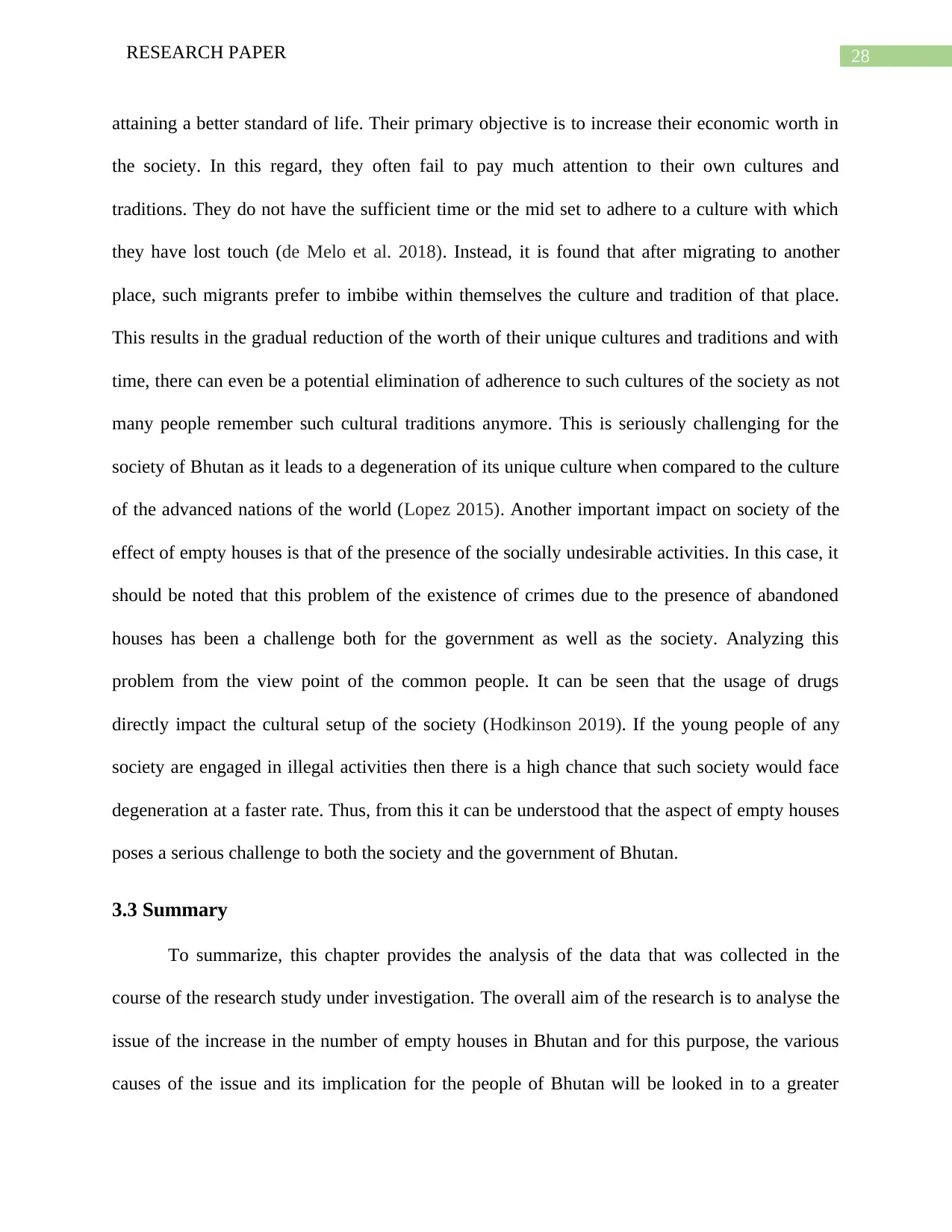
28RESEARCH PAPER
attaining a better standard of life. Their primary objective is to increase their economic worth in
the society. In this regard, they often fail to pay much attention to their own cultures and
traditions. They do not have the sufficient time or the mid set to adhere to a culture with which
they have lost touch (de Melo et al. 2018). Instead, it is found that after migrating to another
place, such migrants prefer to imbibe within themselves the culture and tradition of that place.
This results in the gradual reduction of the worth of their unique cultures and traditions and with
time, there can even be a potential elimination of adherence to such cultures of the society as not
many people remember such cultural traditions anymore. This is seriously challenging for the
society of Bhutan as it leads to a degeneration of its unique culture when compared to the culture
of the advanced nations of the world (Lopez 2015). Another important impact on society of the
effect of empty houses is that of the presence of the socially undesirable activities. In this case, it
should be noted that this problem of the existence of crimes due to the presence of abandoned
houses has been a challenge both for the government as well as the society. Analyzing this
problem from the view point of the common people. It can be seen that the usage of drugs
directly impact the cultural setup of the society (Hodkinson 2019). If the young people of any
society are engaged in illegal activities then there is a high chance that such society would face
degeneration at a faster rate. Thus, from this it can be understood that the aspect of empty houses
poses a serious challenge to both the society and the government of Bhutan.
3.3 Summary
To summarize, this chapter provides the analysis of the data that was collected in the
course of the research study under investigation. The overall aim of the research is to analyse the
issue of the increase in the number of empty houses in Bhutan and for this purpose, the various
causes of the issue and its implication for the people of Bhutan will be looked in to a greater
attaining a better standard of life. Their primary objective is to increase their economic worth in
the society. In this regard, they often fail to pay much attention to their own cultures and
traditions. They do not have the sufficient time or the mid set to adhere to a culture with which
they have lost touch (de Melo et al. 2018). Instead, it is found that after migrating to another
place, such migrants prefer to imbibe within themselves the culture and tradition of that place.
This results in the gradual reduction of the worth of their unique cultures and traditions and with
time, there can even be a potential elimination of adherence to such cultures of the society as not
many people remember such cultural traditions anymore. This is seriously challenging for the
society of Bhutan as it leads to a degeneration of its unique culture when compared to the culture
of the advanced nations of the world (Lopez 2015). Another important impact on society of the
effect of empty houses is that of the presence of the socially undesirable activities. In this case, it
should be noted that this problem of the existence of crimes due to the presence of abandoned
houses has been a challenge both for the government as well as the society. Analyzing this
problem from the view point of the common people. It can be seen that the usage of drugs
directly impact the cultural setup of the society (Hodkinson 2019). If the young people of any
society are engaged in illegal activities then there is a high chance that such society would face
degeneration at a faster rate. Thus, from this it can be understood that the aspect of empty houses
poses a serious challenge to both the society and the government of Bhutan.
3.3 Summary
To summarize, this chapter provides the analysis of the data that was collected in the
course of the research study under investigation. The overall aim of the research is to analyse the
issue of the increase in the number of empty houses in Bhutan and for this purpose, the various
causes of the issue and its implication for the people of Bhutan will be looked in to a greater
Secure Best Marks with AI Grader
Need help grading? Try our AI Grader for instant feedback on your assignments.
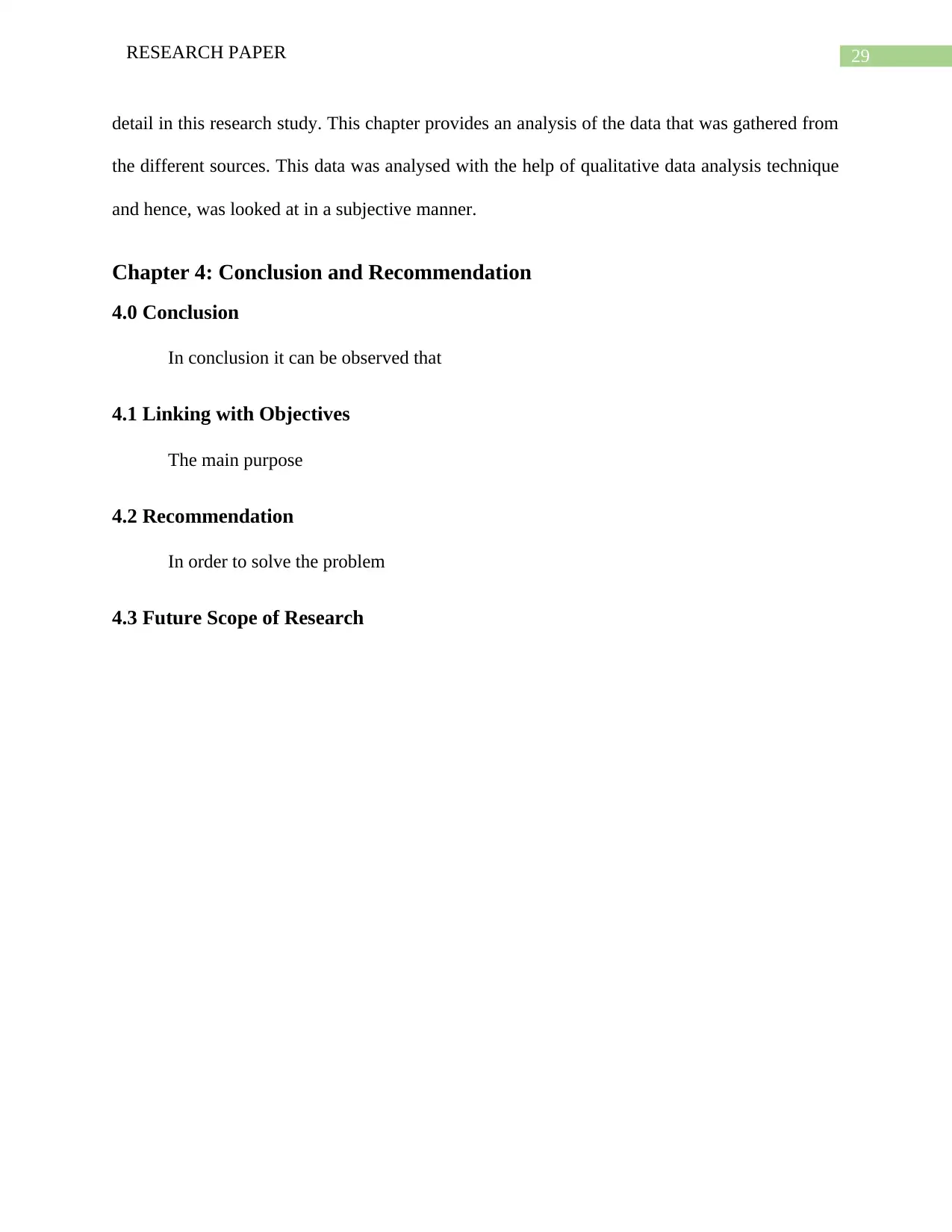
29RESEARCH PAPER
detail in this research study. This chapter provides an analysis of the data that was gathered from
the different sources. This data was analysed with the help of qualitative data analysis technique
and hence, was looked at in a subjective manner.
Chapter 4: Conclusion and Recommendation
4.0 Conclusion
In conclusion it can be observed that
4.1 Linking with Objectives
The main purpose
4.2 Recommendation
In order to solve the problem
4.3 Future Scope of Research
detail in this research study. This chapter provides an analysis of the data that was gathered from
the different sources. This data was analysed with the help of qualitative data analysis technique
and hence, was looked at in a subjective manner.
Chapter 4: Conclusion and Recommendation
4.0 Conclusion
In conclusion it can be observed that
4.1 Linking with Objectives
The main purpose
4.2 Recommendation
In order to solve the problem
4.3 Future Scope of Research
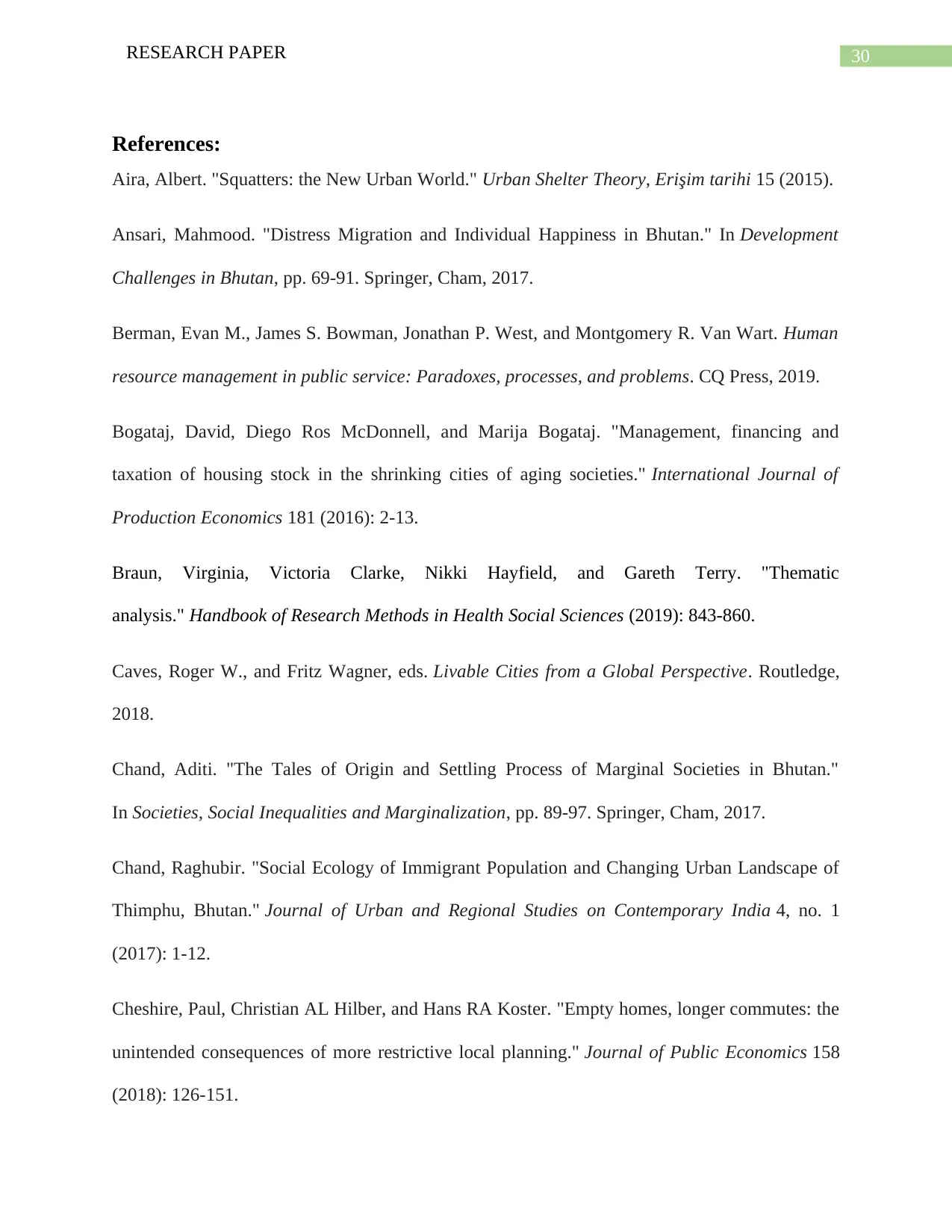
30RESEARCH PAPER
References:
Aira, Albert. "Squatters: the New Urban World." Urban Shelter Theory, Erişim tarihi 15 (2015).
Ansari, Mahmood. "Distress Migration and Individual Happiness in Bhutan." In Development
Challenges in Bhutan, pp. 69-91. Springer, Cham, 2017.
Berman, Evan M., James S. Bowman, Jonathan P. West, and Montgomery R. Van Wart. Human
resource management in public service: Paradoxes, processes, and problems. CQ Press, 2019.
Bogataj, David, Diego Ros McDonnell, and Marija Bogataj. "Management, financing and
taxation of housing stock in the shrinking cities of aging societies." International Journal of
Production Economics 181 (2016): 2-13.
Braun, Virginia, Victoria Clarke, Nikki Hayfield, and Gareth Terry. "Thematic
analysis." Handbook of Research Methods in Health Social Sciences (2019): 843-860.
Caves, Roger W., and Fritz Wagner, eds. Livable Cities from a Global Perspective. Routledge,
2018.
Chand, Aditi. "The Tales of Origin and Settling Process of Marginal Societies in Bhutan."
In Societies, Social Inequalities and Marginalization, pp. 89-97. Springer, Cham, 2017.
Chand, Raghubir. "Social Ecology of Immigrant Population and Changing Urban Landscape of
Thimphu, Bhutan." Journal of Urban and Regional Studies on Contemporary India 4, no. 1
(2017): 1-12.
Cheshire, Paul, Christian AL Hilber, and Hans RA Koster. "Empty homes, longer commutes: the
unintended consequences of more restrictive local planning." Journal of Public Economics 158
(2018): 126-151.
References:
Aira, Albert. "Squatters: the New Urban World." Urban Shelter Theory, Erişim tarihi 15 (2015).
Ansari, Mahmood. "Distress Migration and Individual Happiness in Bhutan." In Development
Challenges in Bhutan, pp. 69-91. Springer, Cham, 2017.
Berman, Evan M., James S. Bowman, Jonathan P. West, and Montgomery R. Van Wart. Human
resource management in public service: Paradoxes, processes, and problems. CQ Press, 2019.
Bogataj, David, Diego Ros McDonnell, and Marija Bogataj. "Management, financing and
taxation of housing stock in the shrinking cities of aging societies." International Journal of
Production Economics 181 (2016): 2-13.
Braun, Virginia, Victoria Clarke, Nikki Hayfield, and Gareth Terry. "Thematic
analysis." Handbook of Research Methods in Health Social Sciences (2019): 843-860.
Caves, Roger W., and Fritz Wagner, eds. Livable Cities from a Global Perspective. Routledge,
2018.
Chand, Aditi. "The Tales of Origin and Settling Process of Marginal Societies in Bhutan."
In Societies, Social Inequalities and Marginalization, pp. 89-97. Springer, Cham, 2017.
Chand, Raghubir. "Social Ecology of Immigrant Population and Changing Urban Landscape of
Thimphu, Bhutan." Journal of Urban and Regional Studies on Contemporary India 4, no. 1
(2017): 1-12.
Cheshire, Paul, Christian AL Hilber, and Hans RA Koster. "Empty homes, longer commutes: the
unintended consequences of more restrictive local planning." Journal of Public Economics 158
(2018): 126-151.
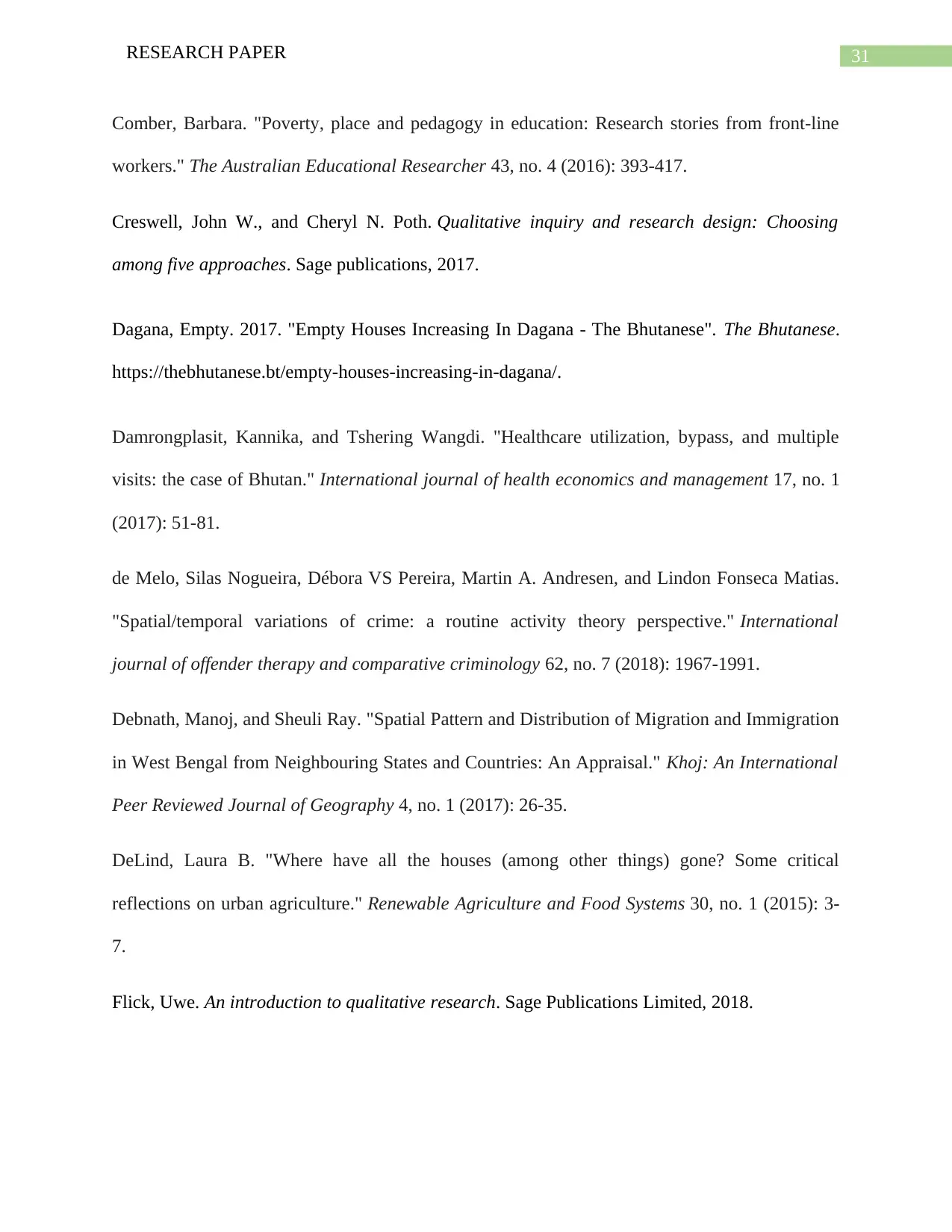
31RESEARCH PAPER
Comber, Barbara. "Poverty, place and pedagogy in education: Research stories from front-line
workers." The Australian Educational Researcher 43, no. 4 (2016): 393-417.
Creswell, John W., and Cheryl N. Poth. Qualitative inquiry and research design: Choosing
among five approaches. Sage publications, 2017.
Dagana, Empty. 2017. "Empty Houses Increasing In Dagana - The Bhutanese". The Bhutanese.
https://thebhutanese.bt/empty-houses-increasing-in-dagana/.
Damrongplasit, Kannika, and Tshering Wangdi. "Healthcare utilization, bypass, and multiple
visits: the case of Bhutan." International journal of health economics and management 17, no. 1
(2017): 51-81.
de Melo, Silas Nogueira, Débora VS Pereira, Martin A. Andresen, and Lindon Fonseca Matias.
"Spatial/temporal variations of crime: a routine activity theory perspective." International
journal of offender therapy and comparative criminology 62, no. 7 (2018): 1967-1991.
Debnath, Manoj, and Sheuli Ray. "Spatial Pattern and Distribution of Migration and Immigration
in West Bengal from Neighbouring States and Countries: An Appraisal." Khoj: An International
Peer Reviewed Journal of Geography 4, no. 1 (2017): 26-35.
DeLind, Laura B. "Where have all the houses (among other things) gone? Some critical
reflections on urban agriculture." Renewable Agriculture and Food Systems 30, no. 1 (2015): 3-
7.
Flick, Uwe. An introduction to qualitative research. Sage Publications Limited, 2018.
Comber, Barbara. "Poverty, place and pedagogy in education: Research stories from front-line
workers." The Australian Educational Researcher 43, no. 4 (2016): 393-417.
Creswell, John W., and Cheryl N. Poth. Qualitative inquiry and research design: Choosing
among five approaches. Sage publications, 2017.
Dagana, Empty. 2017. "Empty Houses Increasing In Dagana - The Bhutanese". The Bhutanese.
https://thebhutanese.bt/empty-houses-increasing-in-dagana/.
Damrongplasit, Kannika, and Tshering Wangdi. "Healthcare utilization, bypass, and multiple
visits: the case of Bhutan." International journal of health economics and management 17, no. 1
(2017): 51-81.
de Melo, Silas Nogueira, Débora VS Pereira, Martin A. Andresen, and Lindon Fonseca Matias.
"Spatial/temporal variations of crime: a routine activity theory perspective." International
journal of offender therapy and comparative criminology 62, no. 7 (2018): 1967-1991.
Debnath, Manoj, and Sheuli Ray. "Spatial Pattern and Distribution of Migration and Immigration
in West Bengal from Neighbouring States and Countries: An Appraisal." Khoj: An International
Peer Reviewed Journal of Geography 4, no. 1 (2017): 26-35.
DeLind, Laura B. "Where have all the houses (among other things) gone? Some critical
reflections on urban agriculture." Renewable Agriculture and Food Systems 30, no. 1 (2015): 3-
7.
Flick, Uwe. An introduction to qualitative research. Sage Publications Limited, 2018.
Paraphrase This Document
Need a fresh take? Get an instant paraphrase of this document with our AI Paraphraser
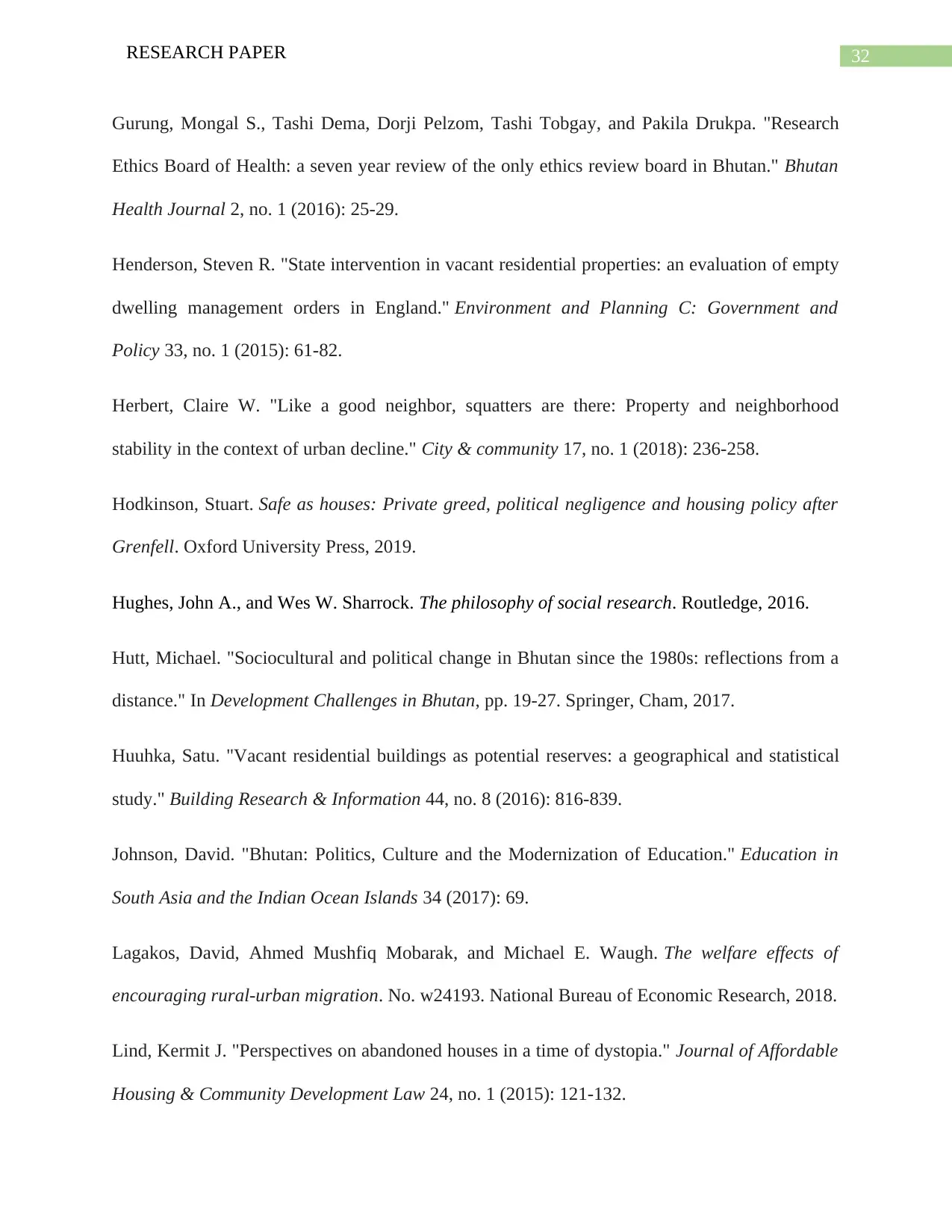
32RESEARCH PAPER
Gurung, Mongal S., Tashi Dema, Dorji Pelzom, Tashi Tobgay, and Pakila Drukpa. "Research
Ethics Board of Health: a seven year review of the only ethics review board in Bhutan." Bhutan
Health Journal 2, no. 1 (2016): 25-29.
Henderson, Steven R. "State intervention in vacant residential properties: an evaluation of empty
dwelling management orders in England." Environment and Planning C: Government and
Policy 33, no. 1 (2015): 61-82.
Herbert, Claire W. "Like a good neighbor, squatters are there: Property and neighborhood
stability in the context of urban decline." City & community 17, no. 1 (2018): 236-258.
Hodkinson, Stuart. Safe as houses: Private greed, political negligence and housing policy after
Grenfell. Oxford University Press, 2019.
Hughes, John A., and Wes W. Sharrock. The philosophy of social research. Routledge, 2016.
Hutt, Michael. "Sociocultural and political change in Bhutan since the 1980s: reflections from a
distance." In Development Challenges in Bhutan, pp. 19-27. Springer, Cham, 2017.
Huuhka, Satu. "Vacant residential buildings as potential reserves: a geographical and statistical
study." Building Research & Information 44, no. 8 (2016): 816-839.
Johnson, David. "Bhutan: Politics, Culture and the Modernization of Education." Education in
South Asia and the Indian Ocean Islands 34 (2017): 69.
Lagakos, David, Ahmed Mushfiq Mobarak, and Michael E. Waugh. The welfare effects of
encouraging rural-urban migration. No. w24193. National Bureau of Economic Research, 2018.
Lind, Kermit J. "Perspectives on abandoned houses in a time of dystopia." Journal of Affordable
Housing & Community Development Law 24, no. 1 (2015): 121-132.
Gurung, Mongal S., Tashi Dema, Dorji Pelzom, Tashi Tobgay, and Pakila Drukpa. "Research
Ethics Board of Health: a seven year review of the only ethics review board in Bhutan." Bhutan
Health Journal 2, no. 1 (2016): 25-29.
Henderson, Steven R. "State intervention in vacant residential properties: an evaluation of empty
dwelling management orders in England." Environment and Planning C: Government and
Policy 33, no. 1 (2015): 61-82.
Herbert, Claire W. "Like a good neighbor, squatters are there: Property and neighborhood
stability in the context of urban decline." City & community 17, no. 1 (2018): 236-258.
Hodkinson, Stuart. Safe as houses: Private greed, political negligence and housing policy after
Grenfell. Oxford University Press, 2019.
Hughes, John A., and Wes W. Sharrock. The philosophy of social research. Routledge, 2016.
Hutt, Michael. "Sociocultural and political change in Bhutan since the 1980s: reflections from a
distance." In Development Challenges in Bhutan, pp. 19-27. Springer, Cham, 2017.
Huuhka, Satu. "Vacant residential buildings as potential reserves: a geographical and statistical
study." Building Research & Information 44, no. 8 (2016): 816-839.
Johnson, David. "Bhutan: Politics, Culture and the Modernization of Education." Education in
South Asia and the Indian Ocean Islands 34 (2017): 69.
Lagakos, David, Ahmed Mushfiq Mobarak, and Michael E. Waugh. The welfare effects of
encouraging rural-urban migration. No. w24193. National Bureau of Economic Research, 2018.
Lind, Kermit J. "Perspectives on abandoned houses in a time of dystopia." Journal of Affordable
Housing & Community Development Law 24, no. 1 (2015): 121-132.
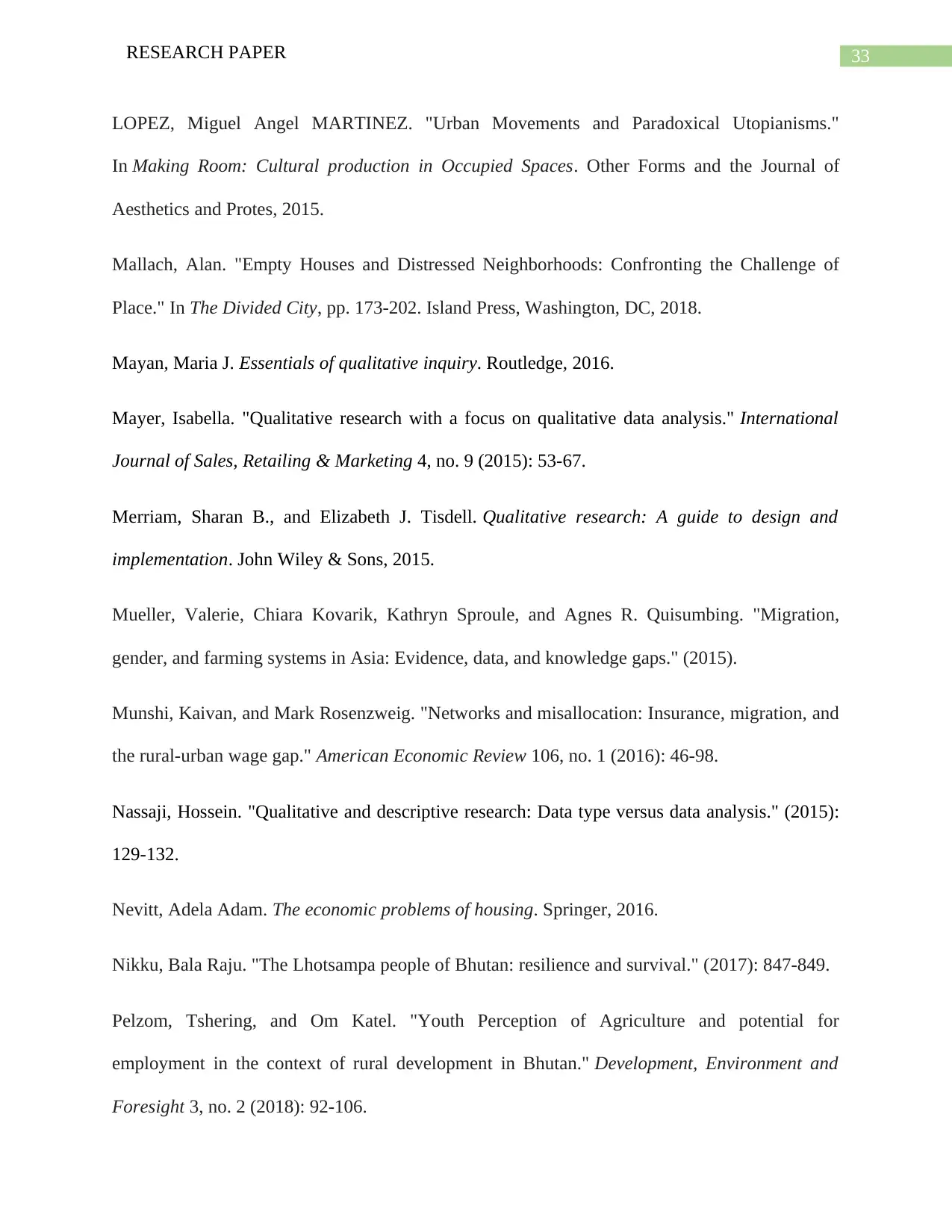
33RESEARCH PAPER
LOPEZ, Miguel Angel MARTINEZ. "Urban Movements and Paradoxical Utopianisms."
In Making Room: Cultural production in Occupied Spaces. Other Forms and the Journal of
Aesthetics and Protes, 2015.
Mallach, Alan. "Empty Houses and Distressed Neighborhoods: Confronting the Challenge of
Place." In The Divided City, pp. 173-202. Island Press, Washington, DC, 2018.
Mayan, Maria J. Essentials of qualitative inquiry. Routledge, 2016.
Mayer, Isabella. "Qualitative research with a focus on qualitative data analysis." International
Journal of Sales, Retailing & Marketing 4, no. 9 (2015): 53-67.
Merriam, Sharan B., and Elizabeth J. Tisdell. Qualitative research: A guide to design and
implementation. John Wiley & Sons, 2015.
Mueller, Valerie, Chiara Kovarik, Kathryn Sproule, and Agnes R. Quisumbing. "Migration,
gender, and farming systems in Asia: Evidence, data, and knowledge gaps." (2015).
Munshi, Kaivan, and Mark Rosenzweig. "Networks and misallocation: Insurance, migration, and
the rural-urban wage gap." American Economic Review 106, no. 1 (2016): 46-98.
Nassaji, Hossein. "Qualitative and descriptive research: Data type versus data analysis." (2015):
129-132.
Nevitt, Adela Adam. The economic problems of housing. Springer, 2016.
Nikku, Bala Raju. "The Lhotsampa people of Bhutan: resilience and survival." (2017): 847-849.
Pelzom, Tshering, and Om Katel. "Youth Perception of Agriculture and potential for
employment in the context of rural development in Bhutan." Development, Environment and
Foresight 3, no. 2 (2018): 92-106.
LOPEZ, Miguel Angel MARTINEZ. "Urban Movements and Paradoxical Utopianisms."
In Making Room: Cultural production in Occupied Spaces. Other Forms and the Journal of
Aesthetics and Protes, 2015.
Mallach, Alan. "Empty Houses and Distressed Neighborhoods: Confronting the Challenge of
Place." In The Divided City, pp. 173-202. Island Press, Washington, DC, 2018.
Mayan, Maria J. Essentials of qualitative inquiry. Routledge, 2016.
Mayer, Isabella. "Qualitative research with a focus on qualitative data analysis." International
Journal of Sales, Retailing & Marketing 4, no. 9 (2015): 53-67.
Merriam, Sharan B., and Elizabeth J. Tisdell. Qualitative research: A guide to design and
implementation. John Wiley & Sons, 2015.
Mueller, Valerie, Chiara Kovarik, Kathryn Sproule, and Agnes R. Quisumbing. "Migration,
gender, and farming systems in Asia: Evidence, data, and knowledge gaps." (2015).
Munshi, Kaivan, and Mark Rosenzweig. "Networks and misallocation: Insurance, migration, and
the rural-urban wage gap." American Economic Review 106, no. 1 (2016): 46-98.
Nassaji, Hossein. "Qualitative and descriptive research: Data type versus data analysis." (2015):
129-132.
Nevitt, Adela Adam. The economic problems of housing. Springer, 2016.
Nikku, Bala Raju. "The Lhotsampa people of Bhutan: resilience and survival." (2017): 847-849.
Pelzom, Tshering, and Om Katel. "Youth Perception of Agriculture and potential for
employment in the context of rural development in Bhutan." Development, Environment and
Foresight 3, no. 2 (2018): 92-106.
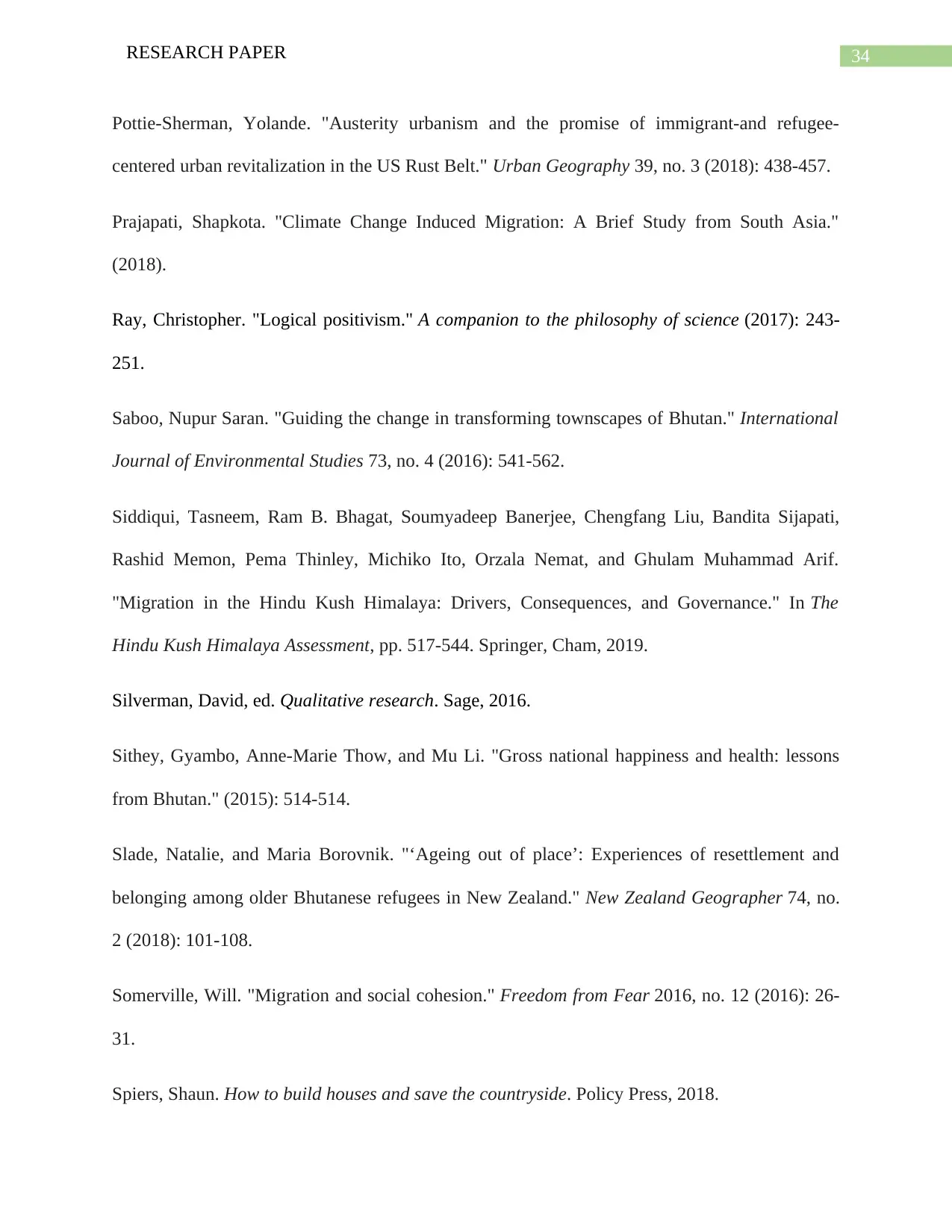
34RESEARCH PAPER
Pottie-Sherman, Yolande. "Austerity urbanism and the promise of immigrant-and refugee-
centered urban revitalization in the US Rust Belt." Urban Geography 39, no. 3 (2018): 438-457.
Prajapati, Shapkota. "Climate Change Induced Migration: A Brief Study from South Asia."
(2018).
Ray, Christopher. "Logical positivism." A companion to the philosophy of science (2017): 243-
251.
Saboo, Nupur Saran. "Guiding the change in transforming townscapes of Bhutan." International
Journal of Environmental Studies 73, no. 4 (2016): 541-562.
Siddiqui, Tasneem, Ram B. Bhagat, Soumyadeep Banerjee, Chengfang Liu, Bandita Sijapati,
Rashid Memon, Pema Thinley, Michiko Ito, Orzala Nemat, and Ghulam Muhammad Arif.
"Migration in the Hindu Kush Himalaya: Drivers, Consequences, and Governance." In The
Hindu Kush Himalaya Assessment, pp. 517-544. Springer, Cham, 2019.
Silverman, David, ed. Qualitative research. Sage, 2016.
Sithey, Gyambo, Anne-Marie Thow, and Mu Li. "Gross national happiness and health: lessons
from Bhutan." (2015): 514-514.
Slade, Natalie, and Maria Borovnik. "‘Ageing out of place’: Experiences of resettlement and
belonging among older Bhutanese refugees in New Zealand." New Zealand Geographer 74, no.
2 (2018): 101-108.
Somerville, Will. "Migration and social cohesion." Freedom from Fear 2016, no. 12 (2016): 26-
31.
Spiers, Shaun. How to build houses and save the countryside. Policy Press, 2018.
Pottie-Sherman, Yolande. "Austerity urbanism and the promise of immigrant-and refugee-
centered urban revitalization in the US Rust Belt." Urban Geography 39, no. 3 (2018): 438-457.
Prajapati, Shapkota. "Climate Change Induced Migration: A Brief Study from South Asia."
(2018).
Ray, Christopher. "Logical positivism." A companion to the philosophy of science (2017): 243-
251.
Saboo, Nupur Saran. "Guiding the change in transforming townscapes of Bhutan." International
Journal of Environmental Studies 73, no. 4 (2016): 541-562.
Siddiqui, Tasneem, Ram B. Bhagat, Soumyadeep Banerjee, Chengfang Liu, Bandita Sijapati,
Rashid Memon, Pema Thinley, Michiko Ito, Orzala Nemat, and Ghulam Muhammad Arif.
"Migration in the Hindu Kush Himalaya: Drivers, Consequences, and Governance." In The
Hindu Kush Himalaya Assessment, pp. 517-544. Springer, Cham, 2019.
Silverman, David, ed. Qualitative research. Sage, 2016.
Sithey, Gyambo, Anne-Marie Thow, and Mu Li. "Gross national happiness and health: lessons
from Bhutan." (2015): 514-514.
Slade, Natalie, and Maria Borovnik. "‘Ageing out of place’: Experiences of resettlement and
belonging among older Bhutanese refugees in New Zealand." New Zealand Geographer 74, no.
2 (2018): 101-108.
Somerville, Will. "Migration and social cohesion." Freedom from Fear 2016, no. 12 (2016): 26-
31.
Spiers, Shaun. How to build houses and save the countryside. Policy Press, 2018.
Secure Best Marks with AI Grader
Need help grading? Try our AI Grader for instant feedback on your assignments.
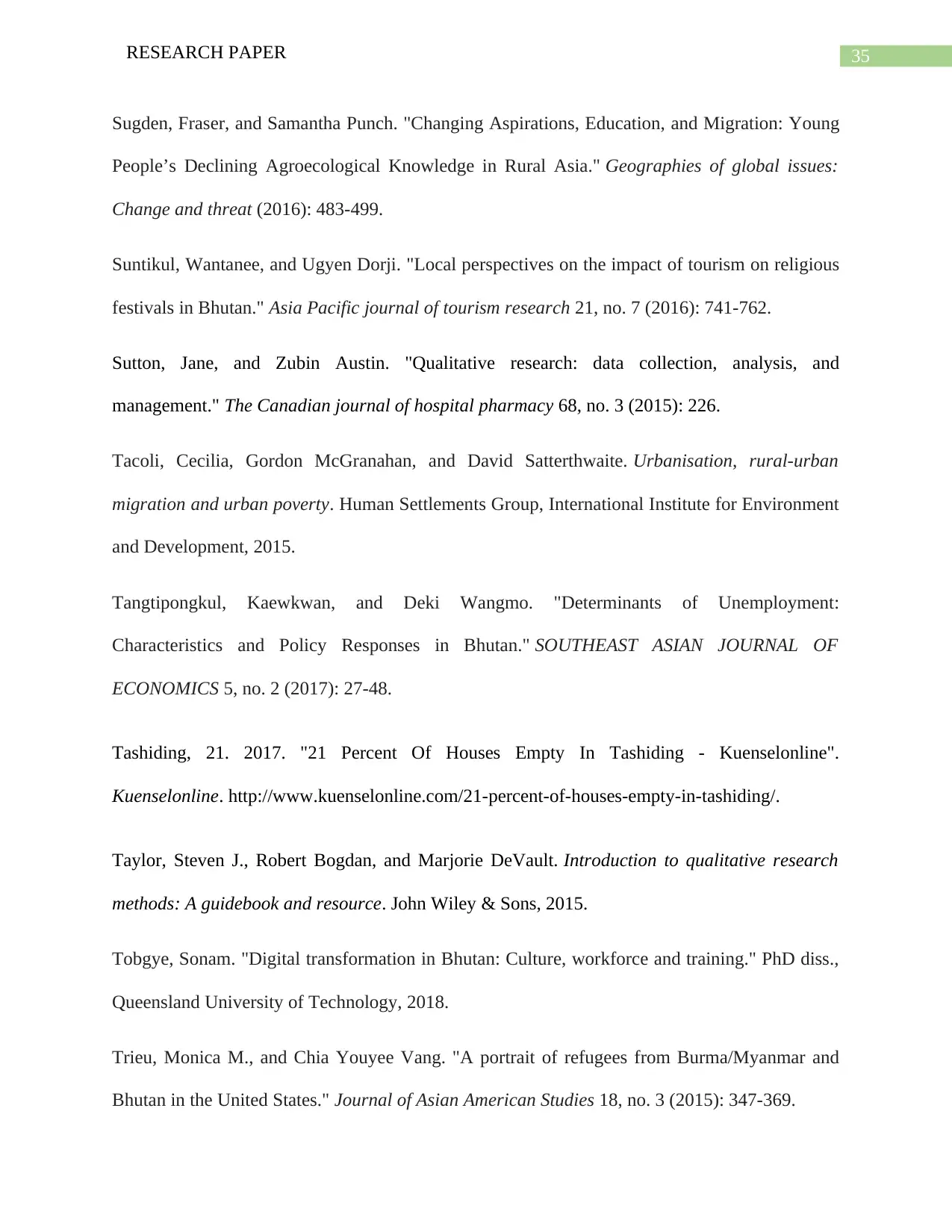
35RESEARCH PAPER
Sugden, Fraser, and Samantha Punch. "Changing Aspirations, Education, and Migration: Young
People’s Declining Agroecological Knowledge in Rural Asia." Geographies of global issues:
Change and threat (2016): 483-499.
Suntikul, Wantanee, and Ugyen Dorji. "Local perspectives on the impact of tourism on religious
festivals in Bhutan." Asia Pacific journal of tourism research 21, no. 7 (2016): 741-762.
Sutton, Jane, and Zubin Austin. "Qualitative research: data collection, analysis, and
management." The Canadian journal of hospital pharmacy 68, no. 3 (2015): 226.
Tacoli, Cecilia, Gordon McGranahan, and David Satterthwaite. Urbanisation, rural-urban
migration and urban poverty. Human Settlements Group, International Institute for Environment
and Development, 2015.
Tangtipongkul, Kaewkwan, and Deki Wangmo. "Determinants of Unemployment:
Characteristics and Policy Responses in Bhutan." SOUTHEAST ASIAN JOURNAL OF
ECONOMICS 5, no. 2 (2017): 27-48.
Tashiding, 21. 2017. "21 Percent Of Houses Empty In Tashiding - Kuenselonline".
Kuenselonline. http://www.kuenselonline.com/21-percent-of-houses-empty-in-tashiding/.
Taylor, Steven J., Robert Bogdan, and Marjorie DeVault. Introduction to qualitative research
methods: A guidebook and resource. John Wiley & Sons, 2015.
Tobgye, Sonam. "Digital transformation in Bhutan: Culture, workforce and training." PhD diss.,
Queensland University of Technology, 2018.
Trieu, Monica M., and Chia Youyee Vang. "A portrait of refugees from Burma/Myanmar and
Bhutan in the United States." Journal of Asian American Studies 18, no. 3 (2015): 347-369.
Sugden, Fraser, and Samantha Punch. "Changing Aspirations, Education, and Migration: Young
People’s Declining Agroecological Knowledge in Rural Asia." Geographies of global issues:
Change and threat (2016): 483-499.
Suntikul, Wantanee, and Ugyen Dorji. "Local perspectives on the impact of tourism on religious
festivals in Bhutan." Asia Pacific journal of tourism research 21, no. 7 (2016): 741-762.
Sutton, Jane, and Zubin Austin. "Qualitative research: data collection, analysis, and
management." The Canadian journal of hospital pharmacy 68, no. 3 (2015): 226.
Tacoli, Cecilia, Gordon McGranahan, and David Satterthwaite. Urbanisation, rural-urban
migration and urban poverty. Human Settlements Group, International Institute for Environment
and Development, 2015.
Tangtipongkul, Kaewkwan, and Deki Wangmo. "Determinants of Unemployment:
Characteristics and Policy Responses in Bhutan." SOUTHEAST ASIAN JOURNAL OF
ECONOMICS 5, no. 2 (2017): 27-48.
Tashiding, 21. 2017. "21 Percent Of Houses Empty In Tashiding - Kuenselonline".
Kuenselonline. http://www.kuenselonline.com/21-percent-of-houses-empty-in-tashiding/.
Taylor, Steven J., Robert Bogdan, and Marjorie DeVault. Introduction to qualitative research
methods: A guidebook and resource. John Wiley & Sons, 2015.
Tobgye, Sonam. "Digital transformation in Bhutan: Culture, workforce and training." PhD diss.,
Queensland University of Technology, 2018.
Trieu, Monica M., and Chia Youyee Vang. "A portrait of refugees from Burma/Myanmar and
Bhutan in the United States." Journal of Asian American Studies 18, no. 3 (2015): 347-369.

36RESEARCH PAPER
Ueda, Akiko. "Rural Life and Modern Formal Schooling in Bhutan." In Education in Bhutan, pp.
127-137. Springer, Singapore, 2016.
Ueda, Akiko. "Rural Life and Modern Formal Schooling in Bhutan." In Education in Bhutan, pp.
127-137. Springer, Singapore, 2016.

37RESEARCH PAPER
1 out of 37
Related Documents
Your All-in-One AI-Powered Toolkit for Academic Success.
+13062052269
info@desklib.com
Available 24*7 on WhatsApp / Email
![[object Object]](/_next/static/media/star-bottom.7253800d.svg)
Unlock your academic potential
© 2024 | Zucol Services PVT LTD | All rights reserved.





